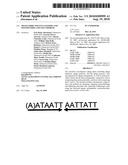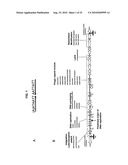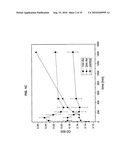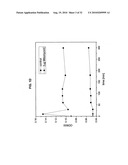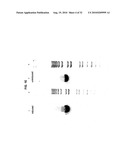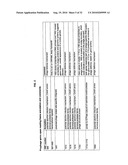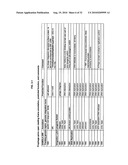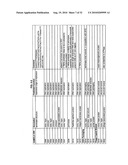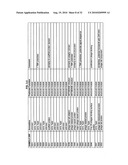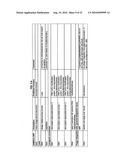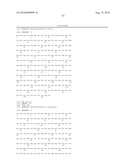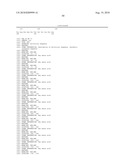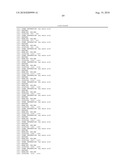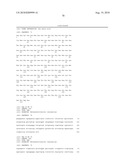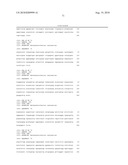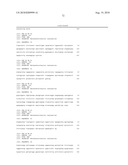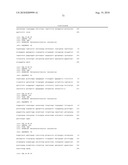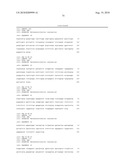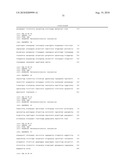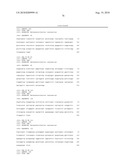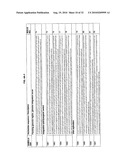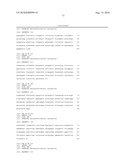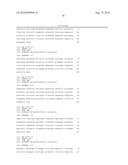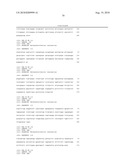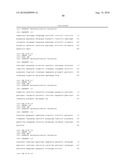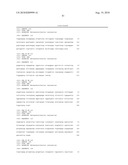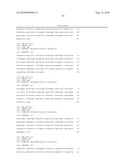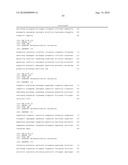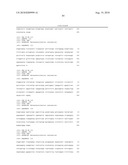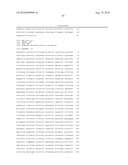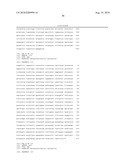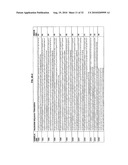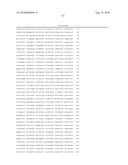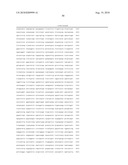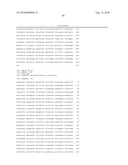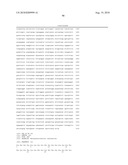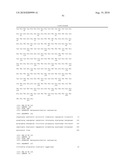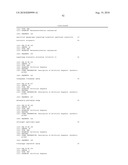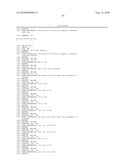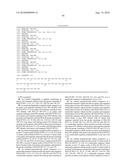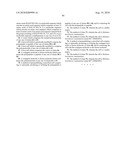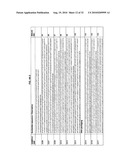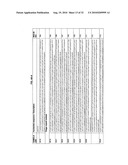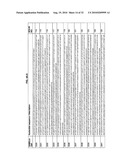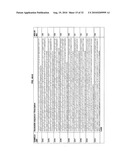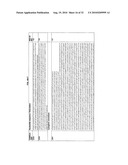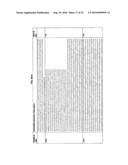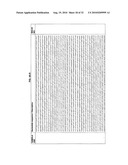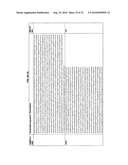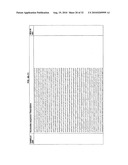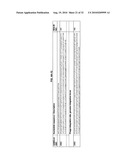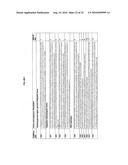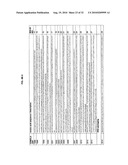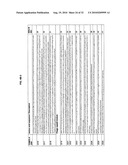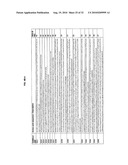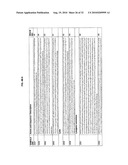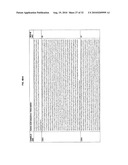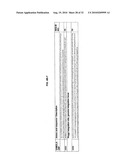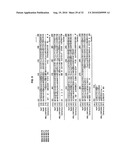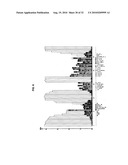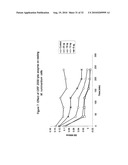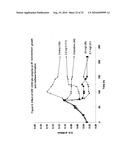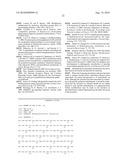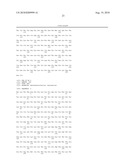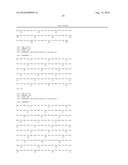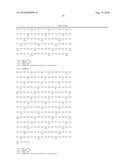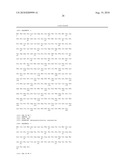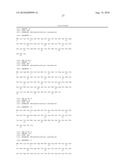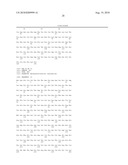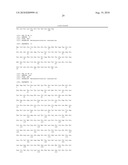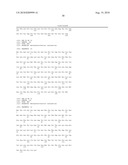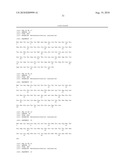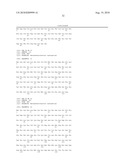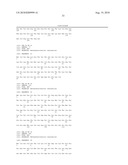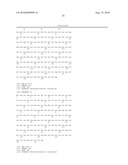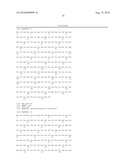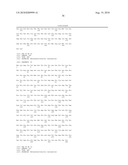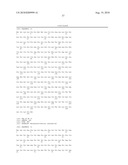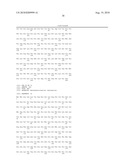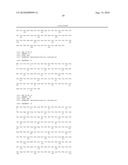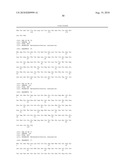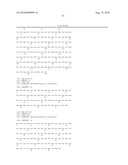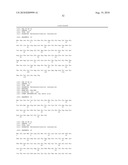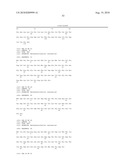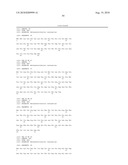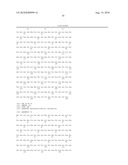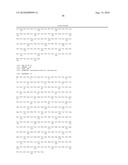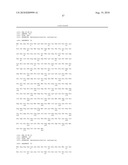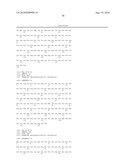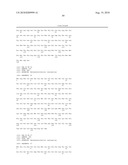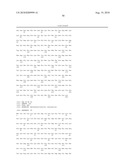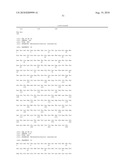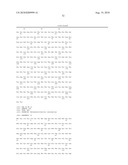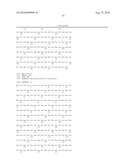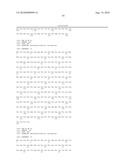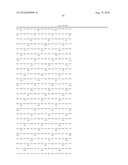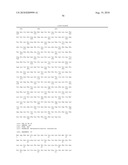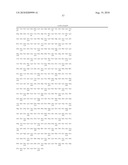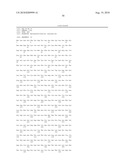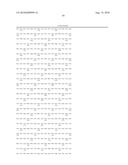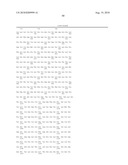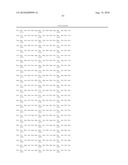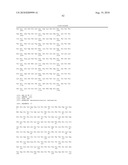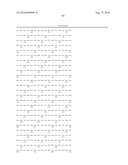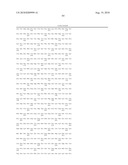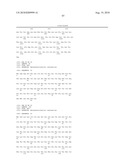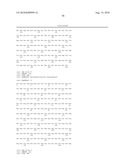Patent application title: PHAGE OMRU POLYNUCLEOTIDES AND POLYPEPTIDES AND USES THEREOF
Inventors:
Eric Heinz Altermann (Palmerston North, NZ)
Graeme Trevor Attwood (Ashhurst, NZ)
Sinead Christine Leahy (Palmerston North, NZ)
William John Kelly (Ashhurst, NZ)
Robert Srarr Ronimus (Palmerston North, NZ)
Dong Li (Palmerston North, NZ)
Shanhao Kong (Shanghai, CN)
Linley Rose Schofield (Palmerston North, NZ)
Debjit Dey (Palmerston North, NZ)
Catherine Mary Tootill (Palmerston North, NZ)
Carrie Sang (Palmerston North, NZ)
Christina Diane Moon (Palmerston North, NZ)
Petrus Hendricus Janssen (Palmerston North, NZ)
IPC8 Class: AC12N120FI
USPC Class:
4352523
Class name: Micro-organism, per se (e.g., protozoa, etc.); compositions thereof; proces of propagating, maintaining or preserving micro-organisms or compositions thereof; process of preparing or isolating a composition containing a micro-organism; culture media therefor bacteria or actinomycetales; media therefor transformants (e.g., recombinant dna or vector or foreign or exogenous gene containing, fused bacteria, etc.)
Publication date: 2010-08-19
Patent application number: 20100209999
Claims:
1.-57. (canceled)
58. An isolated polypeptide or peptide comprising an amino acid sequence selected from the group consisting of SEQ ID NO: 1-116, 117, 118, 119, 120-136, and 138-172.
59. An isolated polypeptide or peptide which comprises: a) an amino acid sequence sharing at least 90% identity with SEQ ID NO:117; b) an amino acid sequence sharing at least 95% identity with SEQ ID NO:118; c) an amino acid sequence sharing at least 90% identity with SEQ ID NO:119; d) an amino acid sequence sharing at least 90% identity with an amino acid sequence selected from the group consisting of SEQ ID NO:1-31, 33-104, 106-112, 114-116, 120-136, and 138-172; e) an amino acid sharing at least 95% identity with an amino acid sequence selected from the group consisting of SEQ ID NO:105 and 113; or f) an amino acid sharing at least 98% identity with amino acid sequence SEQ ID NO:32.
60. An isolated polypeptide or peptide which comprises: a) at least 15 amino acids of SEQ ID NO:117 or 118; b) at least 15 amino acids of SEQ ID NO:119; c) at least 15 amino acids of an amino acid sequence selected from the group consisting of SEQ ID NO:1-31, 34-73, 75-104, 106-112, 114-116, 120-132, 134-136, and 138-172; d) at least 17 amino acids SEQ ID NO:105; e) at least 19 amino acids of SEQ ID NO:74; or f) at least 22 amino acids of an amino acid sequence selected from the group consisting of SEQ ID NO:33, 113, and 133.
61. An isolated polynucleotide which comprises: a) a nucleotide sequence which encodes the amino acid sequence SEQ ID NO: 1-116, 117, 118, 119, 120-136, and 138-172; b) a nucleotide sequence selected from the group consisting of SEQ ID NO: 173-341, 342-510, 511, 512, and 513; or c) a nucleotide sequence complementary to (a) or (b).
62. An isolated polynucleotide which comprises: a) a nucleotide sequence which encodes an amino acid sequence which shares at least 90% identity with SEQ ID NO:117; b) a nucleotide sequence which encodes an amino acid sequence which shares at least 95% identity with SEQ ID NO:118; c) a nucleotide sequence which encodes an amino acid sequence which shares at least 90% identity with SEQ ID NO:119; d) a nucleotide sequence which encodes an amino acid sequence which shares at least 90% identity with an amino acid sequence selected from the group consisting of SEQ ID NO:1-31, 33-104, 106-112, 114-116, 120-136, and 138-172; e) a nucleotide sequence which encodes an amino acid sharing at least 95% identity with an amino acid sequence selected from the group consisting of SEQ ID NO:105 and 113; f) a nucleotide sequence which encodes an amino acid sharing at least 98% identity with amino acid sequence SEQ ID NO:32; or g) a nucleotide sequence complementary to any one of (a) to (f).
63. An isolated polynucleotide which comprises: a) a nucleotide sequence which encodes at least 15 amino acids of SEQ ID NO:117 or 118; b) a nucleotide sequence which encodes at least 15 amino acids of SEQ ID NO:119; c) a nucleotide sequence which encodes at least 15 amino acids of an amino acid sequence selected from the group consisting of SEQ ID NO:1-31, 34-73, 75-104, 106-112, 114-116, 120-132, 134-136, 138-172; d) a nucleotide sequence which encodes an amino acid sequence which comprises at least 17 amino acids SEQ ID NO:105; e) a nucleotide sequence which encodes an amino acid sequence which comprises at least 19 amino acids of SEQ ID NO:74; f) a nucleotide sequence which encodes an amino acid sequence which comprises at least 22 amino acids of an amino acid sequence selected from the group consisting of SEQ ID NO:33, 113, and 133; or g) a nucleotide sequence complementary to any one of (a) to (f).
64. A vector which comprises the isolated polynucleotide of any one of claims 61 to 63.
65. A host cell which is genetically modified to express the polypeptide or peptide of any one of claims 58 to 60.
66. A host cell which is genetically modified to comprise the polynucleotide of any one of claims 61 to 63.
67. A host cell which comprises the vector of claim 64.
68. A conjugate molecule or fusion molecule which comprises the polypeptide or peptide of any one of claims 58 to 60.
69. A conjugate molecule or fusion molecule which comprises the polynucleotide of any one of claims 61 to 63.
70. A method of permeabilising a microbial cell comprising: a) optionally, producing or isolating the polypeptide or peptide of any one of claims 58 to 60; and b) contacting the cell with the polypeptide or peptide.
71. The method of claim 70, wherein the cell is a methanogen.
72. The method of claim 71, wherein the cell is Methanobrevibacter ruminantium.
73. The method of claim 72, wherein the cell is Methanobrevibacter ruminantium strain M1.sup.T (DSM1093).
74. A method of permeabilising a microbial cell comprising: a) optionally, producing or isolating the conjugate molecule or fusion molecule of claim 68; and b) contacting the cell with the conjugate molecule or the fusion molecule.
75. The method of claim 74, wherein the cell is a methanogen.
76. The method of claim 75, wherein the cell is Methanobrevibacter ruminantium.
77. The method of claim 76, wherein the cell is Methanobrevibacter ruminantium strain M1.sup.T (DSM1093).
Description:
RELATED APPLICATIONS
[0001]This application claims the benefit of U.S. Application No. 60/975,104, filed Sep. 25, 2007, U.S. Application No. 60/989,840, filed Nov. 22, 2007, and U.S. Application No. 60/989,841, filed Nov. 22, 2007, the contents of all of which are hereby incorporated herein by reference in their entirety.
FIELD OF THE INVENTION
[0002]The invention relates to compositions and methods for delivering inhibitory molecules into microbial cells, in particular, methanogen cells. Specifically, the invention relates to newly identified phage φmru, including phage induction, phage particles, and the phage genome, and also phage polypeptides, as well as polynucleotides which encode these polypeptides. The invention also relates to expression vectors and host cells for producing these polypeptides. The invention further relates to methods for detecting, targeting, and inhibiting microbial cells, especially methanogen cells, using the disclosed phage, polypeptides, polynucleotides, expression vectors, and host cells.
BACKGROUND OF THE INVENTION
[0003]In New Zealand, agricultural activity accounts for the majority of greenhouse gas emissions. Therefore, reducing agricultural emissions of greenhouse gases is important for meeting New Zealand's obligations under the Kyoto Protocol. The Protocol requires reduction of greenhouse gases to 1990 levels by the end of the first commitment period (2008-2012). To this end, agricultural sector groups and the New Zealand government established the Pastoral Greenhouse Gas Research Consortium (PGGRC) to identify means for reducing New Zealand's agricultural greenhouse gas emissions.
[0004]An important part of the PGGRC's activities has been research into reducing methane emissions from New Zealand's grazing ruminants. Mitigating methane emissions from ruminants is of commercial interest for two reasons. First, failure to meet commitments under the Kyoto Protocol will force the government to purchase carbon credits. This is currently estimated to cost $350 million. Second, methane production results in the loss of 8-12% of the gross energy produced in the rumen. This energy could be used, instead, to improve ruminant productivity.
[0005]Methane is produced in the rumen by microbes called methanogens which are part of the phylum Euryarchaeota within the kingdom Archaea. Most methanogens grow on CO2 and H2 as their sole energy source, but some can use acetate or methyl compounds for growth. Several different genera of methanogenic archaea exist in the rumen, but species of the genus Methanobrevibacter, especially M. ruminantium, and M. smithii are thought to be the predominant methanogens in New Zealand ruminants. M. ruminantium is currently the subject of a genome sequencing project funded by the PGGRC. The project is the first genome sequencing of a rumen methanogen and it aims to build a better understanding of the biology of Methanobrevibacter to discover targets for inhibition of methane formation.
[0006]Reducing methane production in the rumen requires the inhibition of methanogens or the inactivation of their methanogenesis pathway. A means of inhibiting methane production is to deliver specific inhibitory molecules into methanogen cells. This may be achieved, for example, by use of agents, such as bacteriophage, which specifically target methanogens. Several phage have been characterised for non-rumen methanogens but there have been no published accounts of phage able to infect or lyse rumen methanogens. Therefore, it would be highly advantageous to identify phage that have the ability to infect methanogen cells and/or deliver inhibitors.
SUMMARY OF THE INVENTION
[0007]The invention features an isolated phage φmru, including a phage particle and/or phage genome, produced in whole or in part, as well as isolated polynucleotides and polypeptides of the phage as described in detail herein.
[0008]The invention also features an isolated polypeptide comprising at least one phage amino acid sequence selected from the group consisting of SEQ ID NO:1-69. In a particular aspect, the polypeptide comprises the amino acid sequence selected from the group consisting of SEQ ID NO:2-5 and 62-68. In a further aspect, the polypeptide comprises the amino acid sequence of SEQ ID NO:63. In another aspect, the polypeptide is a fragment, for example, comprising at least one amino acid sequence extending from residues 32-186 of SEQ ID NO:63.
[0009]The invention additionally features an isolated polynucleotide comprising a coding sequence for at least one phage polypeptide. In one aspect, the polynucleotide comprises a coding sequence for at least one amino acid sequence selected from the group consisting of SEQ ID NO:1-69. In a particular aspect, the polynucleotide comprises a coding sequence for a sequence selected from the group consisting of SEQ ID NO:2-5 and 62-68. In a further aspect, the polynucleotide comprises a coding sequence for SEQ ID NO:63. In another aspect, the polynucleotide comprises a fragment of a coding sequence, for example, least one amino acid sequence extending from residues 32-186 of SEQ ID NO:63.
[0010]In an additional aspect, the invention features an isolated polynucleotide comprising a phage nucleic acid sequence selected from the group consisting of SEQ ID NO:74-142. In a particular aspect, the polynucleotide comprises a nucleic acid sequence selected from the group consisting of SEQ ID NO:75-78 and 135-141, or is particularly, SEQ ID NO:136. In another aspect, the polynucleotide is a fragment or an oligonucleotide comprising, for example, the nucleic acid sequence extending from nucleotides 94-558 of SEQ ID NO:136. In addition, the invention encompasses an isolated polynucleotide, or fragment thereof, which hybridizes to any one of the nucleic acid sequences of SEQ ID NO:74-142. The invention further encompasses an isolated polynucleotide comprising the complement, reverse complement, reverse sequence, or fragments thereof, of any one of the nucleic acid sequences.
[0011]The invention features an expression vector comprising a polynucleotide comprising a coding sequence for at least one phage polypeptide. In one aspect, the expression vector comprises a coding sequence for at least one amino acid sequence selected from the group consisting of SEQ ID NO:1-69. In a particular aspect, the expression vector comprises a coding sequence for at least one amino acid sequence of SEQ ID NO:2-5 and 62-68. In a further aspect, the expression vector comprises a coding sequence for at least one amino acid sequence of SEQ ID NO:63. In another aspect, the expression vector comprises a coding sequence for at least one amino acid sequence extending from residues 32-186 of SEQ ID NO:63.
[0012]As a specific aspect, the invention features an expression vector which produces phage φmru, in whole or in part, as described in detail herein. In particular, the expression vector may produce phage particles, a phage genome, or modified phage, including any alterations, derivatives, variants, or fragments thereof.
[0013]The invention also features a host cell, for example, a microbial host cell, comprising at least one expression vector.
[0014]The invention specifically features an antibody raised to a polypeptide or polynucleotide as disclosed herein. In certain aspects, the antibody is directed to at least one polypeptide sequence selected from the group consisting of SEQ ID NO:1-69, or a modified sequence thereof. In alternate aspects, the antibody is raised to at least a fragment of a polynucleotide selected from the group consisting of SEQ ID NO:74-142, or a complement; or modified sequence thereof. In another aspect, the antibody includes one or more fusions or conjugates with at least one cell inhibitor, for example, anti-methanogenesis compounds (e.g., bromoethanesulphonic acid), antibodies and antibody fragments, lytic enzymes, peptide nucleic acids, antimicrobial peptides, and other antibiotics as described in detail herein.
[0015]The invention additionally features modified phage polypeptides, e.g., for at least one of SEQ ID NO:1-69, including biologically active alterations, fragments, variants, and derivatives, described herein. The invention additionally features modified antibodies, e.g., directed to at least one of SEQ ID NO:1-69, including biologically active alterations, fragments, variants, and derivatives, described herein. Also featured are polynucleotides encoding these modified polypeptides, as well as alterations, fragments, variants, and derivatives of the disclosed polynucleotides, expression vectors comprising these polynucleotides, and host cells comprising these vectors. In specific aspects, the compositions and methods of the invention employ these modified polynucleotides or polypeptides, or corresponding expression vectors or host cells.
[0016]In addition, the invention features phage polypeptides, e.g., at least one of SEQ ID NO:1-69 or modified sequences thereof, which include fusions or conjugates with at least one cell inhibitor, for example, anti-methanogenesis compounds (e.g., bromoethanesulphonic acid), antibodies and antibody fragments, lytic enzymes, peptide nucleic acids, antimicrobial peptides, and other antibiotics as described in detail herein.
[0017]The invention features a composition comprising an isolated polypeptide, e.g., at least one of SEQ ID NO:1-69, or a modified sequence thereof. The invention additionally features a composition comprising an antibody, e.g., directed to at least one of SEQ ID NO:1-69, or a modified sequence thereof. Also featured is a composition comprising an isolated polynucleotide, e.g., at least one of SEQ ID NO:74-142, or a complement or modified sequence thereof. Further featured is a composition that includes an expression vector, or host cell comprising an expression vector, in accordance with the invention. The composition can include any one of the biologically active alterations, fragments, variants, and derivatives described herein. The compositions can include at least one cell inhibitor (e.g., as a fusion or conjugate), and can be formulated, for example, as pharmaceutical compositions or as food supplements, in particular, ruminant feed components.
[0018]The invention also features a composition of the invention as part of a kit for targeting and/or inhibiting microbial cells, especially methanogen cells, in accordance with the disclosed methods. The kits comprise: a) at least one composition as set out herein; and b) optionally, instructions for use, for example, in targeting cells or inhibiting cell growth or replication for methanogens or other microbes.
[0019]The invention features a method for producing a phage, the method comprising: a) culturing an expression vector or host cell comprising an expression vector, which comprises at least part of the phage genome under conditions suitable for the production of the phage; and b) recovering the phage from the culture. In particular aspects, the phage comprises at least one polypeptide selected from the group consisting of SEQ ID NO:1-69, or modified sequences thereof. In further aspects, the phage comprises at least one polynucleotide selected from the group consisting of SEQ ID NO:74-142, or modified sequences thereof.
[0020]The invention also features a method for producing a phage polypeptide, the method comprising: a) culturing an expression vector or host cell comprising an expression vector, which comprises at least part of a coding sequence for at least one phage polypeptide under conditions suitable for the expression of the polypeptide; and b) recovering the polypeptide from the culture. In particular aspects, the polypeptide comprises at least one amino acid sequence selected from the group consisting of SEQ ID NO:1-69, or modified sequences thereof.
[0021]The invention additionally features a method for producing a phage polypeptide, e.g., for at least one of SEQ ID NO:1-69, which comprises a fusion or conjugate with at least one cell inhibitor, for example, anti-methanogenesis compounds (e.g., bromoethanesulphonic acid), antibodies and antibody fragments, lytic enzymes, peptide nucleic acids, antimicrobial peptides, and other antibiotics as described in detail herein. Such method comprises: a) culturing an expression vector or host cell comprising an expression vector, which comprises a coding sequence for at least one phage polypeptide under conditions suitable for the expression of the polypeptide; b) forming the phage fusion or conjugate (e.g., by expression of the fused sequence or chemical conjugation to the cell inhibitor); and c) recovering the fusion or conjugate. In particular aspects, the polypeptide comprises at least one amino acid sequence selected from the group consisting of SEQ ID NO:1-69, or modified sequences thereof.
[0022]In addition, the invention features a method of inhibiting (e.g., inhibiting growth or replication) of a microbial cell, in particular, a methanogen cell, comprising: a) optionally, producing or isolating at least one phage polypeptide; and b) contacting the cell with the phage polypeptide. In a particular aspect, the polypeptide comprises at least one amino acid sequence selected from the group consisting of SEQ ID NO:1-69, or a modified sequence thereof.
[0023]As an added feature, the invention encompasses a method of inhibiting (e.g., inhibiting growth or replication) of a microbial cell, in particular, a methanogen cell, comprising: a) optionally, producing or isolating at least one phage polypeptide, which further comprises at least one cell inhibitor; and b) contacting the cell with the phage polypeptide. In a particular aspect, the polypeptide comprises at least one amino acid sequence selected from the group consisting of SEQ ID NO:1-69, or a modified sequence thereof.
[0024]The invention also features a method of detecting and/or measuring the levels of a phage, or a corresponding phage polypeptide or polynucleotide, comprising: 1) contacting a sample from a subject with an antibody raised to a phage polypeptide (e.g., at least one of SEQ ID NO:1-69, or a modified sequence thereof) or a corresponding polynucleotide; and 2) determining the presence or levels of the antibody complex formed with the polypeptide or polynucleotide in the sample. Such methods can also be used for detecting and/or measuring the levels of a microbial cell, in particular, a methanogen cell.
[0025]The invention features, as well, a method of detecting and/or measuring the levels of a phage, or a corresponding phage polynucleotide (e.g., a phage coding sequence), comprising: 1) contacting a sample from a subject with a complementary polynucleotide (e.g., a sequence complementary to any one of SEQ ID NO:74-142, or modified sequence thereof); and 2) determining the presence or levels of the hybridization complex formed with the phage polynucleotide in the sample. Such methods can also be used for detecting and/or measuring the levels of a microbial cell, in particular, a methanogen cell.
[0026]In particular aspects, the methods of the invention utilize in vivo or in vitro expression components. In other aspects, the methods employ polypeptides produced by recombinant, synthetic, or semi-synthetic means, or polypeptides produced by endogenous means.
[0027]Other aspects and embodiments of the invention are described herein below.
BRIEF DESCRIPTION OF THE DRAWINGS
[0028]This invention is described with reference to specific embodiments thereof and with reference to the figures.
[0029]FIGS. 1A-1B. M. ruminantium prophage φmru showing putative integration site sequences attL and attR (FIG. 1A), and predicted phage functional modules and gene structure (FIG. 1B).
[0030]FIG. 1C: Phage induction using sterile air (oxygen stress).
[0031]FIG. 1D: Initial phage induction using MitomycinC.
[0032]FIG. 1E: Agarose gel electrophoresis of PCR amplicons of induced (oxygen challenge) and uninduced M. ruminantium. Lanes 2 and 4: 1 kb DNA marker ladder by Invitrogen. Lanes 1 and 3 represent PCRs using primer-pair R1F-L2R on DNA isolated from induced and uninduced M. ruminantium cultures, respectively.
[0033]FIG. 2. Prophage φmru open reading frame annotation and comments.
[0034]FIG. 3. Prophage φmru open reading frame annotation, predicted function, and comments.
[0035]FIGS. 4A-4B. M. ruminantium prophage φmru sequence information, including coding sequences of phage φmru (FIG. 4A), and amino acid sequences of phage φmru (FIG. 4B).
[0036]FIG. 5. Sequence alignment of phage φmru ORF 2058 with PeiP from M. marburgensis and PeiW from M. wolfeii.
[0037]FIG. 6: Protein sequence logo of signal peptide sequences from M. ruminantium created using LogoBar, showing the core consensus signal.
[0038]FIG. 7: Inhibitory effect of ORF 2058 on resting M. ruminantium cells.
[0039]FIG. 8: Inhibitory effect of ORF 2058 on M. ruminantium cell growth and methane production.
DETAILED DESCRIPTION OF THE INVENTION
Definitions
[0040]"Altered" nucleic acid sequences encoding phage polypeptides, as used herein, include those with deletions, insertions, or substitutions of different nucleotides resulting in a polynucleotide that preferably encodes the same or functionally equivalent polypeptides. The encoded polypeptide or antibody may also be "altered" and contain deletions, insertions, or substitutions of amino acid residues which produce a silent change and result in a functionally equivalent polypeptide. Deliberate amino acid substitutions may be made on the basis of similarity in polarity, charge, solubility, hydrophobicity, hydrophilicity, and/or the amphipathic nature of the residues as long as the biological activity (e.g., cell association, cell permeabilisation, or cell lysis) or immunological activity (e.g., one or more antibody binding sites) of the polypeptide is retained. For example, negatively charged amino acids may include aspartic acid and glutamic acid; positively charged amino acids may include lysine and arginine; and amino acids with uncharged polar head groups having similar hydrophilicity values may include leucine, isoleucine, and valine, glycine and alanine, asparagine and glutamine, serine and threonine, and phenylalanine and tyrosine.
[0041]"Amino acid sequence", as used herein, refers to an oligopeptide, peptide, polypeptide, or protein sequence, and any fragment thereof, and to naturally occurring, recombinant, synthetic, or semi-synthetic molecules. The sequences of the invention comprise at least 5, 10, 15, 20, 25, 30, 35, 40, 45, 50, 100, 150, 200, 250 amino acids, preferably at least 5 to 10, 10 to 20, 20 to 30, 30 to 40, 40 to 50, 50 to 100, 100 to 150, 150 to 200, or 200 to 250, or 250 to 4000 amino acids, and, preferably, retain the biological activity (e.g., cell association, cell permeabilisation, or cell lysis) or the immunological activity (e.g., one or more antibody binding sites) of the original sequence. Where "amino acid sequence" is recited herein to refer to an amino acid sequence of a naturally occurring polypeptide molecule, amino acid sequence, and like terms, are not meant to limit the amino acid sequence to the complete, original amino acid sequence associated with the full-length molecule.
[0042]"Amplification", as used herein, refers to the production of additional copies of a nucleic acid sequence and is generally carried out using polymerase chain reaction (PCR) technologies well known in the art (Dieffenbach, C. W. and G. S. Dveksler (1995) PCR Primer, a Laboratory Manual, Cold Spring Harbor Press, Plainview, N.Y.).
[0043]The term "antibody" should be understood in the broadest possible sense and is intended to include intact monoclonal antibodies and polyclonal antibodies. It is also intended to cover fragments and derivatives of antibodies so long as they exhibit the desired biological activity. Antibodies encompass immunoglobulin molecules and immunologically active portions of immunoglobulin (Ig) molecules, i.e., molecules that contain an antigen binding site that specifically binds (immunoreacts with) an antigen. These include, but are not limited to, polyclonal, monoclonal, chimeric, single chain, Fc, Fab, Fab', and Fab2 fragments, and a Fab expression library.
[0044]Antibody molecules relate to any of the classes IgG, IgM, IgA, IgE, and IgD, which differ from one another by the nature of heavy chain present in the molecule. These include subclasses as well, such as IgG1, IgG2, and others. The light chain may be a kappa chain or a lambda chain. Reference herein to antibodies includes a reference to all classes, subclasses, and types. Also included are chimeric antibodies, for example, monoclonal antibodies or fragments thereof that are specific to more than one source, e.g., one or more mouse, human, or ruminant sequences. Further included are camelid antibodies or nanobodies. It will be understood that each reference to "antibodies" or any like term, herein includes intact antibodies, as well as any fragments, alterations, derivatives, or variants thereof.
[0045]The terms "biologically active" or "functional," as used herein, refer to a polypeptide retaining one or more structural, immunological, or biochemical functions (e.g., cell association, cell permeabilisation, or cell lysis) sequence.
[0046]The terms "cell inhibitor" or "inhibitor," as used herein, refer to agents that decrease or block the growth or replication of microbial cells, especially methanogen cells. A cell inhibitor can act to decrease or block, for example, cellular division. An inhibitor can decrease or block, for example, DNA synthesis, RNA synthesis, protein synthesis, or post-translational modifications. An inhibitor can also decrease or block the activity of enzymes involved in the methanogenesis pathway. An inhibitor can also target a cell for recognition by immune system components. Inhibition of a cell also includes cell killing and cell death, for example, from lysis, apoptosis, necrosis, etc. Useful inhibitors include, but are not limited to, anti-methanogenesis compounds (e.g., bromoethanesulphonic acid), antibodies and antibody fragments, lytic enzymes, peptide nucleic acids, antimicrobial peptides, and other antibiotics as described in detail herein.
[0047]The terms "complementary" or "complementarity," as used herein, refer to the natural binding of polynucleotides under permissive salt and temperature conditions by base-pairing. For the sequence A-G-T, the complementary sequence is T-C-A, the reverse complement is A-C-T and the reverse sequence is T-G-A. Complementarity between two single-stranded molecules may be partial, in which only some of the nucleic acids bind, or it may be complete when total complementarity exists between the single stranded molecules. The degree of complementarity between nucleic acid strands has significant effects on the efficiency and strength of hybridization between nucleic acid strands. This is of particular importance in amplification reactions, which depend upon binding between nucleic acids strands and in the design and use of PNA molecules.
[0048]The term "derivative", as used herein, refers to the chemical modification of a nucleic acid encoding a phage polypeptide, or a nucleic acid complementary thereto. Such modifications include, for example, replacement of hydrogen by an alkyl, acyl, or amino group. In preferred aspects, a nucleic acid derivative encodes a polypeptide which retains the biological or immunological function of the natural molecule. A derivative polypeptide is one which is modified by glycosylation, pegylation, or any similar process which retains one or more biological function (e.g., cell association, cell permeabilisation, or cell lysis) or immunological function of the sequence from which it was derived.
[0049]The term "homology", as used herein, refers to a degree of complementarity. There may be partial homology (i.e., I identity) or complete homology (i.e., 100% identity). A partially complementary sequence that at least partially inhibits an identical sequence from hybridizing to a target nucleic acid is referred to using the functional term "substantially homologous." The inhibition of hybridization of the completely complementary sequence to the target sequence may be examined using a hybridization assay (Southern or northern blot, solution hybridization and the like) under conditions of low stringency. A substantially homologous sequence or hybridization probe will compete for and inhibit the binding of a completely homologous sequence to the target sequence under conditions of low stringency. This is not to say that conditions of low stringency are such that non-specific binding is permitted; low stringency conditions require that the binding of two sequences to one another be a specific (i.e., selective) interaction.
[0050]The term "hybridization", as used herein, refers to any process by which a strand of nucleic acid binds with a complementary strand through base pairing.
[0051]An "insertion" or "addition", as used herein, refers to a change in an amino acid or nucleotide sequence resulting in the addition of one or more amino acid residues or nucleotides, respectively, as compared to the naturally occurring molecule.
[0052]A "methanogen," as used herein, refers to microbes that produce methane gas, which include Methanobrevibacter, Methanothermobacter, Methanomicrobium, Methanobacterium, and Methanosarcina. Specific methanogens include, but are not limited to, Methanobrevibacter ruminantium, Methanobrevibacter Methanobrevibacter acididurans, Methanobrevibacter thaueri, Methanobacterium bryantii, Methanobacterium formicicum, Methanothermobacter marburgensis, Methanothermobacter wolfeii, Methanosphaera stadtmanae, Methanomicrobium mobile, Methanosarcina barkeri, Methanosarcina mazei, Methanococcoides burtonii, and Methanolobus taylorii. All methanogen genera and species are encompassed by this term.
[0053]"Microbial" cells as used herein, refers to naturally-occurring or genetically modified microbial cells including archaebacteria such as methanogens, halophiles, and thermoacidophiles, and eubacteria, such as cyanobacteria, spirochetes, proteobacteria, as well as gram positive and gram negative bacteria.
[0054]The term "modified" refers to altered sequences and to sequence fragments, variants, and derivatives, as described herein.
[0055]"Nucleic acid sequence" or "nucleotide sequence" as used herein, refers to a sequence of a polynucleotide, oligonucleotide, or fragments thereof, and to DNA or RNA of natural, recombinant, synthetic, or semi-synthetic origin which may be single or double stranded, and can represent the sense or antisense strand, and coding or non-coding regions. The sequences of the invention most preferably include polypeptide coding sequences that comprise at least 12, 15, 30, 45, 60, 75, 90, 105, 120, 135, 150, 300, 450, 600, 750 nucleotides, preferably at least 15 to 30, 30 to 60, 60 to 90, 90 to 120, 120 to 150, 150 to 300, 300 to 450, 450 to 600, or 600 to 750 nucleotides, or at least 1000 nucleotides, or at least 1500 nucleotides. It will be understood that each reference to a "nucleic acid sequence" or "nucleotide sequence" herein, will include the original, full-length sequence, as well as any complements, fragments, alterations, derivatives, or variants, thereof.
[0056]The term "oligonucleotide" refers to a nucleic acid sequence comprising at least 6, 8, 10, 12, 15, 18, 21, 25, 27, 30, or 36 nucleotides, or at least 12 to 36 nucleotides, or at least 15 to 30 nucleotides, which can be used, for example, in PCR amplification, sequencing, or hybridization assays. As used herein, oligonucleotide is substantially equivalent to the terms "amplimers," "primers," "oligomers," "oligos," and "probes," as commonly defined in the art.
[0057]"Polypeptide," as used herein, refers to the isolated polypeptides of the invention obtained from any species, preferably microbial, from any source whether natural, synthetic, semi-synthetic, or recombinant. Specifically, a phage polypeptide can be obtained from methanogen cells, such as Methanobrevibacter cells, in particular, M. ruminantium, or M. smithii cells. For recombinant production, a polypeptide of the invention can be obtained from microbial or eukaryotic cells, for example, Escherichia, Streptomyces, Bacillus, Salmonella, yeast, insect cells such as Drosophila, animal cells such as COS and CHO cells, or plant cells. It will be understood that each reference to a "polypeptide," herein, will include the original, full-length sequence, as well as any fragments, alternations, derivatives, or variants, thereof.
[0058]The term "polynucleotide," when used in the singular or plural, generally refers to any nucleic acid sequence, e.g., any polyribonucleotide or polydeoxyribonucleotide, which may be unmodified RNA or DNA or modified RNA or DNA. This includes, without limitation, single and double stranded DNA, DNA including single and double-stranded regions, single and double stranded RNA, and RNA including single and double stranded regions, hybrid molecules comprising DNA and RNA that may be single stranded or, more typically, double stranded or include single and double stranded regions. Also included are triple-stranded regions comprising RNA or DNA or both RNA and DNA. Specifically included are mRNAs, cDNAs, and genomic DNAs, and any fragments thereof. The term includes DNAs and RNAs that contain one or more modified bases, such as tritiated bases, or unusual bases, such as inosine. The polynucleotides of the invention can encompass coding or non-coding sequences, or sense or antisense sequences, or iRNAs such as siRNAs. It will be understood that each reference to a "polynucleotide" or like term, herein, will include the full length sequences as well as any complements, fragments, alterations, derivatives, or variants thereof.
[0059]"Peptide nucleic acid" or "PNA" as used herein, refers to an antisense molecule or anti-gene agent which comprises bases linked via a peptide backbone.
[0060]The term "ruminant," as used herein, refers to animals that have a rumen as a special type of digestive organ. Ruminants include, but are not limited to, cattle, sheep, goats, buffalo, moose, antelope, caribou, and deer.
[0061]The terms "stringent conditions" or "stringency," as used herein, refer to the conditions for hybridization as defined by the nucleic acid, salt, and temperature. These conditions are well known in the art and may be altered in order to identify or detect identical or related polynucleotide sequences. See, e.g., Sambrook, J. et al. (1989) Molecular Cloning, A Laboratory Manual, Cold Spring Harbor Press, Plainview, N.Y., and Ausubel, F. M. et al. (1989) Current Protocols in Molecular Biology, John Wiley & Sons, New York, N.Y. Numerous equivalent conditions comprising either low or high stringency depend on factors such as the length and nature of the sequence (DNA, RNA, base composition), nature of the target (DNA, RNA, base composition), milieu (in solution or immobilized on a solid substrate), concentration of salts and other components (e.g., formamide, dextran sulfate and/or polyethylene glycol), and temperature of the reactions (within a range from about 5° C. below the melting temperature of the probe to about 20° C. to 25° C. below the melting temperature). One or more factors be may be varied to generate conditions of either low or high stringency different from, but equivalent to, the above listed conditions.
[0062]The term "subject" includes human and non-human animals. Non-human animals include, but are not limited to, birds and mammals, such as ruminants, and in particular, mice, rabbits, cats, dogs, pigs, sheep, goats, cows, and horses.
[0063]The terms "substantially purified" or "isolated" as used herein, refer to nucleic or amino acid sequences that are removed from their cellular, recombinant, or synthetic environment, and are at least 60% free, preferably 75% free, and most preferably at least 90% free or at least 99% free from other components with which they are associated in a cellular, recombinant, or synthetic environment.
[0064]"Transformation," as defined herein, describes a process by which exogenous DNA enters and changes a recipient cell. It may occur under natural or artificial conditions using various methods well known in the art. Transformation may rely on any known method for the insertion of foreign nucleic acid sequences into a prokaryotic or eukaryotic host cell. The method is selected based on the type of host cell being transformed and may include, but is not limited to, viral infection, electroporation, heat shock, lipofection, and particle bombardment. Such "transformed" cells include stably transformed cells in which the inserted DNA is capable of replication either as an autonomously replicating plasmid or as part of the host chromosome. They also include cells which transiently express the inserted DNA or RNA for limited periods of time.
[0065]A "variant" of a polypeptide, as used herein, refers to an amino acid sequence that is altered by one or more amino acids. A variant polynucleotide is altered by one or more nucleotides. A variant may result in "conservative" changes, wherein a substituted amino acid has similar structural or chemical properties, e.g., replacement of leucine with isoleucine. More rarely, a variant may result in "nonconservative" changes, e.g., replacement of a glycine with a tryptophan. Analogous minor variations may also include amino acid deletions or insertions, or both. Guidance in determining which amino acid residues may be substituted, inserted, or deleted without abolishing biological or immunological activity may be found using computer programs well known in the art, for example, LASERGENE software (DNASTAR).
[0066]The invention also encompasses variants which retain at least one biological activity (e.g., cell association, cell permeabilisation, or cell lysis) or immunological activity of the polypeptide. A preferred variant is one having substantially the same or a functionally equivalent sequence, for example, at least 80%, and more preferably at least 90%, sequence identity to a disclosed sequence. A most preferred variant is one having at least 95%, at least 97%, at least 98%, at least 99%, at least 99.5%, at least 99.8%, or at least 99.9% sequence identity to a sequence disclosed herein. The percentage identity is determined by aligning the two sequences to be compared as described below, determining the number of identical residues in the aligned portion, dividing that number by the total number of residues in the inventive (queried) sequence, and multiplying the result by 100. A useful alignment program is AlignX (Vector NTI).
DESCRIPTION OF THE INVENTION
[0067]Methane is produced in the foregut of ruminants by methanogens which act as terminal reducers of carbon in the rumen system. The multi-step methanogenesis pathway is well elucidated, mainly from the study of non-rumen methanogens, but the adaptations that allow methanogens to grow and persist in the rumen are not well understood. Methanobrevibacter ruminantium is a prominent methanogen in New Zealand ruminants. As described herein, the genome of M. ruminantium has been sequenced and shown as approximately 3.0 Mb in size with a GC content of 33.68%. As an unexpected finding, the M. ruminantium genome was found to include a prophage sequence (designated φmru) with distinct functional modules encoding phage integration, DNA replication and packaging, capsid proteins, lysis, and lysogenic conversion functions.
[0068]The M. ruminantium phage was identified during high through-put sequencing, when a 30 to 40 kb region of the genome was found to be over-represented in the sequenced clones. This suggested that a part of the genome was present in higher copy number than normal, and could be attributed to the replication of a resident phage. The over-represented region was investigated and detailed bioinformatic analyses of the predicted open reading frames present indicated that it contained phage-like genes. A low GC region found at the distal end of the phage sequence (lysogenic conversion) has been shown to harbour a predicted DNA modification system by sulphur (dnd) which might provide additional modification of host or foreign DNA. The M. ruminantium prophage sequence is described in detail herein. In various aspects of the invention, the prophage polynucleotides and polypeptides can be used as a means for inhibiting methanogens and/or methanogenesis in the rumen, and to further elucidate the role of M. ruminantium in methane formation.
[0069]The invention therefore encompasses phage polypeptides, including those comprising at least one of SEQ ID NO:1-69, and fragments, variants, and derivatives thereof. The invention also encompasses the use of these polypeptides for targeting and inhibiting microbial cells, especially methanogen cells. The invention further encompasses the use of the polypeptides for the inhibition of growth or replication of such cells. The polypeptides of the present invention may be expressed and used in various assays to determine their biological activity. The polypeptides may be used for large-scale synthesis and isolation protocols, for example, for commercial production. Such polypeptides may be used to raise antibodies, to isolate corresponding amino acid sequences, and to quantitatively determine levels of the amino acid sequences. The polypeptides of the present invention may also be used as compositions, for example, pharmaceutical compositions, and as food supplements, e.g., ruminant feed components. The polypeptides of the present invention also have health benefits. In heath-related aspects, inhibitors of methanogens can be used to restore energy to the subject that is normally lost as methane. In particular aspects, slow-release ruminal devices can be used in conjunction with the polypeptides, and compositions (e.g., pharmaceutical compositions and food supplements) of the invention.
[0070]The polypeptides of the present invention comprise at least one sequence selected from the group consisting of: (a) polypeptides comprising at least one amino acid sequence selected from the group consisting of SEQ ID NO:1-69, or fragments, variants, or derivatives thereof; (b) polypeptides comprising a functional domain of at least one amino acid sequence selected from the group consisting of SEQ ID NO:1-69, and fragments and variants thereof; and (c) polypeptides comprising at least a specified number of contiguous residues of at least one amino acid sequence selected from the group consisting of SEQ ID NO:1-69, or variants or derivatives thereof. In one embodiment, the invention encompasses an isolated polypeptide comprising the amino acid sequence of at least one of SEQ ID NO:1-69. All of these sequences are collectively referred to herein as polypeptides of the invention.
[0071]The invention also encompasses polynucleotides that encode at least one phage polypeptide, including those of SEQ ID NO:1-69, and fragments, variants, and derivatives thereof. The invention also encompasses the use of these polynucleotides for preparing expression vectors and host cells for targeting and inhibiting microbial cells, especially methanogen cells. The invention further encompasses the use of the polynucleotides for the inhibition of growth or replication of such cells. The isolated polynucleotides of the present invention also have utility in genome mapping, in physical mapping, and in cloning of genes of more or less related phage. Probes designed using the polynucleotides of the present invention may be used to detect the presence and examine the expression patterns of genes in any organism having sufficiently homologous DNA and RNA sequences in their cells, using techniques that are well known in the art, such as slot blot techniques or microarray analysis. Primers designed using the polynucleotides of the present invention may be used for sequencing and PCR amplifications. The polynucleotides of the present invention may also be used as compositions, for example, pharmaceutical compositions, and as food supplements, e.g., ruminant feed components. The polynucleotides of the present invention also have health benefits. For such benefits, the polynucleotides can be presented as expression vectors or host cells comprising expression vectors. In particular aspects, slow-release ruminal devices can be used in conjunction with the polynucleotides, vectors, host cells, and compositions (e.g., pharmaceutical compositions and food supplements) of the invention.
[0072]The polynucleotides of the present invention comprise at least one sequence selected from the group consisting of: (a) sequences comprising a coding sequence for at least one amino acid sequence selected from the group consisting of SEQ ID NO:1-69, or fragments or variants thereof; (b) complements, reverse sequences, and reverse complements of a coding sequence for at least one amino acid sequence selected from the group consisting of SEQ ID NO:1-69, or fragments or variants thereof; (c) open reading frames contained in the coding sequence for at least one amino acid sequence selected from the group consisting of SEQ ID NO:1-69, and their fragments and variants; (d) functional domains of a coding sequence for at least one amino acid sequence selected from the group consisting of SEQ ID NO:1-69, and fragments and variants thereof; and (e) sequences comprising at least a specified number of contiguous residues of a coding sequence for at least one amino acid sequence selected from the group consisting of SEQ ID NO:1-69, or variants thereof. In one embodiment, the invention encompasses an isolated polynucleotide comprising a coding sequence for at least one amino acid sequence selected from the group consisting of SEQ ID NO:1-69.
[0073]The polynucleotides of the present invention comprise at least one sequence selected from the group consisting of: (a) sequences comprising at least one nucleic acid sequence selected from the group consisting of SEQ ID NO:74-142, or fragments or variants thereof; (b) complements, reverse sequences, and reverse complements of a coding sequence for at least one nucleic acid sequence selected from the group consisting of SEQ ID NO:74-142, or fragments or variants thereof; (c) open reading frames contained in the nucleic acid sequence selected from the group consisting of SEQ ID NO:74-142, and their fragments and variants; (d) functional domains of a coding sequence of at least one nucleic acid sequence selected from the group consisting of SEQ ID NO:74-142, and fragments and variants thereof; and (e) sequences comprising at least a specified number of contiguous residues of at least one nucleic acid sequence selected from the group consisting of SEQ ID NO:74-142, or variants thereof. Oligonucleotide probes and primers and their variants obtained from any of the disclosed sequences are also provided. All of these polynucleotides and oligonucleotides are collectively referred to herein, as polynucleotides of the invention.
[0074]It will be appreciated by those skilled in the art that as a result of the degeneracy of the genetic code, a multitude of nucleotide sequences encoding the polypeptides of the invention, some bearing minimal homology to the nucleotide sequences of any known and naturally occurring gene, may be produced. Thus, the invention contemplates each and every possible variation of nucleotide sequence that could be made by selecting combinations based on possible codon choices. These combinations are made in accordance with the standard bacterial triplet genetic code as applied to naturally occurring amino acid sequences, and all such variations are to be considered as being specifically disclosed.
[0075]Nucleotide sequences which encode the phage polypeptides, or their fragments or variants, are preferably capable of hybridizing to the nucleotide sequence of the naturally occurring sequence under appropriately selected conditions of stringency. However, it may be advantageous to produce nucleotide sequences encoding a polypeptide, or its fragment or derivative, possessing a substantially different codon usage. Codons may be selected to increase the rate at which expression of the polypeptide occurs in a particular prokaryotic or eukaryotic host in accordance with the frequency with which particular codons are utilized by the host. For example, codons can be optimized for expression in E. coli in accordance with known methods. Other reasons for substantially altering the nucleotide sequence encoding polypeptides and its derivatives without altering the encoded amino acid sequences include the production of RNA transcripts having more desirable properties, such as a greater half-life, than transcripts produced from the naturally occurring sequence.
[0076]The invention also encompasses production of DNA sequences, or fragments thereof, which encode the polypeptides, or their fragments or variants, entirely by synthetic chemistry. After production, the synthetic sequence may be inserted into any of the many available expression vectors and cell systems using reagents that are well known in the art. Moreover, synthetic chemistry may be used to introduce mutations into a sequence encoding a polypeptide, or any variants or fragment thereof. Also encompassed by the invention are polynucleotide sequences that are capable of hybridizing to the claimed nucleotide sequences, and in particular, those shown in SEQ ID NO:74-149, or their complements, under various conditions of stringency as taught in Wahl, G. M. and S. L. Berger (1987; Methods Enzymol. 152:399-407) and Kimmel, A. R. (1987; Methods Enzymol. 152:507-511).
[0077]Methods for DNA sequencing which are well known and generally available in the art and may be used to practice any of the embodiments of the invention. The methods may employ such enzymes as the Klenow fragment of DNA polymerase I, SEQUENASE (U.S. Biochemical Corp, Cleveland, Ohio), Taq polymerase (Perkin Elmer), thermostable 17 polymerase Amersham Pharmacia Biotech (Piscataway, N.J.), or combinations of polymerases and proofreading exonucleases such as those found in the ELONGASE Amplification System marketed by Life Technologies (Gaithersburg, Md.). Preferably, the process is automated with machines such as the Hamilton Micro Lab 2200 (Hamilton, Reno, Nev.), Peltier Thermal Cycler (PTC200; MJ Research, Watertown, Mass.) the ABI Catalyst and 373 and 377 DNA Sequencers (Perkin Elmer), or the Genome Sequencer 20® (Roche Diagnostics).
[0078]The nucleic acid sequences encoding the polypeptides may be extended utilizing a partial nucleotide sequence and employing various methods known in the art to detect upstream sequences such as promoters and regulatory elements, and downstream elements such as terminators and non-coding RNA structures. For example, one method which may be employed, "restriction-site" PCR, uses universal primers to retrieve unknown sequence adjacent to a known locus (Sarkar, G. (1993) PCR Methods Applic. 2:318-322). In particular, genomic DNA is first amplified in the presence of primer to a linker sequence and a primer specific to the known region. The amplified sequences are then subjected to a second round of PCR with the same linker primer and another specific primer internal to the first one. Products of each round of PCR are transcribed with an appropriate RNA polymerase and sequenced using reverse transcriptase.
[0079]Another useful method is inverse PCR, also called IPCR (see, e.g., Ochman H, Gerber A S, Hartl D L. Genetics. 1988 November; 120(3):621-3). Inverse PCR can be employed when only one internal sequence of the target DNA is known. The inverse PCR method includes a series of digestions and self-ligations with the DNA being cut by a restriction endonuclease. This cut results in a known sequence at either end of unknown sequences. In accordance with this method, target DNA is lightly cut into smaller fragments of several kilobases by restriction endonuclease digestion. Self-ligation is then induced under low concentrations causing the phosphate backbone to reform and produce a circular DNA ligation product. Target DNA is then restriction digested with a known endonuclease. This generates a cut within the known internal sequence generating a linear product with known terminal sequences. This product can then be used for standard PCR conducted with primers complementary to the known internal sequences.
[0080]Capillary electrophoresis systems which are commercially available may be used to analyze the size or confirm the nucleotide sequence of sequencing or PCR products. In particular, capillary sequencing may employ flowable polymers for electrophoretic separation, four different fluorescent dyes (one for each nucleotide) which are laser activated, and detection of the emitted wavelengths by a charge coupled device camera. Output/light intensity may be converted to electrical signal using appropriate software (e.g. GENOTYPER and Sequence NAVIGATOR, Perkin Elmer) and the entire process from loading of samples to computer analysis and electronic data display may be computer controlled. Capillary electrophoresis is especially preferable for the sequencing of small pieces of DNA which might be present in limited amounts in a particular sample.
[0081]Recently, pyrosequencing has emerged as a useful sequencing methodology. See, e.g., Ronaghi, M. et al. 1996. Real-time DNA sequencing using detection of pyrophosphate release. Anal. Biochem. 242: 84-89; Ronaghi, M. et al. 1998. A sequencing method based on real-time pyrophosphate. Science 281: 363-365; Ronaghi, M. et al. 1999. Analyses of secondary structures in DNA by pyrosequencing. Anal. Biochem. 267: 65-71; Ronaghi 2001. Genome Res. Vol. 11, Issue 1, 3-11; Nyren The history of pyrosequencing. Methods Mol. Biol. 2007; 373:1-14. Pyrosequencing has the advantages of accuracy, flexibility, parallel processing, and can be easily automated. Furthermore, the technique dispenses with the need for labeled primers, labeled nucleotides, and gel-electrophoresis. In accordance with this method, polymerase catalyzes incorporation of nucleotides into a nucleic acid chain. As a result of the incorporation, pyrophosphate molecules are released and subsequently converted by sulfurylase to ATP. Light is produced in the luciferase reaction during which a luciferin molecule is oxidized. After each nucleotide addition, a washing step is performed to allow iterative addition. The nucleotides are continuously degraded by nucleotide-degrading enzyme allowing addition of subsequent nucleotide. Pyrosequencing has been successfully applied as a platform for large-scale sequencing, including genomic and metagenomic analysis (see, e.g., The Genome Sequencer FLX® from 454 Life Sciences/Roche).
[0082]The SOLiD® System has also been developed for sequencing (see, e.g., Applied Biosystems. Application Fact Sheet for the SOLiD® System. Foster City, Calif.). This methodology is based on sequential ligation of dye-labeled oligonucleotides to clonally amplified DNA fragments linked to magnetic beads. In this method, the DNA sequence is generated by measuring serial ligation. The ligation reaction is based on probe recognition, not sequential addition, and is therefore less prone to accumulation of errors. The nature of the chemistry virtually eliminates the possibility of spurious insertions or deletions. The ligation step and phosphatase treatment of unligated probes prevents dephasing. In addition, after seven cycles of ligation, the original primer is stripped from the template and a new primer is hybridized to begin interrogating at the n-1 position. Use of this "reset" phase allows for reduction in systemic noise and allows for longer read lengths. In addition, two base encoding is used to discriminate between measurement errors as opposed to true polymorphisms. Changes at a single position are identified as random errors and can be removed by the software in data analysis. As an analytical platform, the SOLiD® System has applications in large-scale sequencing, digital gene expression, ChIP and methylation studies, and is particularly useful for detecting genomic variation.
[0083]In another embodiment of the invention, polynucleotides or fragments thereof which encode polypeptides may be used in recombinant DNA molecules to direct expression of the polypeptides, or fragments or variants thereof, in appropriate host cells. Due to the inherent degeneracy of the genetic code, other DNA sequences which encode substantially the same or a functionally equivalent amino acid sequence may be produced, and these sequences may be used to clone and express phage polypeptides. The nucleotide sequences of the present invention can be engineered using methods generally known in the art in order to alter amino acid-encoding sequences for a variety of reasons, including, but not limited to, alterations which modify the cloning, processing, and/or expression of the gene product. DNA shuffling by random fragmentation and PCR reassembly of gene fragments and synthetic oligonucleotides may be used to engineer the nucleotide sequences. For example, site-directed mutagenesis may be used to insert new restriction sites, alter glycosylation patterns, change codon preference, introduce mutations, and so forth.
[0084]In another embodiment of the invention, natural, modified, or recombinant nucleic acid sequences encoding polypeptides may be ligated to a heterologous sequence to encode a fusion protein. For example, it may be useful to encode a chimeric sequence that can be recognized by a commercially available antibody. A fusion protein may also be engineered to contain a cleavage site located between the polypeptide of the invention and the heterologous protein sequence, so that the polypeptide may be cleaved and purified away from the heterologous moiety.
[0085]In another embodiment, sequences encoding polypeptides may be synthesized, in whole or in part, using chemical methods well known in the art (see Caruthers, M. H. et al. (1980) Nucl. Acids Res. Symp. Ser. 215-223, Horn, T. et al. (1980) Nucl. Acids Res. Symp. Ser. 225-232). Alternatively, the polypeptide itself may be produced using chemical methods to synthesize the amino acid sequence, or a fragment thereof. For example, polypeptide synthesis can be performed using various solid-phase techniques (Roberge, J. Y. et al. (1995) Science 269:202-204; Merrifield J. (1963) J. Am. Chem. Soc. 85:2149-2154) and automated synthesis may be achieved, for example, using the ABI 431A Peptide Synthesizer (Perkin Elmer). Various fragments of polypeptides may be chemically synthesized separately and combined using chemical methods to produce the full length molecule.
[0086]The newly synthesized polypeptide may be isolated by preparative high performance liquid chromatography (e.g., Creighton, T. (1983) Proteins Structures and Molecular Principles, WH Freeman and Co., New York, N.Y.). The composition of the synthetic polypeptides may be confirmed by amino acid analysis or sequencing (e.g., the Edman degradation procedure; Creighton, supra). Additionally, the amino acid sequence of the polypeptide, or any part thereof, may be altered during direct synthesis and/or combined using chemical methods with sequences from other proteins, or any part thereof, to produce a variant molecule.
[0087]In order to express biologically active polypeptides, the nucleotide sequences encoding the polypeptide or functional equivalents, may be inserted into appropriate expression vector, i.e., a vector which contains the necessary elements for the transcription and translation of the inserted coding sequence. Methods which are well known to those skilled in the art may be used to construct expression vectors containing sequences encoding the polypeptide and appropriate transcriptional and translational control elements. These methods include in vitro recombinant DNA techniques, synthetic techniques, and in vivo genetic recombination. Such techniques are described in Sambrook, J. et al. (2001) Molecular Cloning, A Laboratory Manual, Cold Spring Harbor Press, Plainview, N.Y., and Ausubel, F. M. et al. (2007) Current Protocols in Molecular Biology, John Wiley & Sons, New York, N.Y.
[0088]A variety of expression vector/host systems may be utilized to contain and express sequences encoding the polypeptides of the invention. These include, but are not limited to, microorganisms such as bacteria transformed with recombinant phage, plasmid, or cosmid DNA expression vectors; yeast transformed with yeast expression vectors; insect cell systems infected with virus expression vectors (e.g., baculovirus); plant cell systems transformed with virus expression vectors (e.g., cauliflower mosaic virus, CaMV; tobacco mosaic virus, TMV) or with bacterial expression vectors (e.g., Ti or pBR322 plasmids); or animal cell systems. For bacteria, useful plasmids include pET, pRSET, pTrcHis2, and pBAD plasmids from Invitrogen, pET and pCDF plasmids from Novagen, and Director plasmids from Sigma-Aldrich. For methanogens, useful plasmids include, but are not limited to pME2001, pMV15, and pMP1. In particular, Escherichia coli can be used with the expression vector pET. The invention is not limited by the expression vector or host cell employed.
[0089]The "control elements" or "regulatory sequences" are those non-translated regions of the vector--enhancers, promoters, 5' and 3' untranslated regions--which interact with host cellular proteins to carry out transcription and translation. Such elements may vary in their strength and specificity. Depending on the vector system and host utilized, any number of suitable transcription and translation elements, including constitutive and inducible promoters, may be used. For example, when cloning in bacterial systems, inducible promoters such as the hybrid lacZ promoter of the BLUESCRIPT phagemid (Stratagene, LaJolla, Calif.) or pSPORT1 plasmid (Life Technologies) and the like may be used. The baculovirus polyhedrin promoter may be used in insect cells. Promoters or enhancers derived from the genomes of plant cells (e.g., heat shock, RUBISCO, and storage protein genes) or from plant viruses (e.g., viral promoters or leader sequences) may be cloned into the vector.
[0090]In bacterial systems, a number of expression vectors may be selected depending upon the use intended for the polypeptide. For example, when large quantities of polypeptide are needed, vectors which direct high level expression of fusion proteins that are readily purified may be used. Such vectors include, but are not limited to, the multifunctional E. coli cloning and expression vectors such as BLUESCRIPT (Stratagene), in which the sequence encoding a polypeptide may be ligated into the vector in frame with sequences for the amino-terminal Met and the subsequent 7 residues of β-galactosidase so that a hybrid protein is produced; pIN vectors (Van Heeke, G. and S. M. Schuster (1989) J. Biol. Chem. 264:5503-5509); and the like.
[0091]pGEX vectors (Promega, Madison, Wis.) may also be used to express the polypeptides as fusion proteins with glutathione S-transferase (GST). In general, such fusion proteins are soluble and can easily be purified from lysed cells by adsorption to glutathione-agarose beads followed by elution in the presence of free glutathione. Proteins made in such systems may be designed to include heparin, thrombin, or factor Xa protease cleavage sites so that the cloned polypeptide of interest can be released from the GST moiety at will. In the yeast, Saccharomyces cerevisiae, a number of vectors containing constitutive or inducible promoters such as alpha factor, alcohol oxidase, and PGH may be used. For reviews, see Ausubel et al. (supra) and Grant et al. (1987) Methods Enzymol. 153:516-544.
[0092]Specific initiation signals may also be used to achieve more efficient translation of sequences encoding the polypeptides of the invention. Such signals include the ATG initiation codon and adjacent sequences. In cases where sequences encoding a polypeptide, its initiation codon, and upstream sequences are inserted into the appropriate expression vector, no additional transcriptional or translational control signals may be needed. However, in cases where only coding sequence, or a fragment thereof, is inserted, exogenous translational control signals including the ATG initiation codon should be provided. Furthermore, the initiation codon should be in the correct reading frame to ensure translation of the entire insert. Exogenous translational elements and initiation codons may be of various origins, both natural and synthetic. The efficiency of expression may be enhanced by the inclusion of enhancers which are appropriate for the particular cell system which is used, such as those described in the literature (Scharf, D. et al. (1994) Results Probl. Cell Differ. 20:125-162).
[0093]In addition, a host cell strain may be chosen for its ability to modulate the expression of the inserted sequences or to process the expressed polypeptide in the desired fashion. Such modifications of the sequence include, but are not limited to, acetylation, carboxylation, glycosylation, phosphorylation, lipidation, and acylation. Post-translational processing which cleaves a "prepro" form of the polypeptide may also be used to facilitate correct insertion, folding, and/or function. Different host cells which have specific cellular machinery and characteristic mechanisms for post-translational activities are available from the American Type Culture Collection (ATCC; Bethesda, Md.) and may be chosen to ensure the correct modification and processing of the sequence. Specific host cells include, but are not limited to, methanogen cells, such as Methanobrevibacter cells, in particular, M. ruminantium, or M. smithii cells. Host cells of interest include, for example, Rhodotorula, Aureobasidium, Saccharomyces, Sporobolomyces, Pseudomonas, Erwinia and Flavobacterium; or such other organisms as Escherichia, Lactobacillus, Bacillus, Streptomyces, and the like. Specific host cells include Escherichia coli, which is particularly suited for use with the present invention, Saccharomyces cerevisiae, Bacillus thuringiensis, Bacillus subtilis, Streptomyces lividans, and the like.
[0094]There are several techniques for introducing nucleic acids into eukaryotic cells cultured in vitro. These include chemical methods (Feigner et al., Proc. Natl. Acad. Sci., USA, 84:7413 7417 (1987); Bothwell et al., Methods for Cloning and Analysis of Eukaryotic Genes, Eds., Jones and Bartlett Publishers Inc., Boston, Mass. (1990), Ausubel et al., Short Protocols in Molecular Biology, John Wiley and Sons, New York, N.Y. (1992); and Farhood, Annal. NY Acad. Sci., 716:23 34 (1994)), use of protoplasts (Bothwell, supra) or electrical pulses (Vatteroni et al., Mutn. Res., 291:163 169 (1993); Sabelnikov, Prog. Biophys. Mol. Biol., 62: 119 152 (1994); Bothwell et al., supra; and Ausubel et al., supra), use of attenuated viruses (Davis et al., J. Virol. 1996, 70(6), 3781 3787; Brinster et al. J. Gen. Virol. 2002, 83(Pt 2), 369 381; Moss, Dev. Biol. Stan., 82:55 63 (1994); and Bothwell et al., supra), as well as physical methods (Fynan et al., supra; Johnston et al., Meth. Cell Biol., 43(Pt A):353 365 (1994); Bothwell et al., supra; and Ausubel et al., supra).
[0095]Successful delivery of nucleic acids to animal tissue can be achieved by cationic liposomes (Watanabe et al., Mol. Reprod. Dev., 38:268 274 (1994)), direct injection of naked DNA or RNA into animal muscle tissue (Robinson et al., Vacc., 11:957 960 (1993); Hoffman et al., Vacc. 12:1529 1533; (1994); Xiang et al., Virol., 199:132 140 (1994); Webster et al., Vacc., 12:1495 1498 (1994); Davis et al., Vacc., 12:1503.1509 (1994); Davis et al., Hum. Molec. Gen., 2:1847 1851 (1993); Dalemans et al. Ann NY Acad. Sci. 1995, 772, 255 256. Conry, et al. Cancer Res. 1995, 55(7), 1397-1400), and embryos (Naito et al., Mol. Reprod. Dev., 39:153 161 (1994); and Burdon et al., Mol. Reprod. Dev., 33:436 442 (1992)), intramuscular injection of self replicating RNA vaccines (Davis et al., J Virol 1996, 70(6), 3781 3787; Balasuriya et al. Vaccine 2002, 20(11 12), 1609 1617) or intradermal injection of DNA using "gene gun" technology (Johnston et al., supra).
[0096]A variety of protocols for detecting and measuring the expression of the polypeptides of the invention, using either polyclonal or monoclonal antibodies specific for the protein are known in the art. Examples include enzyme-linked immunosorbent assay (ELISA), radioimmunoassay (RIA), and fluorescence activated cell sorting (FACS). A two-site, monoclonal-based immunoassay can be used with monoclonal antibodies reactive to two non-interfering epitopes on the polypeptide, but a competitive binding assay can also be used. These and other assays are described, among other places, in Hampton, R. et al. (1990; Serological Methods, a laboratory Manual, APS Press, St Paul, Minn.) and Maddox, D. E. et al. (1983; J. Exp. Med. 158:1211-1216).
[0097]A wide variety of labels and conjugation techniques are known by those skilled in the art and may be used in various nucleic acid and amino acid assays. Means for producing labeled hybridization or PCR probes for detecting sequences related to polynucleotides include oligolabeling, nick translation, end-labeling or PCR amplification using a labeled nucleotide. Alternatively, the sequences encoding the polypeptides, or any fragments or variants thereof, may be cloned into a vector for the production of an mRNA probe. Such vectors are known in the art, are commercially available, and may be used to synthesize RNA probes in vitro by addition of an appropriate RNA polymerase such as T7, T3, or SP6 and labeled nucleotides. These procedures may be conducted using a variety of commercially available kits Amersham Pharmacia Biotech, Promega, and US Biochemical. Suitable reporter molecules or labels, which may be used for ease of detection, include radionuclides, enzymes, fluorescent, chemiluminescent, or chromogenic agents as well as substrates, cofactors, inhibitors, magnetic particles, and the like.
[0098]Expression vectors or host cells transformed with expression vectors may be replicated under conditions suitable for the expression and recovery of the polypeptide from culture. The culture can comprise components for in vitro or in vivo expression. In vitro expression components include those for rabbit reticulocyte lysates, E. coli lysates, and wheat germ extracts, for example, Expressway® or RiPs systems from Invitrogen, Genelator® systems from iNtRON Biotechnology, EcoPro® or STP3® systems from Novagen, TNT® Quick Coupled systems from Promega, and EasyXpress systems from QIAGEN. The polypeptide produced from culture may be secreted or contained intracellularly depending on the sequence and/or the vector used. In particular aspects, expression vectors which encode a phage polypeptide can be designed to contain signal sequences which direct secretion of the polypeptide through a prokaryotic or eukaryotic cell membrane.
[0099]Other constructions may include an amino acid domain which will facilitate purification of the polypeptide. Such domains include, but are not limited to, metal chelating peptides such as histidine-tryptophan (e.g., 6×-HIS (SEQ ID NO: 150)) modules that allow purification on immobilized metals, protein A domains that allow purification on immobilized immunoglobulin, and the domain utilized in the FLAG® extension/affinity purification system (Immunex Corp., Seattle, Wash.). Useful epitope tags include 3× FLAG®, HA, VSV-G, V5, HSV, GST, GFP, MBP; GAL4, and β-galactosidase. Useful plasmids include those comprising a biotin tag (e.g., PinPoint® plasmids from Promega), calmodulin binding protein (e.g., pCAL plasmids from Stratagene), streptavidin binding peptide (e.g., InterPlay® plasmids from Stratagene), a c-myc or FLAG® tag (e.g., Immunoprecipitation plasmids from Sigma-Aldrich), or a histidine tag (e.g., QIAExpress plasmids from QIAGEN).
[0100]To facilitate purification, expression vectors can include a cleavable linker sequences such as those specific for Factor Xa or enterokinase (Invitrogen, San Diego, Calif.). For example, the vector can include one or more linkers between the purification domain and the polypeptide. One such expression vector provides for expression of a fusion protein comprising a polypeptide of the invention and a nucleic add encoding 6 histidine residues preceding a thioredoxin or an enterokinase cleavage site. The histidine residues facilitate purification on IMAC (immobilized metal ion affinity chromatography as described in Porath, J. et al. (1992) Prot. Exp. Purif. 3: 263-281) while the enterokinase cleavage site provides a means for purifying the polypeptide from the fusion protein. A discussion of vectors which contain fusion proteins is provided in Kroll, D. J. et al. (1993; DNA Cell Biol. 12:441-453).
[0101]Antibodies of the invention may be produced using methods which are generally known in the art, for example, for use in purification or diagnostic techniques. In particular, polypeptides or polynucleotides may be used to produce antibodies in accordance with generally known protocols. Such antibodies may include, but are not limited to, polyclonal, monoclonal, chimeric, and single chain antibodies, Fab fragments, and fragments produced by a Fab expression library. Neutralizing antibodies, (i.e., those which inhibit function) are especially preferred for use with the invention.
[0102]For the production of antibodies, various hosts including goats, rabbits, rats, mice, humans, and others, may be immunized by injection with a polypeptide, polynucleotide, or any fragment thereof which has immunogenic properties. Depending on the host species, various adjuvants may be used to increase immunological response. Such adjuvants include, but are not limited to, Freund's, mineral gels such as aluminium hydroxide, and surface active substances such as lysolecithin, pluronic polyols, polyanions, peptides, oil emulsions, keyhole limpet hemocyanin, and dinitrophenol. Among adjuvants used in humans, BCG (bacilli Calmette-Guerin) and Corynebacterium parvum are especially preferable.
[0103]It is preferred that the polypeptides or fragments used to induce antibodies have an amino acid sequence comprising at least five amino acids and more preferably at least 10 amino acids. It is also preferable that they are identical to a portion of the amino acid sequence of the natural protein, and they may contain the entire amino acid sequence of a small, naturally occurring molecule. Short stretches of amino acids may be fused with those of another protein such as keyhole limpet hemocyanin and antibody produced against the chimeric, molecule.
[0104]Monoclonal antibodies may be prepared using any technique which provides for the production of antibody molecules by continuous cell lines in culture. These include, but are not limited to, the hybridoma technique, the human B-cell hybridoma technique, and the EBV-hybridoma technique (Kohler, G. et al. (1975) Nature 256:495-497; Kozbor, D. et al. (1985) J. Immunol. Methods 81:31-42; Cote, R. J. et al. (1983) Proc. Natl. Acad. Sci. 80:2026-2030; Cole, S. P. et al. (1984) Mol. Cell. Biol. 62:109-120). Antibodies may also be produced by inducing in vivo production in the lymphocyte population or by screening immunoglobulin libraries or panels of highly specific binding reagents as disclosed in the literature (Orlandi, R. et al. (1989) Proc. Natl. Acad. Sci. 86:3833-3837; Winter, G. et al. (1991) Nature 349:293-299).
[0105]In addition, techniques can be used for the production of "chimeric antibodies", e.g., the combining of antibody genes to obtain a molecule with appropriate antigen specificity and biological activity (Morrison, S. L. et al. (1984) Proc. Natl. Acad. Sci. 81:6851-6855; Neuberger, M. S. et al. (1984) Nature 312:604-608; Takeda, S. et al. (1985) Nature 314:452-454). Alternatively, techniques described for the production of single chain antibodies may be adapted, using methods known in the art, to produce specific single chain antibodies. Antibodies with related specificity, but of distinct idiotypic composition, may be generated by chain shuffling from random combinatorial immunoglobin libraries (Burton D. R. (1991) Proc. Natl. Acad. Sci. 88:11120-3).
[0106]Those of skill in the art to which the invention relates will appreciate the terms "diabodies" and "triabodies". These are molecules which comprise a heavy chain variable domain (VH) connected to a light chain variable domain (VL) by a short peptide linker that is too short to allow pairing between the two domains on the same chain. This promotes pairing with the complementary domains of one or more other chains and encourages the formation of dimeric or trimeric molecules with two or more functional antigen binding sites. The resulting antibody molecules may be monospecific or multispecific (e.g., bispecific in the case of diabodies). Such antibody molecules may be created from two or more antibodies using methodology standard in the art to which the invention relates; for example, as described by Todorovska et al. (Design and application of diabodies, triabodies and tetrabodies for cancer targeting. J. Immunol. Methods. 2001 Feb. 1; 248(1-2):47-66).
[0107]Antibody fragments which contain specific binding sites may also be generated. For example, such fragments include, but are not limited to, the F(ab')2 fragments which can be produced by pepsin digestion of the antibody molecule and the Fab fragments which can be generated by reducing the disulfide bridges of the F(ab')2 fragments. Alternatively, Fab expression libraries may be constructed to allow rapid and easy identification of monoclonal Fab fragments with the desired specificity (Huse, W. D. et al. (1989) Science 254:1275-1281).
[0108]Various immunoassays may be used for screening to identify antibodies having binding specificity. Numerous protocols for competitive binding or immunoradiometric assays using either polyclonal or monoclonal antibodies with established specificities are well known in the art. Such immunoassays typically involve the measurement of complex formation between a polypeptide or polynucleotide and its specific antibody. A two-site, monoclonal-based immunoassay utilizing monoclonal antibodies reactive to two non-interfering epitopes is preferred, but a competitive binding assay may also be employed (Maddox, supra).
[0109]The phage polypeptides described herein have the ability to target, permeabilise, and/or inhibit cells and are also useful as carrier molecules for the delivery of additional inhibitory molecules into microbial cells. The chemistry for coupling compounds to amino acids is well developed and a number of different molecule types could be linked to the polypeptides. The most common coupling methods rely on the presence of free amino (alpha-amino or Lys), sulfhydryl (Cys), or carboxylic acid groups (Asp, Glu, or alpha-carboxyl). Coupling methods can be used to link the polypeptide to the cell inhibitor via the carboxy- or amino-terminal residue. In some cases, a sequence includes multiple residues that may react with the chosen chemistry. This can be used to produce multimers, comprising more than one cell inhibitor. Alternatively, the polypeptide can be shortened or chosen so that reactive residues are localized at either the amino or the carboxyl terminus of the sequence.
[0110]For example, a reporter molecule such as fluorescein can be specifically incorporated at a lysine residue (Ono et al., 1997) using N-α-Fmoc-NE-1-(4,4-dimethyl-2,6 dioxocyclohex-1-ylidene-3-methylbutyl)-L-lysine during polypeptide synthesis. Following synthesis, 5- and 6-carboxyfluorescein succinimidyl esters can be coupled after 4,4-dimethyl-2,6 dioxocyclohex-1-ylidene is removed by treatment with hydrazine. Therefore coupling of an inhibitory molecule to the phage polypeptide can be accomplished by inclusion of a lysine residue to the polypeptide sequence, then reaction with a suitably derivatised cell inhibitor.
[0111]EDC (1-ethyl-3-(3-dimethylaminopropyl) carbodiimide hydrochloride) or the carbodiimide coupling method can also be used. Carbodiimides can activate the side chain carboxylic groups of aspartic and glutamic acid as well as the carboxyl-terminal group to make them reactive sites for coupling with primary amines. The activated polypeptides are mixed with the cell inhibitor to produce the final conjugate. If the cell inhibitor is activated first, the EDC method will couple the cell inhibitor through the N-terminal alpha amine and possibly through the amine in the side-chain of Lys, if present in the sequence.
[0112]m-Maleimidobenzoyl-N-hydroxysuccinimide ester (MBS) is a heterobifunctional reagent that can be used to link polypeptides to cell inhibitors via cysteines. The coupling takes place with the thiol group of cysteine residues. If the chosen sequence does not contain Cys it is common to place a Cys residue at the N- or C-terminus to obtain highly controlled linking of the polypeptide to the cell inhibitor. For synthesis purposes, it may be helpful for the cysteine to be placed at the N-terminus of the polypeptide. MBS is particularly suited for use with the present invention.
[0113]Glutaraldehyde can be used as a bifunctional coupling reagent that links two compounds through their amino groups. Glutaraldehyde provides a highly flexible spacer between the polypeptide and cell inhibitor for favorable presentation. Glutaraldehyde is a very reactive compound and will react with Cys, Tyr, and His to a limited extent. The glutaraldehyde coupling method is particularly useful when a polypeptide contains only a single free amino group at its amino terminus. If the polypeptide contains more than one free amino group, large multimeric complexes can be formed.
[0114]In one aspect, the polypeptides of the invention can be fused (e.g., by in-frame cloning) or linked (e.g., by chemical coupling) to cell inhibitors such as antimicrobial agents. Included among these are antimicrobial peptides, for example, bactericidal/permeability-increasing protein, cationic antimicrobial proteins, lysozymes, lactoferrins, and cathelicidins (e.g., from neutrophils; see, e.g., Hancock and Chapple, 1999, Antimicrob. Agents Chemother. 43:1317-1323; Ganz and Lehrer, 1997, Curr. Opin. Hematol. 4:53-58; Hancock et al., 1995, Adv. Microb. Physiol. 37:135-175). Antimicrobial peptides further include defensins (e.g., from epithelial cells or neutrophils) and platelet microbiocidal proteins (see, e.g., Hancock and Chapple, 1999, Antimicrob. Agents Chemother. 43:1317-1323). Additional antimicrobial peptides include, but are not limited to, gramicidin S, bacitracin, polymyxin B, tachyplesin, bactenecin (e.g., cattle bactenecin), ranalexin, cecropin A, indolicidin (e.g., cattle indolicidin), and nisin (e.g., bacterial nisin).
[0115]Also included as antimicrobial agents are ionophores, which facilitate transmission of an ion, (such as sodium), across a lipid barrier such as a cell membrane. Two ionophore compounds particularly suited to this invention are the RUMENSIN® (Eli Lilly) and Lasalocid (Hoffman LaRoche). Other ionophores include, but are not limited to, salinomycin, avoparcin, aridcin, and actaplanin. Other antimicrobial agents include penicillin, Monensin® and azithromycin, metronidazole, streptomycin, kanamycin, and penicillin, as well as, generally, β-lactams, aminoglycosides, macrolides, chloramphenicol, novobiocin, rifampin, and fluoroquinolones (see, e.g., Horn et al., 2003, Applied Environ. Microbiol. 69:74-83; Eckburg et al., 2003, Infection Immunity 71:591-596; Gijzen et al., 1991, Applied Environ. Microbiol. 57:1630-1634; Bonelo et al., 1984, FEMS Microbiol. Lett. 21:341-345; Huser et al., 1982, Arch. Microbiol. 132:1-9; Hilpert et al., 1981, Zentbl. Bakteriol. Mikrobiol. Hyg. 1 Abt Orig. C 2:21-31).
[0116]Particularly useful inhibitors are compounds that block or interfere with methanogenesis, including bromoethanesulphonic acid, e.g., 2-bromoethanesulphonic acid (BES) or a salt thereof, for example, a sodium salt. Sodium molybdate (Mo) is an inhibitor of sulfate reduction, and can be used with bromoethanesulphonic acid. Other anti-methanogenesis compounds include, but are not limited to, nitrate, formate, methyl fluoride, chloroform, chloral hydrate, sodium sulphite, ethylene and unsaturated hydrocarbons, acetylene, fatty acids such as linoleic and cis-oleic acid, saturated fatty acids such as behenic and stearic acid, and, also lumazine (e.g., 2,4-pteridinedione). Additional compounds include 3-bromopropanesulphonate (BPS), propynoic acid, and ethyl 2-butynoate.
[0117]Further included as antimicrobial agents are lytic enzymes, including phage lysozyme, endolysin, lysozyme, lysin, phage lysin, muralysin, muramidase, and virolysin. Useful enzymes exhibit the ability to hydrolyse specific bonds in the bacterial cell wall. Particular lytic enzymes include, but are not limited to, glucosaminidases, which hydrolyse the glycosidic bonds between the amino sugars (e.g., N-acetylmuramic acid and N-acetylglucosamine) of the peptidoglycan, amidases, which cleave the N-acetylmuramoyl-L-alanine amide linkage between the glycan strand and the cross-linking peptide, and endopeptidases, which hydrolyse the interpeptide linkage (e.g., cysteine endopeptidases) and endoisopeptidases that attack pseudomurein of methanogens from the family Methanobacteriacaea.
[0118]The polypeptides encoded by ORF 2058 or ORF 2055, described in detail herein and below, are useful as rumen methanogen-specific lytic enzymes. The native enzymes can be prepared from freshly φmru-lysed M. ruminantium cells. Alternatively, ORF 2058 or ORF 2055 can be cloned in an expression vector and expressed in a heterologous host such as Escherichia coli. This was accomplished previously with PeiP and PeiW and the recombinant proteins were shown to be active against Methanothermobacter cell walls under reducing conditions (Luo et al., 2002). ORF 2058 or ORF 2055 lytic enzymes or any other lytic enzyme can be used in compositions, for example, as a feed additive for ruminants or it can be incorporated into a slow release capsule or bolus device for delivery over a longer time period within the rumen. The lytic enzymes can be used either in combination or sequentially with other methanogen inhibitor(s) to avoid adaptation of the host methanogens and resistance to the enzymes. Random and/or targeted mutations in the enzymes can also be used to avoid adaptation. The lytic/lysogenic switch components (e.g., ORF 1981 and ORF 1983-ORF 1986) can be used in a similar manner as the lytic enzymes
[0119]Additionally, PNAs are included as antimicrobial agents. PNAs are peptide-nucleic acid hybrids in which the phosphate backbone has been replaced by an achiral and neutral backbone made from N-(2-aminoethyl)-glycine units (see, e.g., Eurekah Bioscience Collection. PNA and Oligonucleotide Inhibitors of Human Telomerase. G. Gavory and S. Balasubramanian, Landes Bioscience, 2003). The bases A, G, T, C are attached to the amino nitrogen on the backbone via methylenecarbonyl linkages (P. E. Nielsen et al., Science 1991. 254: 1497-1500; M. Egholm et al., Nature 1993. 365: 566-568). PNAs bind complementary sequences with high specificity, and higher affinity relative to analogous DNA or RNA (M. Egholm et al., supra). PNA/DNA or PNA/RNA hybrids also exhibit higher thermal stability compared to the corresponding DNA/DNA or DNA/RNA duplexes (M. Egholm et al., supra). PNAs also possess high chemical and biological stability, due to the unnatural amide backbone that is not recognized by nucleases or proteases (V. Demidov et al., Biochem Pharmacol 1994. 48: 1310-1313). Typically, PNAs are at least 5 bases in length, and include a terminal lysine. PNAs may be pegylated to further extend their lifespan (Nielsen, P. E. et al. (1993) Anticancer Drug Des. 8:53-63).
[0120]In one particular aspect, the polypeptides of the invention can be fused (e.g., by in-frame cloning) or linked (e.g., by chemical coupling) to cell inhibitors such as antibodies or fragments thereof. The antibodies or antibody fragments can be directed to microbial cells, or particularly methanogen cells, or one or more cell components. For example, cell surface proteins, e.g., extracellular receptors, can be targeted. Included are immunoglobulin molecules and immunologically active portions of immunoglobulin (Ig) molecules, i.e., molecules that contain an antigen binding site that specifically binds (immunoreacts with) an antigen.
[0121]The polypeptides of the invention find particular use in targeting a microbial cell, in particular, a methanogen cell. In certain aspects, the polypeptides can be used to associate with or bind to the cell wall or membrane, permeabilise the cell, and/or inhibit growth or replication of the cell. As such, the polypeptides can be used for transient or extended attachment to the cell, or to penetrate the cell wall or membrane and/or accumulate in the intracellular environment. It is understood that the phage polypeptides, as well as the corresponding polynucleotides, expression vectors, host cells, and antibodies of the invention, can be used to target various microbes, for example, Methanobrevibacter ruminantium, which is the primary methanogen in ruminants, and Methanobrevibacter smithii, which is the primary methanogen in humans. To effect targeting, the microbial cell can be contacted with the phage polypeptide as isolated from one or more natural sources, or produced by expression vectors and/or host cells, or synthetic or semi-synthetic chemistry as described in detail herein. For enhanced permeabilisation, the polypeptide can be fused or linked to one or more signal sequences (predicted consensus sequence: [ML]KKKK[K]{0,1}X{0,9}[IL][IFL][IL][IS][LIA]X{0,4}[LIVF][LIAV][LI][ILV][L- AIV][ILFV][LI VF][SAL][ILV][GSA][AS][VAI][SA]A (SEQ ID NO: 151), see FIG. 6). See also Perez-Bercoff, A., Koch, J. and Burglin, T. R. (2006) LogoBar: bar graph visualization of protein logos with gaps. Bioinformatics 22, 112-114. In particular aspects, the polypeptide is delivered to subjects as composition described in detail herein, for example, through use of a slow-release device for ruminants.
[0122]In certain embodiments, the polypeptide is fused or linked to a cell inhibitor, for example, an anti-methanogenesis compound (e.g., bromoethanesulphonic acid), an antibody or antibody fragment, lytic enzyme, peptide nucleic acid, antimicrobial peptide, or other antibiotic. The polypeptide-inhibitor is delivered to subjects as a composition to inhibit growth and/or replication of microbial cells, in particular, methanogen cells. The composition comprises, for example: a) an isolated phage, phage particle, phage genome, or alteration, fragment, variant, or derivative thereof; b) an isolated phage polypeptide, or an alteration, fragment, variant, or derivative thereof; c) an isolated polynucleotide, or an alteration, fragment, variant, or derivative thereof; d) an expression vector comprising this polynucleotide; or e) a host cell comprising this expression vector. The compositions of the invention can be specifically packaged as part of kits for targeting, permeabilising, and/or inhibiting microbial cells, especially methanogen cells, in accordance with the disclosed methods. The kits comprise at least one composition as set out herein and instructions for use in targeting or permeabilising cells, or inhibiting cell growth or replication, for methanogens or other microbes.
[0123]As an additional embodiment, the invention relates to a pharmaceutical composition in conjunction with a pharmaceutically acceptable carrier, for use with any of the methods discussed above. Such pharmaceutical compositions may comprise a phage polypeptide, in combination with a cell inhibitor. Alternatively, the pharmaceutical compositions may comprise an expression vector or host cell as described in detail herein. The compositions may be administered alone or in combination with at least one other agent, such as stabilizing compound, which may be administered in any sterile, biocompatible pharmaceutical carrier, including, but not limited to, saline, buffered saline, dextrose, and water. The compositions may be administered to a subject alone, or in combination with other agents, drugs (e.g., antimicrobial drugs), or hormones.
[0124]In addition to the active ingredients, these pharmaceutical compositions may contain suitable pharmaceutically acceptable carriers comprising excipients and auxiliaries which facilitate processing of the active compounds into preparations which can be used pharmaceutically. Further details on techniques for formulation and administration may be found in the latest edition of Remington's Pharmaceutical Sciences (Maack Publishing Co., Easton, Pa.). The pharmaceutical compositions utilized in this invention may be administered by any number of routes including, but not limited to, oral, intravenous, intramuscular, intra-arterial, intramedullary, intrathecal, intraventricular, transdermal, subcutaneous, intraperitoneal, intranasal, enteral, topical, sublingual, or rectal means.
[0125]Pharmaceutical compositions for oral administration can be formulated using pharmaceutically acceptable carriers well known, in the art in dosages suitable for oral administration. Such carriers enable the pharmaceutical compositions to be formulated as tablets, pills, dragees, capsules, liquids, gels, syrups, slurries, suspensions, and the like, for ingestion by the subject. Pharmaceutical preparations for oral use can be obtained through combination of active compounds with solid excipient, optionally grinding a resulting mixture, and processing the mixture of granules, after adding suitable auxiliaries, if desired, to obtain tablets or dragee cores. Suitable excipients are carbohydrate or protein fillers, such as sugars, including lactose, sucrose, mannitol, or sorbitol; starch from corn, wheat, rice, potato, or other plants; cellulose, such as methyl cellulose, hydroxypropylmethyl-cellulose, or sodium carboxymethylcellulose; gums including arabic and tragacanth; and proteins such as gelatin and collagen. If desired, disintegrating or solubilising agents may be added, such as the crosslinked polyvinyl pyrrolidone, agar, alginic acid, or a salt thereof, such as sodium alginate.
[0126]Pharmaceutical preparations which can be used orally include push-fit capsules made of gelatin, as well as soft, sealed capsules made of gelatin and a coating, such as glycerol or sorbitol. Push-fit capsules can contain active ingredients mixed with a filler or binders, such as lactose or starches, lubricants, such as talc or magnesium stearate, and, optionally, stabilizers. In soft capsules, the active compounds may be dissolved or suspended in suitable liquids, such as fatty oils, liquid, or liquid polyethylene glycol with or without stabilizers. Dragee cores may be used in conjunction with suitable coatings, such as concentrated sugar solutions, which may also contain gum arabic, talc, polyvinylpyrrolidone, carbopol gel, polyethylene glycol, and/or titanium dioxide, lacquer solutions, and suitable organic solvents or solvent mixtures. Dyestuffs or pigments may be added to the tablets or dragee coatings for product identification or to characterize the quantity of active compound, i.e., dosage.
[0127]Pharmaceutical formulations suitable for parenteral administration may be formulated in aqueous solutions, preferably in physiologically compatible buffers such as Hanks' solution, Ringer's solution, or physiologically buffered saline. Aqueous injection suspensions may contain substances which increase the viscosity of the suspension, such as sodium carboxymethyl cellulose, sorbitol, or dextran. Additionally, suspensions of the active compounds may be prepared as appropriate oily injection suspensions. Suitable lipophilic solvents or vehicles include fatty oils such as sesame oil, or synthetic fatty acid esters, such as ethyl oleate or triglycerides, or liposomes. Non-lipid polycationic amino polymers may also be used for delivery. Optionally, the suspension may also contain suitable stabilizers or agents which increase the solubility of the compounds to allow for the preparation of highly concentrated solutions. For topical or nasal administration, penetrants appropriate to the particular barrier to be permeated are used in the formulation. Such penetrants are generally known in the art.
[0128]The pharmaceutical compositions of the present invention may be manufactured in a manner that is known in the art, e.g., by means of conventional mixing, dissolving, granulating, dragee-making, levigating, emulsifying, encapsulating, entrapping, or lyophilizing processes. The pharmaceutical composition may be provided as a salt and can be formed with many acids, including but not limited to, hydrochloric, sulfuric, acetic, lactic, tartaric, malic, succinic, etc. Salts tend to be more soluble in aqueous or other protonic solvents than are the corresponding free base forms. In other cases, the preferred preparation may be a lyophilized powder which may contain any or all of the following: 1-50 mM histidine, 0.1%-2% sucrose, and 2-7% mannitol, at a pH range of 4.5 to 5.5, that is combined with buffer prior to use. After pharmaceutical compositions have been prepared, they can be placed in an appropriate container and labeled for treatment of an indicated condition. For administration of a composition of the invention, such labeling would include amount, frequency, and method of administration.
[0129]Pharmaceutical compositions suitable for use in the invention include compositions wherein the active ingredients are contained in an effective amount to achieve the intended purpose. For any compound, the therapeutically effective dose can be estimated initially either in cell assays, e.g., in microbial cells, or in particular, in methanogen cells, or in animal models, usually mice, rabbits, dogs, or pigs, or in ruminant species such as sheep, cattle, deer, and goats. The animal model may also be used to determine the appropriate concentration range and route of administration. Such information can then be used to determine useful doses and routes for administration. Normal dosage amounts may vary from 0.1 to 100,000 micrograms, up to a total dose of about 1 g, or more, depending upon the route of administration. Guidance as to particular dosages and methods of delivery is provided in the literature and generally available to practitioners in the art. Those skilled in the art will employ different formulations for polynucleotides than for polypeptides. Similarly, delivery of polynucleotides or polypeptides will be specific to particular cells, conditions, locations, etc.
[0130]Phage-based therapeutics are known, and methods of manufacture of such compositions are published in the art. Phage therapeutics have been described, for example, for targeting Staphylococcus (e.g., S. aureus), Pseudomonas (e.g., P. aeruginosa), Escherichia (e.g., E. coli), Klebsiella (e.g., K. ozaenae, K. rhinoscleromatis scleromatis and K. pneumonia), Proteus, Salmonella, Shigella (see, e.g., Carlton, R. M. (1999). Archivum Immunologiae et Therapiae Experimentalis, 47: 267-274; Liu, J. et al. (2004). Nat. Biotechnol. 22, 185-191; Projan, S. (2004). Nat. Biotechnol. 22, 167-168; Sulakvelidze, A., Alavidze, Z. and Morris, J. G. (2001). Antimicrobial Agents and Chemotherapy, 45 (3): 649-659; Weber-Dabrowska, Mulczyk, M. and Gorski, A. (2000). Archivum Immunologiae et Therapiae Experimentalis, 48: 547-551. Phage therapies have inherent advantages over traditional anti-microbials, in that phage are highly specific and don't affect the normal microflora of the human body; phage do not infect eukaryotic cells, and have no known serious side effects; phage can localize to the site of infection; and phage can replicate exponentially, so treatments require only a small dose and are generally low in cost (see, e.g., Sulakvelidze et al., supra). For current review, see Fischetti V A, Nelson. D, Schuch R. Reinventing phage therapy: are the parts greater than the sum? Nat. Biotechnol. 2006 December; 24(12):1508-11.
[0131]Peptide- and polypeptide-based therapeutics have also been described, for example, for denileukin, difitox, octreotide, vapreotide, lanreotide, RC-3940 series peptides, decapeptyl, lupron, zoladex, cetrorelix (see, e.g., Lu et al., 2006, AAPS J 8:E466-472), hemocidins, staphopains (see, e.g., Dubin et al., 2005, Acta Biochemica Polonica, 52:633-638), as well as indolicidin, defensins, antibiotics, microcidin B17, histatins, and maganin (see, e.g., Yeaman and Yount, 2003, Pharmacol Rev 55:27-55). General guidance for peptide and polypeptide therapeutics can also be found in Degim et al., 2007, Curr Pharm Des 13:99-117 and Shai et al., 2006, Curr Prot Pept Sci, 7:479-486. Recently approved peptide-based drugs include Hematide® (synthetic peptide-based erythropoiesis-stimulating agent, Affymax, Inc.), Exenatide (synthetic exendin-4, Amylin/Eli Lilly), Natrecor (nesiritide, natriuretic peptide, Scios), Plenaxis (abarelix, Praecis Pharmaceuticals), and SecreFlo (secretin, Repligen).
[0132]The exact dosage will be determined by the practitioner, in light of factors related to the subject that requires treatment. Dosage and administration are adjusted to provide sufficient levels of the active agent or to maintain the desired effect. Factors which may be taken into account include the severity of the disease state, general health of the subject, age, weight, and gender of the subject, diet, time, and frequency of administration, drug combination(s), reaction sensitivities, and tolerance/response to therapy. Long-acting pharmaceutical compositions may be administered every 3 to 4 days, every week, or once every two weeks depending on half-life and clearance rate of the particular formulation.
[0133]Particularly useful for the compositions of the invention (e.g., pharmaceutical compositions) are slow release formulas or mechanisms. For example, intra-ruminal devices include, but are not limited to, Time Capsule® Bolus range by Agri-Feeds Ltd., New Zealand, originally developed within AgResearch Ltd., New Zealand, as disclosed in WO 95/19763 and NZ 278977, and CAPTEC by Nufarm Health & Sciences, a division of Nufarm Ltd., Auckland, New Zealand, as disclosed in AU 35908178, PCT/AU81/100082, and Laby et al., 1984, Can. J. Anim. Sci. 64 (Suppl.), 337-8, all of which are incorporated by reference herein. As a particular example, the device can include a spring and plunger which force the composition against a hole in the end of a barrel.
[0134]As a further embodiment, the invention relates to a composition for a water supplement, e.g., drenching composition, or food supplement, e.g., ruminant feed component, for use with any of the methods discussed above. In particular aspects, the food supplement comprises at least one vegetable material that is edible, and a peptide or polypeptide of the invention. Alternatively, the food supplement comprises at least one vegetable material that is edible, and a polypeptide or peptide, or a polynucleotide encoding a peptide or polypeptide disclosed herein, for example, as an expression vector or host cell comprising the expression vector. In particular, the composition further includes a cell inhibitor, as fused or linked to the resultant sequence. The preferred vegetable material include any one of hay, grass, grain, or meal, for example, legume hay, grass hay, corn silage, grass silage, legume silage, corn grain, oats, barley, distillers grain, brewers grain, soy bean meal, and cotton seed meal. In particular, grass silage is useful as a food composition for ruminants. The plant material can be genetically modified to contain one or more components of the invention, e.g., one or more polypeptides or peptides, polynucleotides, or vectors.
[0135]In another embodiment, antibodies which are raised to the polypeptides or polynucleotides of the invention may be used to determine the presence of microbes, especially methanogens, or in assays to monitor levels of such microbes. The antibodies useful for diagnostic purposes may be prepared in the same manner as those described above. Diagnostic assays include methods which utilize the antibody and a label to detect a polypeptide in human body fluids or extracts of cells or tissues.
[0136]The antibodies may be used with or without modification, and may be labeled by joining them, either covalently or non-covalently, with a reporter molecule. A wide variety of reporter molecules which are known in the art may be used, several of which are described above.
[0137]A variety of protocols for measuring levels of a polypeptide or polynucleotide are known in the art (e.g., ELISA, RIA, FACS, and blots, such as Southern, Northern, Western blots), and provide a basis for determining the presence or levels of a microbe, especially a methanogen. Normal or standard levels established by combining body fluids or cell extracts taken from normal subjects, e.g., normal humans or ruminants, with the antibody under conditions suitable for complex formation. The amount of standard complex formation may be quantified by various methods, but preferably by photometric means. Quantities of polypeptide or polynucleotide expressed in subject, control, and treated samples (e.g., samples from treated subjects) are compared with the standard values. Deviation between standard and subject values establishes the parameters for determining the presence or levels of the microbe.
[0138]In a particular embodiment of the invention, the polynucleotides may be used for diagnostic purposes using particular hybridization and/or amplification techniques. The polynucleotides which may be used include oligonucleotides, complementary RNA and DNA molecules, and PNAs. The polynucleotides may be used to detect and quantitate gene expression in samples in which expression may be correlated with the presence or levels of a microbe. The diagnostic assay may be used to distinguish between the absence, presence, and alteration of microbe levels, and to monitor levels during therapeutic intervention.
[0139]In one aspect, hybridization with PCR probes may be used to identify nucleic acid sequences, especially genomic sequences, which encode the polypeptides of the invention. The specificity of the probe, whether it is made from a highly specific region, e.g., 10 unique nucleotides in the 5' regulatory region, or a less specific region, e.g., in the 3' coding region, and the stringency of the hybridization or amplification (maximal, high, intermediate, or low) will determine whether the probe identifies only naturally occurring sequences, alleles, or related sequences. Probes may also be used for the detection of related sequences, and should preferably contain at least 50% of the nucleotides from any of the coding sequences. The hybridization probes of the subject invention may be DNA or RNA and derived from the nucleotide sequence of SEQ ID NO:74-142, or complements, or modified sequences thereof, or from genomic sequences including promoter, enhancer elements, and introns of the naturally occurring sequence.
[0140]Means for producing specific hybridization probes for DNAs include the cloning of nucleic acid sequences into vectors for the production of mRNA probes. Such vectors are known in the art, commercially available, and may be used to synthesize RNA probes in vitro by means of the addition of the appropriate RNA polymerases and the appropriate labeled nucleotides. Hybridization probes may be labeled by a variety of reporter groups, for example, radionuclides such as 32P or 35S, or enzymatic labels, such as alkaline phosphatase coupled to the probe via avidin/biotin coupling systems, and the like. The polynucleotides may be used in Southern or northern analysis, dot blot, or other membrane-based technologies; in PCR technologies; or in dipstick, pin, ELISA assays, or microarrays utilizing fluids or tissues from subject biopsies to detect the presence or levels of a microbe. Such qualitative or quantitative methods are well known in the art.
[0141]In a particular aspect, the nucleic acid sequences may be useful in various assays labelled by standard methods, and added to a fluid or tissue sample from a subject under conditions suitable for hybridization and/or amplification. After a suitable incubation period, the sample is washed and the signal is quantitated and compared with a standard value. If the amount of signal in the test sample is significantly altered from that of a comparable control sample, the presence of altered levels of nucleotide sequences in the sample indicates the presence or levels of the microbe. Such assays may also be used to evaluate the efficacy of a particular treatment regimen in animal studies, in clinical trials, or in monitoring the treatment of a subject.
[0142]In order to provide a basis for the diagnosis of the presence or levels of a microbe, a normal or standard profile for expression is established. This may be accomplished by combining body fluids or cell extracts taken from normal subjects, with a polynucleotide or a fragment thereof, under conditions suitable for hybridization and/or amplification. Standard levels may be quantified by comparing the values obtained from normal subjects with those from an experiment where a known amount of a substantially purified polynucleotide is used. Standard values obtained from normal samples may be compared with values obtained from samples from subjects treated for microbial growth. Deviation between standard and subject values is used to establish the presence or levels of the microbe.
[0143]Once the microbe is identified and a treatment protocol is initiated, hybridization and/or amplification assays may be repeated on a regular basis to evaluate whether the level of expression in the subject begins to decrease relative to that which is observed in the normal subject. The results obtained from successive assays may be used to show the efficacy of treatment over a period ranging from several days to months.
[0144]Particular diagnostic uses for oligonucleotides designed from the nucleic acid sequences may involve the use of PCR. Such oligomers may be chemically synthesized, generated enzymatically, or produced in vitro. Oligomers will preferably consist of two nucleotide sequences, one with sense orientation (5'.->.3') and another with antisense orientation (3'.->.5'), employed under optimized conditions for identification of a specific nucleotide sequence or condition. The same two oligomers, nested sets of oligomers, or even a degenerate pool of oligomers may be employed under less stringent conditions for detection and/or quantitation of closely related DNA or RNA sequences.
[0145]Methods which may also be used to quantitate expression include radiolabeling or biotinylating nucleotides, coamplification of a control nucleic acid, and standard curves onto which the experimental results are interpolated (Melby, P. C. et al. (1993) J. Immunol. Methods, 159:235-244; Duplaa, C. et al. (1993) Anal. Biochem. 229-236). The speed of quantitation of multiple samples may be accelerated by running the assay in an ELISA format where the oligomer of interest is presented in various dilutions and a spectrophotometric or colorimetric response gives rapid quantitation.
[0146]In further embodiments, oligonucleotides or longer fragments derived from any of the polynucleotides described herein may be used as targets in a microarray. The microarray can be used to monitor the expression level of large numbers of genes simultaneously (to produce a transcript image), and to identify genetic variants, mutations and polymorphisms. This information may be used to determine gene function, to understand the genetic basis of disease, to diagnose disease, and to develop and monitor the activities of therapeutic agents. In one embodiment, the microarray is prepared and used according to methods known in the art such as those described in PCT application WO 95/11995 (Chee et al.), Lockhart, D. J. et al. (1996; Nat. Biotech. 14: 1675-1680) and Schena, M. et al. (1996; Proc. Natl. Acad. Sci. 93: 10614-10619).
[0147]In one aspect, the oligonucleotides may be synthesized on the surface of the microarray using a chemical coupling procedure and an ink jet application apparatus, such as that described in PCT application WO 95/251116 (Baldeschweiler et al.). In another aspect, a "gridded" array analogous to a dot or slot blot (HYBRIDOT apparatus, Life Technologies) may be used to arrange and link cDNA fragments or oligonucleotides to the surface of a substrate using a vacuum system, thermal, UV, mechanical or chemical bonding procedures. In yet another aspect, an array may be produced by hand or by using available devices, materials, and machines (including multichannel pipettors or robotic instruments; Brinkmann, Westbury, N.Y.) and may include, for example, 24, 48, 96, 384, 1024, 1536, or 6144 spots or wells (e.g., as a multiwell plate), or more, or any other multiple from 2 to 1,000,000 which lends itself to the efficient use of commercially available instrumentation.
[0148]In order to conduct sample analysis using the microarrays, polynucleotides are extracted from a biological sample. The biological samples may be obtained from any bodily fluid (blood, urine, saliva, phlegm, gastric juices, etc.), cultured cells, biopsies, or other tissue preparations. To produce probes, the polynucleotides extracted from the sample are used to produce nucleic acid sequences which are complementary to the nucleic acids on the microarray. If the microarray consists of cDNAs, antisense RNAs are appropriate probes. Therefore, in one aspect, mRNA is used to produce cDNA which, in turn and in the presence of fluorescent nucleotides, is used to produce fragments or antisense RNA probes. These fluorescently labeled probes are incubated with the microarray so that the probe sequences hybridize to the cDNA oligonucleotides of the microarray. In another aspect, nucleic acid sequences used as probes can include polynucleotides, fragments, and complementary or antisense sequences produced using restriction enzymes, PCR technologies, and oligolabeling kits (Amersham Pharmacia Biotech) well known in the area of hybridization technology.
[0149]In another embodiment of the invention, the polypeptides of the invention or functional or immunogenic fragments or oligopeptides thereof, can be used for screening libraries of compounds in any of a variety of drug screening techniques. The fragment employed in such screening may be free in solution, affixed to a solid support, borne on a cell surface, or located intracellularly. The formation of binding complexes, between the polypeptide and the agent being tested, may be measured.
[0150]One technique for drug screening which may be used provides for high throughput screening of compounds having suitable binding affinity to the polypeptide of interest as described in published PCT application WO 84/03564. In this method, large numbers of different small test compounds are synthesized on a solid substrate, such as plastic pins or some other surface. The test compounds are reacted with the polypeptide, or fragments thereof, and washed. Bound polypeptide is then detected by methods well known in the art. Purified polypeptide can also be coated directly onto plates for use in the aforementioned drug screening techniques. Alternatively, non-neutralizing antibodies can be used to capture the polypeptide and immobilize it on a solid support.
[0151]In another technique, one may use competitive drug screening assays in which neutralizing antibodies capable of binding the polypeptide specifically compete with a test compound for binding to the polypeptide. In this manner, the antibodies can be used to detect the presence of a test compound which shares one or more antigen binding sites with the antibody.
EXAMPLES
[0152]The examples described herein are for purposes of illustrating embodiments of the invention. Other embodiments, methods, and types of analyses are within the scope of persons of ordinary skill in the molecular diagnostic arts and need not be described in detail hereon. Other embodiments within the scope of the art are considered to be part of this invention.
Example 1
Genome Size Estimation
[0153]Methanobrevibacter ruminantium strain M1T (DSM1093) was grown on BY+ medium (basal medium, Joblin et al., 1990) which consists of [g/l] NaCl (1), KH2PO4 (0.5), (NH4)2SO4 (0.25), CaCL2.2H2O (0.13), MgSO4.7H2O (0.2), K2HPO4 (1), clarified rumen fluid (300 ml), dH2O (360 ml), NaHCO3 (5), resazurin (0.2 ml), L-cysteine-HCl (0.5), yeast extract (2), and Balch's trace elements solution (10 ml) (added trace elements; Balch et al., 1979) which consists of (g/l) nitrilotriacetic acid (1.5), MgSO4.7H2O (3), MnSO4.H2O (0.5), NaCl (1), FeSO4.7H2O (0.1), CoCl2.6H2O (0.1), CaCl2 (0.1), ZnSO4.7H2O (0.1), CuSO4.5H2O (0.01), AlK(SO4)2.12H2O (0.01), H3BO3 (0.01), Na2MoO4.2H2O (0.01), NiSO4.6H2O (0.03), Na2SeO3 (0.02), and Na2Wo4.2H2O (0.02). Genomic DNA was extracted by freezing cell pellets in liquid N2 and grinding using a pre-chilled, sterilised mortar and pestle. Cell homogenates were imbedded in agarose plugs and subsequent manipulations were carried out in the plugs to reduce the physical shearing of genomic DNA. Digests were performed with restriction endonucleases and DNA fragments were separated using pulsed-field gel electrophoresis (PFGE).
Example 2
DNA Cloning and Sequencing
[0154]The DNA of the M. ruminantium genome was sequenced by Agencourt Biosciences Corporation (Massachusetts, USA) using a random shotgun cloning approach (Fleischmann et al., 1995) and by Macrogen Corporation (Rockville, Md., USA) using pyrosequencing. Briefly, libraries of M. ruminantium DNA were constructed in Escherichia coli by random physical disruption of genomic DNA and separation of fragments by gel electrophoresis. Large fragments in the 40 Kb range were retrieved from the gel and used to generate a large insert fosmid library. DNA fragments in the 2 to 4 Kb range were recovered and used to generate a small insert plasmid library. Clones resulting from both large and small insert libraries were grown, and their fosmid or plasmid DNA was recovered and sequenced using high throughput sequencing technology. A sufficient number of clones were sequenced to give a theoretical 8 fold coverage of the M. ruminantium genome. Pyrosequencing was performed on randomly sheared genomic DNA fragments to give a final theoretical 10 fold coverage.
Example 3
Sequence Assembly and Prophage Annotation
[0155]DNA sequences were aligned to find sequence overlaps and assembled into contiguous (contig) sequences using Paracel Genome Assembler (Paracel Inc, CA, USA) and the Staden package (Staden et al., 1998) in combination with sequence from both standard and inverse PCRs. Contigs were analysed using the open reading frame (ORF) finder GLIMMER (gene Locator Interpolated Markov Model ER, Delcher et al., 1999) and each ORF was analysed by gapped BLASTP (Basic Local Alignment Search Tool (Altschul et al., 1997) against the National Center for Biotechnology Information (NCBI) non-redundant nucleotide and protein databases. The contigs from the 8 fold draft phase sequence were joined at random by artificial linking of sequences to generate a "pseudomolecule" and submitted to The Institute for Genomic Research (TIGR, DC, USA) for autoannotation. The contigs assembled from the 10 fold pyrosequencing were reanalysed using GLIMMER and ORFs were autoannotated using GAMOLA (Global Annotation of Multiplexed On-site Blasted DNA sequences; Altermann and Klaenhammer, 2003). ORFs were categorised by function using the clusters of orthologous proteins (COG) database (threshold 1e-02) (hypertext transfer protocol://worldwideweb.pnas.org/cgi/content/full/102/11/3906; Tatusov et al., 2001).
[0156]Protein motifs were determined by HMMER (hypertext transfer protocol://hmmer.wustl.edu) using PFAM HMM and TIGRFAM libraries, with global and local alignment (hypertext transfer protocol://pfam.wustl.edu) and standard and fragment-mode TIGRFAM HMMs models (hypertext transfer protocol://world wide web.tigr.org/TIGRFAMs) respectively (threshold 1e-02). tRNAs were identified by using TRNASCAN-SE (Lowe and Eddy, 1997) and nucleotide repeats were identified using the KODON software package (Applied Maths, Austin, Tex., USA) and REPUTER (Kurtz and Schleiermacher, 1999). Automated annotations were subsequently verified manually. Genome atlas visualizations were constructed using GENEWIZ (Jensen et al., 1999) and underlying data structures were generated by customised in-house developed algorithms. Pathway reconstructions from the predicted M. ruminantium ORFeome were carried out in conjunction with the KEGG (Kyoto Encyclopedia of Genes and Genomes, Kanehisa et al., 2004) on-line database using in-house developed software (PathwayVoyager; Altermann and Klaenhammer, 2005).
Example 4
Sequencing Results and Analysis
[0157]Size estimation of the M. ruminantium genome by restriction enzyme digestion of genomic DNA and sizing of fragments via PFGE, indicated a single chromosome of approximately 2.5-2.9 Mb. Initial sequencing of large and small insert clones (6 fold draft coverage) and assembly of the sequence into contigs indicated that a 40 Kb region of the genome was highly over-represented (>20 fold), particularly within the small insert library. This was possibly due to a high copy number plasmid (although no extrachromosomal DNAs had been identified) or a lysogenic bacteriophage that had replicated during the growth of the culture used for DNA extraction. Because of this large sequence bias, additional sequencing was carried out (2 fold theoretical genome coverage) for only small insert clones yielding a final 8 fold coverage from Sanger sequencing. The 8 fold draft phase sequence was assembled into 756 contigs which were linked via 105 scaffolds. Further pyrosequencing was carried out to an additional ˜10-fold coverage and incorporation of these sequences into the assembly resulted in the contig number dropping to 27. Subsequent gap closure using inverse and long range PCR techniques reduced the contig number to 14, with one misassembly remaining.
[0158]During the high-throughput sequencing phase, a bias was observed in the sequence coverage towards a region (˜50 Kb) of significantly higher G+C content immediately adjacent to a low G+C region (˜12 Kb). Analysis of the genome sequence via GAMOLA and GeneWiz led to the discovery of a prominent high-GC region located immediately adjacent to a large low-GC spike. Detailed analyses of the high G+C region revealed the presence of gene-products with similarities to a phage-related integrase, the large subunit of the phage terminase, a phage portal protein, a phage capsid protein, and a predicted peptidase acting as phage lysin (FIG. 3). These gene products were used as anchor points for the overall structure of the predicted M. ruminantium prophage, designated φmru. Based on analyses of DNA secondary structures, the likely phage integration sites attL and attR were identified (FIG. 1A). Phage integration at the aft site appears to have disrupted a putative membrane protein encoded by ORFs 1980 and 2069, and this gene may harbour the original integration site for the φmru phage genome, attB.
[0159]The general structure (FIG. 1B) and DNA sequence (FIG. 4A) of φmru were determined based on commonly recognized modular structure of phage genomes combined with similarities to sequence and functional databases. See, e.g., Altermann E, Klein J R, Henrich B. Primary structure and features of the genome of the Lactobacillus gasseri temperate bacteriophage (phi)adh. Gene. 1999 Aug. 20; 236(2):333-46; Desiere F, Lucchini S, Canchaya C, Ventura M, Brussow H. Antonie Van Leeuwenhoek: Comparative genomics of phages and prophages in lactic acid bacteria. 2002 August; 82(1-4):73-91. The predicted (φmru phage ORFeome was successfully classified into modules encoding phage integration, DNA replication and packaging, phage structural proteins, and a lysis cassette, and approximately 40% of the phage ORFs were functionally characterised. A terminator-like structure in a large non-coding region (244 bp), flanked by a large number of direct and indirect repeats and determined within the DNA replication module was characterised as a putative origin of DNA replication. Several genes within the phage genome sequence were predicted on the antisense strand and these coincided with low-GC regions. It is to be determined if these genes inactivate phage function or indicate misassembly within the phage genome.
[0160]The low-GC region between the predicted phage lysin and attR, was found to harbour a DNA sulphur modification system, dnd (degradation during electrophoresis), including a type II restriction m6 adenine DNA methyltransferase and a transcriptional regulator likely to be specific for the dnd system. Furthermore, non-coding RNA structures were identified both within and flanking the phage genome. Within the predicted DNA replication module, an rbcL was identified. rbcL represents a 5' UTR RNA stabilising element from Chlamydomonas reinhardtii. The family is thought to be involved in the stabilisation of the rbcL gene which codes for large subunit of ribulose-1,5-bisphosphate carboxylase. Mutations in this family can lead to a 50-fold acceleration in transcript degradation.
[0161]Flanking the phage genome, three group I intron structures were identified. Group I catalytic introns are large self-splicing ribozymes. They catalyse their own excision from mRNA, tRNA and rRNA precursors in a wide range of organisms. The core secondary structure consists of 9 paired regions (P1-P9). These fold to essentially two domains--the P4-P6 domain (formed from the stacking of P5, P4, P6 and P6a helices) and the P3-P9 domain (formed from the P8, P3, P7 and P9 helices). The secondary structure mark-up for this family represents only this conserved core. Group I catalytic introns often have long ORFs inserted in loop regions. These non-coding RNA structures are located in the non-coding regions between upstream of ORE 1980 (SEQ ID NO:74), downstream of ORF 2065 (SEQ ID NO:141) and attR and upstream of ORF 2069 (SEQ ID NO:142).
Example 5A
Phage Genes
[0162]The discovery of a prophage sequence within the M. ruminantium genome sequence was unexpected. There have been no previous reports of Methanobrevibacter ruminantium strain M1 (DSM 1093) being susceptible to either lytic or lysogenic phage, although there have been reports of phage being identified for other Methanobrevibacter species (Baresi and Bertani, 1984; Knox and Harris, 1986). The sequence of the φmru prophage is significantly higher in G+C content than the surrounding M. ruminantium genome suggesting that it originated from another organism. The observed levels of homology do not suggest an obvious host from which it originated, and indicates that φmru is unlike any other phage encountered to date.
[0163]The φmru DNA sequence is inserted within a predicted M. ruminantium membrane protein and is flanked by DNA sequences with secondary structures consistent with attL and attR sites. Despite the lack of strong homology to other known proteins, all of the functional module characteristics of a phage could be identified within the φmru sequence. An interesting feature of the sequence is a low G+C region at the 3' end which shows homology to proteins involved in a DNA sulphur modification system (dnd) system. These genes are located upstream of the attR attachment site of φmru and were therefore likely brought into the M. ruminantium genome during phage integration. The region encodes several dnd associated ORFs (dnd 1, 2, and 3), and a Type II methylase subunit along with a putative transcriptional regulator.
[0164]The dnd phenotype sensitises its DNA to degradation during electrophoresis. Analyses of respective dnd ORF functions suggested an incorporation of sulphur or a sulphur-containing substance into the hosts' genome. The Dnd phenotype was also discovered to exist in DNA of widespread bacterial species of variable origin and diverse habitat. Similarly organized gene clusters were found in several bacterial genomes representing different genera and in eDNA of marine organisms, suggesting such modification as a widespread phenomenon. A coincidence between the Dnd phenotype and DNA modification by sulphur was demonstrated to occur in several representative bacterial genomes by the in vivo (35)S-labelling experiments (Zhou X, He X, Liang J, Li A, Xu T, Kieser T, Helmann J D, Deng Z. A novel DNA modification by sulphur. Mol. Microbiol. 2005 September; 57(5):1428-38).
[0165]Type II R\M systems are the simplest and the most prevalent. Instead of working as a complex, the methyltransferase and endonuclease are encoded as two separate proteins and act independently. There is no specificity protein. Both proteins recognize the same recognition site, and therefore compete for activity. The methyltransferase acts as a monomer, methylating the duplex one strand at a time. The endonuclease acts as a homodimer, which facilitates the cleavage of both strands. Cleavage occurs at a defined position close to or within the recognition sequence. At this point it is unclear how the predicted functionality acts together with the dnd system. Yet, it is clear that the phage has utility as a gene delivery vehicle. In particular, the lysogenic conversion region can be used as the locus of gene replacement.
[0166]It is likely that the dnd system was transported to M. ruminantium: by the phage. As such, the role of the φmru dnd system in protecting or modifying M. ruminantium or foreign DNA is unknown. Another interesting feature of the φmru sequence is the number of ORFs encoded on the antisense strand. These ORFs correspond with low GC regions and have weak BLAST matches to proteins from a variety of organisms. This could suggest that these genes have been accumulated within the φmru genome since its integration into M. ruminantium. It is not clear if these ORFs represent an ongoing accumulation of insertions that may eventually lead to phage inactivation and domestication or if φmru is fully active.
[0167]One φmru gene of particular interest to methane mitigation is ORF2058 located in the lysis cassette. ORF 2058 is annotated as a peptidase and has a Protein Family (Pfam) match (Score: -13.7, E value: 0.00054) to Peptidase C39 family proteins. These proteins are cysteine peptidases and are part of the larger clan of CA peptidases as defined by the MEROPS peptidase database (Rawlings et al., 2006). The C39 peptidase family are usually associated with ABC transporters and function as maturation proteases during the export and processing of bacteriocins. The CA peptidase clan also includes the viral cysteine endopeptidases such as the C71 archaeal phage endoisopeptidases that cleave the crosslinking peptides of the archaeal cell wall. The cell walls of methanogenic archaea belonging to the Methanobacteriales family contain parallel chains of pseudomurein, a polymer of N-acetyl-L-talosaminurinic acid crosslinked by a peptide. The C71 pseudomurein endoisopeptidases are able to cleave the cell wall peptide crosslinks of archaea and lyse the cells.
[0168]Based on the location and synteny with the pseudomurein endoisopeptidase from Methanothermobacter marburgensis phage ψM2 (FIG. 3), ORF 2058 may have a role as a methanogen lysin gene which encodes the lytic enzyme involved in cell lysis prior to release of phage progeny. Alignment of ORF 2058 with PeiP from M. marburgensis and PeiW from M. woffeii (FIG. 5) shows low overall homology between the proteins. However there is conservation of the histidine and aspartic acid residues involved in the endoisopeptidase catalytic triad and a cysteine residue in ORF 2058 is positioned near the conserved cysteine of PeiP and PeiW which makes up the third conserved site of the catalytic triad (Makarova et al., 1999, Luo et al., 2002). Furthermore, the Gly-His-Tyr motif surrounding the catalytic His residue in PeiP and PeiW is also found in ORF 2058. These observations indicate that ORF 2058 is a φmru lysin gene which functions to lyse M. ruminantium cells during the phage lytic cycle. The differences observed between ORF 2058 and PeiP and PeiW may reflect different archaeal cell wall peptide crosslinks and therefore peptidase substrate specificity.
Example 5B
Phage Induction
[0169]Methanobrevibacter ruminantium strain M1T (DSM1093) was grown on BY+ medium (basal medium, Joblin et al., 1990) which consists of [g/l] NaCl (1), KH2PO4 (0.5), (NH4)2SO4 (0.25), CaCL2.2H2O (0.13), MgSO4.7H2O (0.2), K2HPO4 (1), clarified rumen fluid (300 ml), dH2O (360 ml), NaHCO3 (5), resazurin (0.2 ml), L-cysteine-HCl (0.5), yeast extract (2), and Balch's trace elements solution (10 ml) (added trace elements; Balch et al., 1979) which consists of (g/l) nitrilotriacetic acid (1.5), MgSO4.7H2O (3), MnSO4.H2O (0.5), NaCl (1), FeSO4.7H2O (0.1), CoCl2.6H2O (0.1), CaCl2 (0.1), ZnSO4.7H2O (0.1), CuSO4.5H2O (0.01), AlK(SO4)2.12H2O (0.01), H3BO3 (0.01), Na2MoO4.2H2O (0.01), NiSO4.6H2O (0.03), Na2SeO3 (0.02), and Na2Wo4.2H2O (0.02).
[0170]At optical densities (OD), measured at a wavelength of 600 (OD600), between 0.10 and 0.14, M. ruminantium was challenged with 1 ml and 2 ml of sterile air (˜160 to 320 μl oxygen), respectively (FIG. 1C) and 2 μg/ml MitomycinC (FIG. 1D). Typical lysis curves could be observed for both challenges, with latent times of ˜90 min for air challenge. Initial results for MitomycinC challenge indicate a very short latent period. To verify the excision of the phage from the host genome, 2 oligonucleotides were designed, facing both phage attachment sites, respectively (R1F: caaagagagattaaagaagcagacg; SEQ ID NO:146 and L2R agtagtgttggaatcagtgaaaagg; SEQ ID NO:147). This primer pair only produces an amplicon if the phage genome recircularises upon excision.
[0171]FIG. 1E depicts the initial excision experiments when M. ruminantium was challenged with air. Upon induction, a clear and unambiguous amplicon of the expected size was found, indicating successful excision and recircularisation. A similar, albeit weaker band was also found in uninduced M. ruminantium cells, indicating that φmru has the ability to spontaneously excise during normal, unchallenged growth.
Example 5C
Lytic Enzyme Bioassays
[0172]The polypeptide encoded by ORF 2058 is useful as a rumen methanogen-specific lytic enzyme and has been sub-cloned in an E. coli expression vector for production of recombinant protein. ORF 2058 was amplified by PCR using the primers Mbbrum11for 22 (1122For, cac cat ggt tag att cag cag aga c; SEQ ID NO:148) and Mbbrum11rev22 (1122Rev, tca tgc agg aca gac aac ata gta g; SEQ ID NO:149) in 150 μL reaction volume containing: 121.5 ng M. ruminantium strain M1 genomic DNA; 0.2 μM 1122For and 1122Rev primers; 15 μL Accuprime Pfx buffer (with dNTPs, InVitrogen); 2.4 μL Accuprime Pfx (InVitrogen). PCR conditions were 95° C. for 2 min initial denaturation followed by 35 cycles of 95° C. for 15 seconds, 55° C. for 30 seconds and 68° C. for 40 seconds. No final extension was used. The PCR product was purified and quantified using a Nanodrop (Thermo Scientific, GA, USA).
[0173]ORF 2058 cloning: The PCR-amplified ORF 2058 was cloned into either pET 100 or pET 151-D Topo vectors (InVitrogen) according to the manufacturer's recommendations, and transformed into chemically competent TOP 10 cells (InVitrogen). Transformants were analysed by colony PCR, and plasmid DNA purified and sequenced. Clones with DNA sequences matching that of ORF 2058 were selected.
[0174]ORF 2058 expression: Plasmid DNA from clones containing verified ORF 2058 inserts were transformed via electroporation into electro-competent BL21* or Rosetta 2 cells. The best growth conditions for expression of soluble ORF 2058 protein was found to be in LB media, with induction being carried out between 0.48-0.6 Absorbance 600 nm using 0.5 mM IPTG and continuing growth for approximately six hours at 30° C. Cells were then harvested by centrifugation and frozen at -20° C.
[0175]Cell lysis: The cell pellet was thawed and resuspended in the following buffer (pH 7.5): 300 mM NaCl, 2 mM DTT, 10 mM imidazole, 20 mM Tris, 20% glycerol, 1% Triton-X, 5 mM CaCl2, and 10 mM MgCl2. Lysozyme was added to 1 mg/ml final concentration, followed by incubation on ice with gentle agitation for 30 min. DNase I and RNase I were each added to 5 μg/ml final concentration followed by incubation on ice with gentle agitation for 30 min. The cell lysate was centrifuged at 12,000 rpm for 15 min and the crude lysate was filtered through a 0.8 μm filter.
[0176]Nickel affinity chromatography: The filtered supernatant from the cell lysis procedure was applied to an 80 mL nickel affinity column and eluted using a 20 mM to 250 mM imidazole gradient in the following buffer (pH 7.5): 300 mM NaCl, 2 mM DTT, 20 mM Tris, and 20% glycerol. Fractions elided from the column containing the expressed ORF 2058 protein were concentrated using a Millipore ultra filtration cell with a 10,000 kDa molecular weight cut-off membrane. The ORF 2058 construct in pET100 expressed in E. coli BL21* cells was eluted from the nickel column by the following elution buffer, pH 8.2 (20 mM Tris, 250 mM imidazole, 300 mM NaCl, 10 mM b-mercaptoethanol, 10% glycerol), and the enzyme was stored in a buffer in which additional glycerol and dithiothreitol were added to achieve a final concentration of 40% glycerol, 1 mM dithiothreitol, pH 8.2)
[0177]Desalting: Desalting of the concentrated protein expressed from the pET 151 construct in Rosetta 2 cells was performed using a 250 mL BioGel P6 DG (BioRad, CA, USA) column with the following buffer (pH 7.0):20 mM MOPS, 1 mM DTT, 300 mM NaCl, and 20% glycerol. Fractions from the column were concentrated as described above and the final sample was filtered and snap-frozen in liquid nitrogen before being stored at -20° C.
[0178]Lysis of resting M. ruminantium cells: Five ml cultures of M. ruminantium M1 (DSM 1093) were grown in BY+ medium in Hungate tubes to late log phase and cells were collected by centrifugation of the Hungate tubes at 5,000×g at room temperature for 30 minutes. The tubes were moved into an anaerobic chamber (95% CO2--5% H2 atmosphere, Coy Laboratory Products, MI, USA) where the supernatant was discarded and the cells from 10 ml culture were resuspended in 1 ml MOPS buffer pH 6.8 (50 mM MOPS, 5 mM CaCl2, 1 mM dithiothreitol). The cell suspension was adjusted to an OD (600 nm) of ˜0.12 by dilution with additional MOPS buffer.
[0179]The standardised cell suspension (50 μl) was dispensed into a microtitre plate and varying concentrations of ORF 2058 lytic enzyme (prepared from the pET 100 construct) were added and the total volume of the reaction was made up to 250 ml with buffer. The cell and protein mixtures were incubated at 37° C. and OD readings were recorded. The effects of the enzyme additions (μg enzyme added per assay) on resting M. ruminantium cells are shown in FIG. 7. The enzyme additions decreased the OD 600 nm readings of the suspended cells in a dose-dependant manner compared to the control cells without added enzyme. This indicates that the ORF 2058 lytic enzyme is able to attack and lyse resting cells of M. ruminantium under anaerobic conditions.
[0180]Lysis of growing M. ruminantium cells: M. ruminantium was grown in RM02 medium. RM02 medium was composed of the following ingredients (g/L): KH2PO4 (1.4), (NH4)2SO4 (0.6), KCl (1.5), trace element solution SL10 (1 ml), selenite/tungstate solution, (1 ml), 0.1% (w/v) resazurin solution (4 drops). The components were mixed and boiled under O2-free 100% CO2 and cooled in an ice bath while bubbling with 100% CO2. After cooling NaHCO3 (4.2 g) and L-cysteine.HCl-H2O (0.5 g) were added and 9.5 ml of the medium was dispensed into Hungate tubes while gassing the tubes with 100% CO2. The tubes were autoclaved and stored in the dark for 24 h before using. Prior to inoculation, NoSubRFV (0.5 ml per tube, containing substrates, yeast extract, vitamins) was added. After inoculation tubes were gassed with 80% CO2/20% H2 to 25 lb/in2. M. ruminantium was grown to mid-log (OD 600 nm ˜0.1) at which point ORF 2058 lytic enzyme (prepared from the pET 151D Topo clone) was added to cultures at varying concentrations. Incubation of cultures continued and OD readings were recorded. The effect of the enzyme additions on M. ruminantium growth and methane formation (% methane production relative to the no-addition control after 217 hours growth are indicated in brackets) are shown in FIG. 8. The results show that the ORF 2058 lytic enzyme dramatically affected the growth of M. ruminantium in a dose-dependant manner, decreasing the OD 600 nm of growing cultures within 2 hours of addition. The two highest levels of enzyme addition also reduced methane formation to an extent similar to that of chloroform addition (100 μl/10 ml culture addition).
Example 6
Overview
[0181]An unexpected discovery from the sequencing of the M ruminantium genome was the presence of a prophage sequence. Analysis of the genome sequence identified a region of unusually high GC content which contained a number of phage-related genes. The overall structure of the predicted prophage was identified by further bioinformatic analyses and designated as φmru. Approximately 40% of the phage genes were assigned to discrete functional groups including phage integration, DNA replication and packaging, phage structural proteins and lysis. DNA sequences flanking the phage genome were found to represent potential sites for phage integration (attL and attR).
[0182]The phage appears to have inserted itself into a M. ruminantium putative membrane protein which likely harbours the original methanogen integration site for the φmru phage genome, attB. Furthermore, a terminator-like structure found within the DNA replication module is thought to represent an origin of phage DNA replication. A low-GC region at the 3' end of the phage genome harbours what appears to be a DNA modification system by sulphur, including a gene that is likely to control the expression of the dnd system. These genes were probably carried into the M. ruminantium genome during phage integration and their role with respect to modifying phage, host or foreign DNA remains to be elucidated. The retention of the dnd system by M ruminantium suggests it has imparted a benefit to the host. However the role of the φmru dnd system in modifying M ruminantium or foreign DNA is still under investigation.
[0183]Another interesting feature of the φmru sequence is the number of genes encoded on the antisense strand which correspond with low GC regions and have weak matches to proteins from a variety of organisms. This suggests that these genes have accumulated within the φmru genome since its integration into M. ruminantium and it may be that these genes represent an ongoing build up of insertions that might eventually lead to phage inactivation and phage domestication. The high GC content of the φmru phage sequence compared to the M. ruminantium genome suggests that it originated from another organism. However, the previous host is not obvious as the φmru proteins appear somewhat unique by comparison to other phage encountered to date.
[0184]The φmru genes of notable interest in regard to methane mitigation are those located within the lysis cassette. One gene in particular encodes a protein with similarity to family C39 peptidases. This peptidase family includes, among others, viral cysteine endopeptidases such as the C71 archaeal phage endoisopeptidases that cleave the crosslinking peptides of pseudomurein which makes up Methanobrevibacter cell walls. Based on gene location within the phage genome and synteny with pseudomurein endoisopeptidases from other non-rumen methanogen phage genomes, this gene may have a role as a lysin gene encoding the lytic enzyme involved in cell lysis prior to release of phage progeny. This gene and its encoded enzyme are of obvious interest as possible control mechanism for M. ruminantium and other rumen methanogens with similar cell walls.
[0185]Ruminant phage and their enzymes that are involved in lysing host cells represent significant opportunities for controlling both methanogen populations and other community members (bacteria, protozoa and fungi) in the rumen. In addition, it is possible to identify key host enzyme targets that are susceptible to inhibition by phage proteins through understanding the life cycles of phage. The inventors have surveyed the composition of rumen phage in cows, sheep and deer and shown them to display temporal variation in numbers and type. New Zealand methanogen isolates that are affected by phage have also been identified. Pure cultures of methanogens have been used to evaluate phage lytic enzymes, and culture-based and PCR-based techniques have been developed to screen for novel phage. Purified phage from rumen samples have been shown to be amenable to random DNA sequence analysis which enables phage enzymes to be discovered.
[0186]There are several advantages to the use of phage or their enzymes in mitigation techniques for lowering methane emissions. Phage are natural members of the rumen microbial community and, thus, would not be viewed as antibiotic treatment (and could more easily overcome any regulatory constraints). Phage are usually specific for a narrow range of hosts potentially enabling the selected targeting of methanogens. Phage therapy is now recognised as a treatment for antibiotic resistant organisms and generally regarded as safe. Once produced, phage are usually relatively stable. Introduction of methanogens strains into the rumen that are susceptible to phage could have long-term beneficial effects, particularly if inoculation occurs at an early age (e.g., in young lambs and calves). Certain methanogens are known to either contain phage genomes, be susceptible to lytic phage, or undergo autolysis (suggestive of lytic enzymes) including Methanobrevibacter smithii (strain PS), Methanobacterium bryantii and Methanobrevibacter strain MF-1. One notable example of phage being used to inhibit agriculturally problematic organisms is the use of phage to target Escherichia coli. 0157:H7.
[0187]Methanobrevibacter ruminantium was chosen for genome sequencing because of its prevalence in the rumen under a variety of dietary conditions (based on cultivation and molecular detection data), the availability of cultures, its amenity to routine growth in the laboratory, and the relatively large amount of previous studies and background literature available for this organism. The present invention provides important data regarding the M. ruminantium genome, and constructs a detailed picture of the phage within the rumen. The φmru prophage sequence provides specific reagents for inhibition of M. ruminantium and for future genetic manipulations to assist in determining gene function. The phage can be used to block conserved functions/components among methanogens to prevent or reduce methane formation in the rumen.
REFERENCES
[0188]Altermann E, Klaenhammer T R (2005) PathwayVoyager: pathway mapping using the Kyoto Encyclopedia of Genes and Genomes (KEGG) database. BMC Genomics 6:60-66. [0189]Altermann, E Klaenhammer T R (2003) GAMOLA: a new local solution for sequence annotation and analyzing draft and finished prokaryotic genomes. OMICS: A journal of integrative biology 7, 161-169. [0190]Altschul S F, Madden T L, Schaffer A A, Zhang J, Zhang Z, Miller W, Lipman D J (1997) Gapped BLAST and PSI-BLAST: a new generation of protein database search programs. Nucleic Acids Research 25, 3389-3402. [0191]Balch W E, Fox G E, Magrum L J, Woese C R, Wolfe R S (1979) Methanogens: reevaluation of a unique biological group. Microbiological Reviews 43, 260-296. [0192]Baresi, L. and Bertani, G. 1984. Isolation of a bacteriophage for a methanogenic bacterium. In Abstracts of the Annual Meeting of the American Society for Microbiology. Washington D.C.: American Society for Microbiology, p. 133. [0193]Bickle, T. A. and D. H. Kruger. 1993. Biology of DNA restriction. Microbiol. Rev. 57:434-450. [0194]Bult C J, et al. (1996) Complete genome sequence of the methanogenic archaeon, Methanococcus jannaschii. Science 273, 1058-1073. [0195]Coutinho P M, Henrissat B (1999) Carbohydrate-active enzymes: an integrated database approach. In `Recent Advances in Carbohydrate Bioengineering` (Eds H J Gilbert, G Davies, B Henrissat and B Svensson) pp. 3-12 (The Royal Society of Chemistry, Cambridge) (Carbohydrate Active Enzymes database, http://www.cazy.org/). [0196]Delcher A L, Harmon D, Kasif S, White O, Salzberg S L (1999) Improved microbial gene identification with GLIMMER. Nucleic Acids Research 27, 4636-4641. [0197]Fleischmann, R D, et al. (1995) Whole-genome random sequencing and assembly of Haemophilus influenzae Rd. Science 269, 496-512. [0198]Fricke W F, Seedorf H, Henne A, Kruer M, Liesegang H, Hedderich R, Gottschalk G, Thauer R K (2006) The genome sequence of Methanosphaera stadtmanae reveals why this human intestinal archaeon is restricted to methanol and H2 for methane formation and ATP synthesis. Journal of Bacteriology 188, 642-658. [0199]Godde J S, Bickerton A (2006) The repetitive DNAe called CRISPRs and their associated genes: evidence of horizontal transfer among prokaryotes. Journal of Molecular Evolution 62, 718-729. [0200]Haft D H, Selengut J, Mongodin E F, Nelson K E (2005) A guild of 45 CRISPR-associated (Cas) protein families and multiple CRISPR/Cas subtypes exist in prokaryotic genomes. PLoS Computational Biology 1:474-483 [0201]Jansen R, Embden J D, Gaastra W, Schouls L M (2002) Identification of genes that are associated with DNA repeats in prokaryotes. Molecular Microbiology 43, 1565-1575. [0202]Jansen R, van Embden J D, Gaastra W, Schouls L M (2002) Identification of a novel family of sequence repeats among prokaryotes. OMICS: A journal of integrative biology 6, 23-33. [0203]Jensen L J, Friis C, Ussery D W (1999) Three views of microbial genomes. Research in Microbiology 150, 773-777. [0204]Joblin K N, Naylor G E, Williams A G (1990) Effect of Methanobrevibacter smithii on xylanolytic activity of anaerobic ruminal fungi. Applied and Environmental Microbiology 56, 2287-2295. [0205]Kanehisa M, Goto S, Kawashima S, Okuno Y, Hattori M (2004) The KEGG resource for deciphering the genome. Nucleic Acids Research 32, D277-D280. [0206]Kiener, A., Konig, H., Winter, J. and Leisinger, T. 1987. Purification and use of Methanobacterium wolfeii pseudomurein endopeptidase for lysis of Methanobacterium thermoautotrophicum. J. Bacteriol. 169, 1010-1016. [0207]Knox, M. R. and Harris, J. E. 1986. Isolation and characterisation of a bacteriophage of Methanobrevibacter smithii. In Abstracts of the XIV International Congress on Microbiology. Manchester. International Union of Microbiological Societies. [0208]Kurtz S, Schleiermacher C (1999) REPuter fast computation of maximal repeats in complete genomes. Bioinformatics 15, 426-427. [0209]Lowe T M, Eddy S R (1997) tRNAscan-SE: a program for improved detection of transfer RNA genes in genomic sequence. Nucleic Acids Research 25, 955-964. [0210]Loenen, W. and N. Murray. 1986. Modification enhancement by restriction alleviation protein (Ra1) of bacteriophage lambda. J. Mol. Biol. 190:11-22. [0211]Lucchini, S., F. Desiere, and H. Brussow. 1999. Comparative genomics of Streptococcus thermophilus phage species supports a modular evolution theory. J. Virol. 73:8647-8656. [0212]Luo, Y. N., Pfister, P., Leisinger, T. and Wasserfallen, A. 2002. Pseudomurein endoisopeptidases PeiW and PeiP, two moderately related members of a novel family of proteases produced in Methanothermobacter strains. FEMS Microbiol. Lett. 208, 47-51 [0213]Makarova, K. S., Aravind, L. and Koonin, E. V. 1999. A superfamily of archaeal, bacterial, and eukaryotic proteins homologous to animal transglutaminases. Protein Sci. 8, 1714-1719. [0214]Makarova K S, Grishin N V, Shabalina, S A, Wolf Y I, Koonin E V (2006) A putative RNA-interference-based immune system in prokaryotes: computational analysis of the predicted enzymatic machinery, functional analogies with eukaryotic RNAi, and hypothetical mechanisms of action. Biology Direct 1:7-32. [0215]New Zealand Statistics 2005 (www.stats.govt.nz) [0216]New Zealand's Greenhouse Gas Inventory 1990-2004. The National Inventory Report and Common Reporting Format. (2006) Ministry for the Environment. http://www.mfe.govt.nz/publications/climate/nir-apr06/nir-apr06.pdf. [0217]Reeve J N, Nolling J Morgan R M, Smith D R (1997) Methanogenesis: genes, genomes and who's on first? Journal of Bacteriology 179, 5975-5986. [0218]Rawlings, N. D., Morton, F. R. and Barrett, A. J. 2006. MEROPS: the peptidase database. Nucleic Acids Res. 34, D270-D272. [0219]Samuel B S, Hansen E E, Manchester J K, Coutinho P M, Henrissat B, Fulton R, Latreille P, Kim K, Wilson R K, Gordon J I (2007) Genomic adaptations of Methanobrevibacter smithii to the human gut. Proceedings of the National Academy of Sciences USA 104, 10643-10648. [0220]Smith D R, et al. (1997) Complete genome sequence of Methanobacterium thermoautotrophicum ΔH: Functional analysis and comparative genomics. Journal of Bacteriology 179, 7135-7155. [0221]Smith P H, Hungate R E (1958) Isolation and characterization of Methanobacterium ruminantium n. sp. Journal of Bacteriology 75, 713-718. [0222]Staden R, Beal K F, Bonfield J K (1998) The Staden Package. Methods in Molecular Biology: Bioinformatics Methods and Protocols 132, 115-130. [0223]Tatusov R L, Natale D A, Garkavtsev I V, Tatusova T A, Shankavaram U T, Rao B S, Kiryutin B, Galperin M Y, Fedorova N D, Koonin E V (2001) The COG database: new developments in phylogenetic classification of proteins from complete genomes Nucleic Acids Research 29, 22-28.
[0224]All publications and patents mentioned in the above specification are herein incorporated by reference.
[0225]Where the foregoing description reference has been made to integers having known equivalents thereof, those equivalents are herein incorporated as if individually set forth. Although the invention has been described in connection with specific preferred embodiments, it should be understood that the invention as claimed should not be unduly limited to such specific embodiments. It is appreciated that further modifications may be made to the invention as described herein without departing from the spirit and scope of the invention.
Sequence CWU
1
1511258PRTMethanobrevibacter ruminantium 1Val Arg Asn Met Lys Asn Lys Ser
Leu Ile Leu Ile Ser Leu Leu Leu1 5 10
15Leu Ile Thr Ile Ile Ser Ile Gly Ser Val Val Ala Thr Asp
Asn Glu 20 25 30Glu Ile Asn
Met Asp Asn Ile Asn Asn Ile Asp Asn Asn Glu Asp Ile 35
40 45Ala Asn Ile Asp Asn Val Asp Asn Val Asp Asn
Ser Asn Ile Asn Asn 50 55 60Pro Thr
Asp Ile Arg Ile Asp Asn Ser Asn Leu Asn Arg Glu Thr Glu65
70 75 80Leu Asp Ser Asn Leu Asn Lys
Ser Asn Gln Ile Arg Glu Asp Glu Leu 85 90
95Glu Gln Ser Asn Ala Lys Ser Asn Leu Lys Ser Ser Lys
Leu Ser Ser 100 105 110Thr Ile
Thr Val Asp Gly Ser Asp Glu Asn Gln Met Ser Asn Pro Thr 115
120 125Ile Gln Ser Ala Ile Asp Ser Ala Asn Ala
Gly Asp Thr Ile Ile Ile 130 135 140Thr
Gly Lys Ser Tyr Val His Cys His Phe Ile Val Asn Lys Pro Leu145
150 155 160Thr Ile Ile Ser Glu Ile
Gly Thr Ser Met Ser Pro Cys Pro Ser Asn 165
170 175Thr Lys Gly Ser Gly Ala His Gly Ile Phe Tyr Ile
Ser Pro Glu Ala 180 185 190Ser
Gly Thr Val Leu Lys Gly Phe Asn Leu Thr Asn Thr Tyr Gly Asp 195
200 205Tyr Asp Asp Tyr Gly Ile Leu Ile Arg
Gly Ala Glu Asn Val Glu Ile 210 215
220Ile Asn Cys Thr Ile Asn Thr Val Ser Asp Gly Asp Gly Ile Arg Ile225
230 235 240Glu Asn Ala Thr
Asn Thr Lys Ile Ala Asp Cys Leu Ile Lys Asp Ser 245
250 255Asn Ile2255PRTMethanobrevibacter
ruminantium 2Met Lys Thr Phe Arg Gln Gln Leu Leu Glu Asp Pro Glu Phe Gln
Asn1 5 10 15Tyr Leu Leu
Gln Arg Pro Asn Leu Thr Glu Ser Ser Leu Gln Ser Tyr 20
25 30Leu Asn Ala Ala Thr Asn Phe Val Arg Phe
Thr Gly Glu Pro Phe Tyr 35 40
45Lys Thr Val His Glu Leu Arg Ser Gln Gln Asn Asp Arg Ile Glu Asn 50
55 60Asn Ile Ile Ile Arg Phe Asn Pro Asn
Gln Ser Arg Ile Asn Ile Met65 70 75
80Gln Phe Glu Phe Ile Glu Tyr Leu Lys Gly Arg Gly Cys Thr
Glu Val 85 90 95Ser Ile
Asp Ser Tyr Val Arg Tyr Met Arg Thr Ile Leu Ser Thr Leu 100
105 110Gly Ile Ile Leu Pro Lys Ser Pro Lys
Leu Asp Asp Thr Pro Gln Asp 115 120
125Trp Tyr Leu Leu Thr Lys Asp Asp Ile Lys Tyr Val Leu Asp Thr Ala
130 135 140Asn Leu Gln Tyr Lys Ala Val
Ile Asn Phe Ala Ala Val Thr Gly Leu145 150
155 160Arg Val Arg Asp Met Arg Ser Leu Thr Ile Lys Asp
Phe Met Thr Ala 165 170
175Thr Glu Glu Tyr His Gly Cys Thr Glu Val Glu Asp Phe Leu Asp Ser
180 185 190Ala Pro Asp Gly Met Ile
Gly Phe Trp Glu Leu Phe Pro Gln Lys Thr 195 200
205Arg Lys Phe Arg Leu Pro Cys Lys Val Cys Asn Thr Pro Glu
Ser Ser 210 215 220Asp Leu Leu Leu Phe
Ser Leu Asn Glu Arg Val Lys Tyr Phe Glu Trp225 230
235 240Lys Asn Glu Lys Asp Gly Thr Asp Leu Lys
Ile Thr Lys Asn Asp 245 250
255398PRTMethanobrevibacter ruminantium 3Met Asn Thr Leu Lys Ile Glu Cys
Ser Lys Asp Asp Tyr Ile Ile Lys1 5 10
15Thr Ala Lys Ala Asn Ser Glu Asn Glu Leu Lys Val Glu Val
Pro Glu 20 25 30Asn Trp Asn
Cys Asp Tyr Val Asn Ala Val Leu Trp Glu Glu Asp Ile 35
40 45Cys Glu Val Leu Glu Lys Gly Asp Glu Arg Met
Leu Leu Ile Pro Met 50 55 60Cys Gly
Glu Leu Leu Leu Glu Gly Val Gln Glu Asp Glu Tyr Ile Lys65
70 75 80Tyr Ile Cys Leu Pro Val Lys
Tyr Gln Asp Gln Met Val Leu Ile Ala 85 90
95Lys Ile4255PRTMethanobrevibacter ruminantium 4Met Gly
Met Lys Lys Val Lys Ile Glu Ser Lys Ala Lys Asn Asn Met1 5
10 15Thr Arg Asn Glu Lys Leu Phe Tyr
Lys Leu Tyr Asp Asp Leu Tyr Asn 20 25
30Glu Asp Arg Leu Ile Leu Phe Ser Thr Tyr Phe Asn Ile Tyr Asp
Lys 35 40 45Phe Ile Phe Lys Lys
Asp Ile Ile His Tyr Val Leu Met Asn Tyr Ser 50 55
60Glu Asn Glu Ile Ile Glu Ala Met Lys Lys Ile Asp Glu Ile
Gln Ser65 70 75 80Glu
Gly Ile Asp Ile Lys Thr Phe Ile Pro Lys Lys Tyr Cys Pro Lys
85 90 95Cys Lys Lys Val Met Asp Ser
Tyr Gly Lys Ile Cys Pro Asp Cys Gly 100 105
110Thr Ile Leu Ile Glu Asp Glu Lys Lys Ile Gln Glu Leu Gln
Ala Lys 115 120 125Asp Lys Ala Tyr
Glu Glu Tyr Leu Glu Lys Glu Tyr Asn Ile Tyr Leu 130
135 140Gln Asn Ser Tyr His Asn Met Ile Gln Gly Ser Tyr
Thr Ile Lys Ile145 150 155
160Arg Thr Arg Lys Pro Lys Thr Glu Thr Glu Ile Val Arg Ile Pro Ala
165 170 175Gln Thr Val Thr Ser
Arg Gly Lys Phe Asn Ser Ile Ser Gln His Tyr 180
185 190Pro Ser Glu Thr Tyr Thr Arg Gln Lys Val Thr Arg
Ala Lys Tyr Lys 195 200 205Glu Cys
Arg Val Leu Phe Asp Lys Glu Lys Met Ile Leu Asn Ile Asp 210
215 220Gly Thr Ala Thr Lys Leu Tyr Tyr Asp Glu Val
Cys Glu Leu Glu Tyr225 230 235
240Pro Glu Gln Glu Val Asn Glu Leu Val Thr Leu Thr Leu His Asn
245 250
2555228PRTMethanobrevibacter ruminantium 5Met Lys Thr Gln Asp Leu Ile Asn
Ile Ile Asn Asp Glu Glu Ser Pro1 5 10
15Val Phe Leu Asn Arg Glu Val Phe Glu Met Asp Tyr Val Pro
Asp Ile 20 25 30Tyr Lys Tyr
Arg Asp Glu Gln Leu Ala Lys Met Ala Met Tyr Cys Asn 35
40 45Ser Ile Pro Asp Asn Ile Ala Pro Lys Asn Leu
Gln Leu Cys Gly Gly 50 55 60Asn Ala
Thr Gly Lys Thr Thr Thr Leu Lys Gln Phe Phe Lys Met Leu65
70 75 80Asn Glu Ala Phe Pro Asn Ile
Val Thr Val Tyr Ile Asn Cys Gln Leu 85 90
95Phe Asn Thr Glu Asn Thr Val Tyr Gly Lys Ile Tyr Asn
Lys Leu Tyr 100 105 110Gly Val
Lys Gly Ser Ile Asn Gly Lys Ser Asn Thr Met Leu Phe Asp 115
120 125Lys Ile Val Ala Arg Leu Lys Lys Glu Asn
Lys Ile Leu Ile Ile Gly 130 135 140Leu
Asp Asp Phe Asp Ser Phe Lys Ser Arg Asp Gly Leu Asn Lys Met145
150 155 160Leu Tyr Asn Phe Leu Arg
Ile His Glu Ala Glu Glu Gly Ile Gln Ile 165
170 175Cys Ile Phe Thr Val Ser Asn Lys Gly Glu Ser Glu
Ser Leu Leu Leu 180 185 190Pro
Ser Arg Gln Ser Ser Thr Gly Phe Arg Tyr Ser Leu Thr Ser Thr 195
200 205Pro Trp Ser Arg Cys Thr Thr Tyr Trp
Thr Thr Gly Ala Pro Ser Val 210 215
220Ser Ile Leu Ala2256255PRTMethanobrevibacter ruminantium 6Met Phe Leu
Glu Lys Cys Asp Gly Lys Asp Thr Ile Ser Met Ser Leu1 5
10 15Gln Glu Lys Met Asn Leu Ile Leu Glu
Thr Met Glu Ser Lys Gly Ser 20 25
30Pro Phe Ile Ser Cys Ile His Cys Asn Ile Pro Ile Asn Glu Ala Glu
35 40 45Glu Trp Tyr Lys Asn Gly Glu
Ile Gly Asp Gln Asp Phe Ile Asn Phe 50 55
60Tyr Asp Asp Val Asn Leu Ile Glu Glu Ser Phe Gly Phe Glu Ile Tyr65
70 75 80Lys Lys Ser Glu
Tyr Pro Thr Leu His Thr Gln Ser Ile Asn Gln Ile 85
90 95Ala Ser Thr Tyr Pro Met Asn Arg Thr Gln
Asn Glu Lys Thr Pro Leu 100 105
110Phe Leu Arg Arg Glu Arg Lys Leu Tyr Glu Ile Thr Asn Ile Phe Lys
115 120 125Ser His Ser Thr Asn Glu Ile
Phe Ile Ser Met Asp Ser Lys Ser Lys 130 135
140Leu Lys His Glu Ile Lys Tyr Asp Phe Thr Leu Lys Glu Leu Asn
Glu145 150 155 160Ile Phe
Lys Asn Tyr Leu Glu Glu Asp Cys Ser Ile Tyr Ile Leu Asn
165 170 175Asp Asn Arg Ala Phe Val Met
Thr Leu Gly His Phe Gln Phe Glu Phe 180 185
190Asp Val Phe Gly Ser Ala Lys Glu Ser Tyr Val Phe Asp Val
Glu Ile 195 200 205Asp Asp Glu Lys
Tyr Asp Lys Ile Phe Ile Arg Ser Ser Tyr Tyr Phe 210
215 220Asn Ile Pro Val Asp Glu Leu Asp Gly Leu Ala Lys
Ile Leu Lys Gln225 230 235
240Lys Arg Ile Ile Glu Glu Gly Phe Phe Glu Gly Gln Phe Leu Tyr
245 250 255768PRTMethanobrevibacter
ruminantium 7Met Ile Ile Phe Leu Lys Leu Lys Phe Gly Arg Val Ile Met Glu
Lys1 5 10 15Leu Ile Glu
Ile Asp Gly Val Gln Tyr Thr Glu Ala Gln Ile Arg Arg 20
25 30Ala Leu Ala Ile Glu Arg Asp Val Arg Ser
Pro Asn Phe Val Asp Met 35 40
45Leu Leu Gly Lys Ile Lys Pro Ser Glu Leu Ala Ser Arg Val Ser Glu 50
55 60Lys Gly Asp
Ala65851PRTMethanobrevibacter ruminantium 8Met Cys Tyr Val Gly Asn Thr
Arg Thr Leu Val Tyr His Thr Glu Asp1 5 10
15Cys Phe Cys Asn His Trp Leu Leu Asn Glu Asn Lys Thr
Ile Leu Glu 20 25 30Glu Lys
Pro Val Asp Met Lys Pro Cys Ser Phe Cys Lys Pro Gln Phe 35
40 45Asp Thr Glu 50977PRTMethanobrevibacter
ruminantium 9Met Leu Asp Met Val Ala Glu Met Val Glu Asn Ile Arg Lys Gly
Glu1 5 10 15Gly Asp Gly
Tyr Ser Ile Tyr Pro Pro Phe Ser Cys Ile Val Phe Leu 20
25 30Gln Gly Lys Lys Tyr Ser Glu Cys Cys Cys
Lys Ala Glu Ala Arg Asp 35 40
45Gln Lys Phe Ala Leu Val Asn Leu Val Gly Phe Arg Arg Glu Asp Val 50
55 60Lys Val Ile Asp Pro Arg Thr Asn Glu
Glu Leu Phe Val65 70
751053PRTMethanobrevibacter ruminantium 10Met Ser Met Leu Ala Asp Phe Glu
Pro Ala Arg Leu His Lys Arg Thr1 5 10
15Trp Ala Glu Arg His Asp Val Glu Ile Leu Ala Val Ile Cys
Leu Ala 20 25 30Ile Ser Ile
Ala Met Leu Leu Leu Phe Phe Ala Leu Ala Glu Pro Thr 35
40 45Val Ala Gly Val Ile
5011150PRTMethanobrevibacter ruminantium 11Met Thr Lys Glu Phe Glu Asp
Phe Met Arg Arg Asn Thr Gly Leu Leu1 5 10
15Val Phe Leu Arg Trp Asp Thr Val Ala Tyr Leu Lys Tyr
Leu Glu Ser 20 25 30His Tyr
Asp Glu Arg Lys Tyr Glu Cys Ala Tyr Arg Leu Leu Glu Ala 35
40 45Ile Asp Asn Leu Phe Asp Phe Tyr Gln Ile
Thr Phe Ser Lys Lys Thr 50 55 60Glu
Arg Glu Ile Pro Asp Gln Leu Phe Glu Lys Asp Lys Ile Asn Lys65
70 75 80Gly Phe Leu Ser His Ile
Gly Lys Ala Cys Lys Lys Gln Ser Asp Phe 85
90 95Tyr Gly Gln Arg Trp Lys Ser Thr Arg Gly Ile Arg
Asp Ala Tyr Gly 100 105 110His
Tyr Ser Ala Gly Asn Phe Leu Phe Ala Asp Ile Tyr Gly Cys Leu 115
120 125His Arg Ile Ser Asp Asp Cys Tyr Arg
Ile Leu Asn Phe Ser Glu Tyr 130 135
140Glu Ile Glu Glu Lys Ala145
15012251PRTMethanobrevibacter ruminantium 12Met Asn Glu Ile Val Thr Thr
Thr Asn Glu Asn Asn Val Pro Val Asp1 5 10
15Val Asp Tyr Ala Ile Glu Glu Trp Lys Ala Tyr Gln Arg
Leu Thr Arg 20 25 30Glu Leu
Leu Asp Glu Thr Asp Tyr Gln Thr His Arg Gly Arg Lys Tyr 35
40 45Lys Thr Lys Ser Ala Trp Gln Lys Tyr Ala
Arg Ala Phe Asn Ile Asn 50 55 60Thr
Gln Ile Ile Asp Lys Glu Ile Val Lys Asn Asp Lys Gly Ile Val65
70 75 80Ile Glu Ala Glu Tyr Thr
Val Arg Ala Thr Leu Pro Asn Gly Arg Phe 85
90 95Val Glu Ser Asp Gly Ser Cys Asp Arg Arg Glu Ser
Gly Lys Arg Glu 100 105 110Met
Ser Asn His Ser Ile Lys Ala Thr Ala Lys Thr Arg Ala Thr Asn 115
120 125Arg Ala Ile Ser Glu Leu Ile Gly Ala
Gly Asp Val Ser Ala Asp Glu 130 135
140Leu Asp Pro Ala Phe Asp Lys Val Gln His Ser Lys Thr Asn His Val145
150 155 160Ile Glu Ala Glu
Val Ala Glu Ile Ile Glu Ser Pro Tyr Asp Lys Asn 165
170 175Ala Gly Phe Glu Thr Ala Asp Lys Ile Glu
Pro Val Asp Glu Asp Pro 180 185
190Val Cys Lys Asn Trp Val Lys Thr Ile Cys Lys Thr Ile Lys Ala Glu
195 200 205Gly Lys Pro Cys Leu Lys Gly
Val Leu Ile Gln Lys Ala Arg Thr Ile 210 215
220Gly Thr Met Thr Asp Glu Glu Arg Asn Arg Leu Ile Glu Tyr Ile
Lys225 230 235 240Thr Leu
Pro Lys Gly Glu Val Asn Leu Asp Asp 245
2501376PRTMethanobrevibacter ruminantium 13Met Ile Glu Cys Ile Gln Glu
Glu Gly Asp Phe Thr Asp Trp Glu Val1 5 10
15Pro Ser Ser Ser Ser Asp Ile Lys Tyr Ile Val Ser Val
Asp Asp Glu 20 25 30Gly Asn
Leu Phe Cys Ser Cys Pro Asp Phe Tyr Tyr Arg Lys Ser Arg 35
40 45Met Asn Pro His Ile Ser Asn Pro Glu Ser
Tyr Cys Lys His Ile Arg 50 55 60Gln
Val Leu Glu Glu Asp Asn Arg Leu Gln Met Leu65 70
7514255PRTMethanobrevibacter ruminantium 14Met Asp Asn Ile Asn
Lys Thr Lys Thr Ser Leu Ala Lys Phe Glu Glu1 5
10 15Phe Phe Ser Thr Val Tyr Lys Asp Glu Val Met
Glu Val Leu Glu Lys 20 25
30Tyr Pro Glu Glu Arg Thr Leu Val Val Asp Tyr Glu Asn Leu Glu Met
35 40 45Phe Asp Pro Asp Leu Ala Asp Leu
Leu Ile Glu Lys Pro Asp Glu Val 50 55
60Ile Ala Ala Ser Gln Lys Ala Ile Lys Asn Ile Asp Pro Leu Met Lys65
70 75 80Asp Pro Lys Leu Asp
Ile Lys Phe Lys Asn Val Ser Asn Cys Ile Asp 85
90 95Phe Val Asn Ala Asp Ser Lys Tyr Ile Gly Lys
Leu Ile Ser Phe Glu 100 105
110Ala Lys Val Met Glu Ala Lys Glu Pro Lys Pro Ile Leu Asp Ile Ala
115 120 125Val Tyr Glu Cys Arg Gly Cys
Met Ser Leu Arg Glu Ile Pro Gln Thr 130 135
140Ile Asn Ser Ser Leu Glu Pro Ser Leu Cys Pro Glu Cys Gly Gly
Arg145 150 155 160Ser Phe
Arg Leu Leu Gln Asp Glu Ser Glu Phe Leu Glu Ser Gln Leu
165 170 175Leu Ile Val Ser Ser Asp Asp
Thr Ser Lys Ser Leu Lys Val Leu Leu 180 185
190Leu Arg Asp Glu Cys Ser Phe Asp Leu Tyr Ser Met Gly Gln
Glu Val 195 200 205Arg Ile Thr Gly
Ile Leu Lys Ser Phe Ser Ser Asn Tyr Gly Tyr Glu 210
215 220Tyr Phe Leu Glu Cys Asn Leu Ile Glu Ile Leu Asn
Asp Ser Glu Asp225 230 235
240Ser Glu Tyr Asp Glu Tyr Gly Asn Arg Asn Ser Pro Glu Tyr Arg
245 250
25515143PRTMethanobrevibacter ruminantium 15Met Ala Asn Lys Ile Arg Val
Asn Leu Thr Val Asp Pro Asn Leu Trp1 5 10
15Gln Leu Ala Lys Asp Lys Leu Pro Cys Ser Arg Ser Glu
Phe Phe Glu 20 25 30Asn Gln
Leu Lys Met Phe Leu Gly Ile Glu Asp Asp Glu Ser Glu Ile 35
40 45Ile Lys Asp Ile Gln Thr Lys Glu Asn Glu
Ile Asn Ala Leu Arg Asp 50 55 60Lys
Leu Cys His Val Arg Lys Ser Lys Gln Leu Lys Leu Glu Ser Asn65
70 75 80Lys Ser Met Glu Lys Ala
Met Ala Ser Leu Asn Arg Met His Lys Lys 85
90 95Tyr Gly Lys Ile Gly Glu Asn Gln Ile Arg Asn Leu
Ala His Val His 100 105 110Lys
Val Asp Phe Asp Asp Leu Lys Lys Glu Cys Gln Asp Asn Cys Met 115
120 125Asn Ile Phe Glu Phe Ala Glu Val Pro
Lys His Asp Ser Val Met 130 135
14016134PRTMethanobrevibacter ruminantium 16Met Thr Ile Gly Ser Leu Asp
Asn Phe Gly Lys Ser Asp Gly Glu Asn1 5 10
15Met Asn Pro Glu Asp Phe Asp Cys Ser Val Phe Phe Glu
Met Tyr Lys 20 25 30Ala Leu
Phe Glu Ile Leu Asp Val Glu Val Gly Ser Phe Ala Glu Leu 35
40 45Leu Asp Val Tyr Lys Asn Val Glu Met Asp
Tyr Thr Leu Lys Arg His 50 55 60Ala
Leu Lys Gln Lys Glu Ile Leu Tyr Trp Phe Asn Thr Asp Trp Lys65
70 75 80Glu Glu Leu Gly Lys Glu
Lys Pro Thr Glu Lys Asp Lys Glu Lys Trp 85
90 95Ile Arg Gln Lys Ile Gly Tyr Asp Ser Phe Val Val
Glu Gln Leu Glu 100 105 110Val
Lys Leu Lys His Ile Arg Arg Met Tyr Glu Thr Ala Leu Lys His 115
120 125Ser Phe Glu Ala Ile Lys
1301791PRTMethanobrevibacter ruminantium 17Met Asn Val Lys Thr Val Met
Asn Asp Leu Ile Gly Leu Ser Lys Glu1 5 10
15Phe Glu Gly Val Glu Tyr Glu Ile Glu Ser Lys Asn Ser
Ile Tyr Phe 20 25 30Tyr Ser
Phe Pro Lys Tyr Met Lys Glu Gly Ile Val Ile Leu Lys Tyr 35
40 45Ser Ala Ile Tyr Asp Leu His Thr Ile Leu
Lys Gly Met Asp Gly Ile 50 55 60Ile
Val Asp Ile Leu Glu Val Glu Asp Asn Pro Gly Asp Glu Lys Lys65
70 75 80Asp Leu Leu Tyr Val Gln
Ile Glu Val Lys Glu 85
901877PRTMethanobrevibacter ruminantium 18Met Ile Ser Asp Glu Trp Glu Glu
Glu Tyr Tyr Val Lys Val Asn Glu1 5 10
15Glu Leu Glu Gln Val Glu Val Arg Phe Phe Ser Lys Val Asp
Arg Leu 20 25 30Val Phe Ala
Gln Ser Tyr Ser Ser Ser Ser Ser Phe Ser Phe Glu Glu 35
40 45Ala Glu Ile Leu Cys Asp Arg Ile Cys Asp Ile
Leu Thr Asn Asp Leu 50 55 60Gly Asn
Ala Lys Tyr Tyr Leu Gly Gly Lys Asp Glu Leu65 70
751949PRTMethanobrevibacter ruminantium 19Met Asn Tyr Arg Glu
Trp Val Ala Ser Gln Phe Glu Leu Arg Met Thr1 5
10 15Glu Asp Gly Arg Val Cys Phe Lys Thr Pro Cys
Ser Tyr Tyr Thr Phe 20 25
30Ser Lys Glu Asp Phe Glu Ile Ile Arg Glu Met Phe Leu Asn Phe Glu
35 40 45Ser2057PRTMethanobrevibacter
ruminantium 20Met Asp Arg Ile Lys Glu Leu Asn Val Cys Gly Thr Cys Lys His
Ser1 5 10 15His Leu Ile
Pro Asp Ile Asn Gly Glu Ile Ala Val Asn Ile Cys Arg 20
25 30Ile Gly Ser Glu Ala Val Asn Lys Asp Gly
Gly Leu Thr Tyr Cys Val 35 40
45Asp Trp Thr Pro Arg Arg Lys Leu Ser 50
5521111PRTMethanobrevibacter ruminantium 21Met Leu Ser Lys Lys Glu Ala
Ile Gln Met Thr Leu Asp Asn Glu Lys1 5 10
15His Tyr Pro Val Lys Cys Lys Tyr Cys Gly Lys Pro Phe
Thr Lys Ser 20 25 30His Asn
Arg Gln Met Tyr Cys Ser Asp Ser Cys Arg Arg Asn Ala Leu 35
40 45Arg Glu Gln Lys Ala Arg Tyr Gln Ala Lys
Arg Arg Leu Lys Ile Lys 50 55 60Gln
Lys Val Leu Ile Val Asp Glu Tyr Lys Lys Tyr Gly Leu Gly Ser65
70 75 80Tyr Gly Thr Ser Ala Asn
Gly His Arg Lys Asn Asn Phe Ser His Glu 85
90 95Tyr Met Ala Ile Gln Lys Glu Met Lys Arg Ile Gly
Leu Lys Arg 100 105
11022183PRTMethanobrevibacter ruminantium 22Met Tyr Leu Ala Lys Phe Cys
Pro Asn Cys Gly Asn Lys Val Glu Glu1 5 10
15Asn Asp Lys Phe Cys Ile Tyr Cys Gly Asn Lys Leu Arg
Val Ile Ile 20 25 30Pro Glu
Lys Lys Val Lys Arg Ser Ser Asn Ser Ile Asn Asp Glu Lys 35
40 45Thr Ser Lys Tyr Val Glu Val Ile Asp Gly
Leu Met Arg Tyr Lys Val 50 55 60Phe
Pro Ser Ser Leu Pro Val Lys Tyr Ile Ile Tyr Lys Val Asn Tyr65
70 75 80Gly Thr Thr Ser Asp Glu
Ile Lys Asn Ile Leu Glu Asn Gly Asn Tyr 85
90 95Asn Tyr Lys Ile Asn Ile His Tyr Phe Leu Gln Asn
Lys Lys Leu Tyr 100 105 110Phe
Arg Ser Pro Lys Asn Pro Asn Met Phe Phe Lys Phe His Asn Asp 115
120 125Arg Phe Asn Glu Glu Met Arg Lys Asp
Asn Lys Glu Ile Ile His Ile 130 135
140Ser Ser Tyr Ala Arg Val His Arg Pro Ser Leu Thr Lys Ile Phe Asn145
150 155 160Phe Asn Gln Glu
Lys Thr Phe Ile Leu Ala Asn Lys His Phe Glu Glu 165
170 175Asn Ile Arg Lys Thr Arg Leu
1802377PRTMethanobrevibacter ruminantium 23Met Ile Tyr Asp Lys Ala Thr
Val Thr Ser Leu Ile Val Ala Ile Leu1 5 10
15Leu Pro Leu Met Ser Met Leu Gly Ile Gly Glu Leu Thr
Gln Asn Tyr 20 25 30Ile Leu
Ala Ile Val Ser Gly Met Ile Ala Leu Val Val Trp Tyr Tyr 35
40 45Asn Glu Lys His Asn Ser Asp Leu Val Ser
Gly Thr Thr Lys Cys Asp 50 55 60Cys
Glu Leu Cys Tyr Gly Gly Asp Asp Glu Ala Leu Ile65 70
7524112PRTMethanobrevibacter ruminantium 24Met Lys His Leu
Tyr Glu Ile Ile Pro Tyr Arg Arg Thr Val Trp Ile1 5
10 15Thr Gly Phe Leu Lys Thr Thr Val Ser Ser
Ala Met Ile Thr Thr Gly 20 25
30Val Val Ile Leu Phe Asn Ser Ile Thr Glu His Pro Tyr Phe Met Glu
35 40 45Trp Asp Glu Ile Gly Ile Val Leu
Gly Ile Val Ser Ile Thr Ile Ala 50 55
60Cys Ile Tyr Ile Ala Met Ile Asp Arg Trp Lys Glu Arg Arg Lys Lys65
70 75 80Glu Glu Leu Asp Thr
Ile Glu Asp Tyr Ile Asn Arg Lys Ala Glu Glu 85
90 95Ile Ala Asn Met Lys Val Leu Arg Lys Leu Glu
Glu Leu Glu Glu Glu 100 105
11025204PRTMethanobrevibacter ruminantium 25Met Ile Glu Ile Ser Thr Ile
Lys Ile Thr Asp Ile Lys Pro Ala Glu1 5 10
15Tyr Asn Pro Arg Ile Met Ser Gln Leu Glu His Thr Lys
Leu Arg Asn 20 25 30Ser Met
Glu Thr Phe Gly Val Val Asp Pro Ile Ile Ile Asn Leu Lys 35
40 45Asn Asn His Ile Ile Gly Gly His Gln Arg
Tyr Glu Val Leu Leu Asp 50 55 60Lys
Ser Met Glu Asp Asn Glu Phe Ile Lys Glu Leu His Leu Ile Arg65
70 75 80Leu Gly Asp Val Gly Trp
Ala Phe Pro Glu Ser Asp Leu Glu Val Glu 85
90 95Asp Asp Asp His Glu Lys Ala Leu Asn Leu Ala Leu
Asn Asn Ile Glu 100 105 110Gly
Glu Trp Asp Leu Pro Lys Leu Glu Pro Ile Leu Thr Asp Leu Lys 115
120 125Asp Val Gly Phe Asp Ile Glu Leu Thr
Gly Phe Ser Asp Ile Glu Leu 130 135
140Thr Glu Leu Asn Leu Glu Asn Asn Leu Val Phe Ala Glu Glu Phe Glu145
150 155 160Pro Asp Glu Ser
Glu Glu Asp Val Asp Leu Glu Asp Ile Tyr Asp Glu 165
170 175Pro Val Lys Glu Met Leu Gln Cys Pro Ala
Cys Asp His Val Asp Val 180 185
190Val Lys Arg Phe Lys Arg Val Asp Ser Gln Gly Asp 195
20026152PRTMethanobrevibacter ruminantium 26Met Asp Val Asp Asn Leu
Leu Gly Tyr Asp Lys Val Leu Glu Leu Arg1 5
10 15Ser Leu Leu Glu Glu Val Thr Asp Lys Val Ile Pro
Val Trp His Lys 20 25 30Asn
Arg Gly Ile Lys Asp Phe Lys Gln Met Cys Gln Asp Tyr Asn Phe 35
40 45Val Ser Ile Ser Gly Trp Arg Asn Glu
Asp Val Lys Asp Asp Gln Phe 50 55
60Ile His Phe Val Arg His Ala His Arg Asn Gly Cys Arg Ile His Gly65
70 75 80Leu Gly Leu Thr Arg
Arg Lys Val Leu Asp Arg Val Pro Phe Asp Ser 85
90 95Val Asp Ser Ser Ser Trp Leu Gln Thr Ile Leu
Tyr Ala Arg Leu Gly 100 105
110Gln Lys Gln Leu Asp Ser Lys Phe Ala Thr Glu Arg Arg Gly Asp Leu
115 120 125Ala Val Leu Ser Tyr Ile Lys
Trp Met Lys Thr Gln Glu Glu Tyr Tyr 130 135
140Lys Lys Trp Arg His Tyr His Asp145
15027218PRTMethanobrevibacter ruminantium 27Met Ile Asn Glu Arg Ile Arg
Pro Tyr Leu Asn Phe Ser Phe Asn Asp1 5 10
15Lys Lys Val Ile Phe Val Thr Leu Phe Val Val Ser Asn
Leu Ile Ser 20 25 30Asn Leu
Leu Ala Ile Lys Val Phe Asn Leu Gly Phe Trp Gly Leu Thr 35
40 45Thr Asp Cys Gly Asn Leu Leu Phe Pro Leu
Gly Tyr Leu Met Ala Asp 50 55 60Val
Ile Thr Glu Val Tyr Gly Glu Arg Thr Ala Arg Arg Val Ile Leu65
70 75 80Leu Gly Leu Phe Ala Asn
Ile Leu Leu Ile Val Ala Thr Thr Leu Thr 85
90 95Val Tyr Met Pro Tyr Pro Ser Tyr Trp Thr Gly Gln
Gly Ala Tyr Ala 100 105 110Tyr
Met Phe Gly Phe Thr Pro Arg Ile Val Leu Ala Gly Phe Ile Ala 115
120 125Tyr Leu Val Gly Gln Phe Val Asn Ala
Arg Leu Met Val Leu Ile Lys 130 135
140Lys Trp Thr Asn Ser Lys Tyr Leu Phe Met Arg Thr Ile Gly Ser Thr145
150 155 160Leu Gly Gly Glu
Leu Cys Asp Ser Cys Ile Cys Ser Ser Ile Ala Tyr165 170
175Tyr Gly Ile Val Pro Asn Ser Gly Ile Leu Leu Phe Ile Leu
Met Gln 180 185 190Tyr Val
Val Lys Val Thr Trp Glu Val Val Met Gln Pro Leu Thr Tyr 195
200 205Lys Ser Ile Ala Trp Ala Arg Lys Asp
Gly 210 21528194PRTMethanobrevibacter ruminantium
28Met Pro Glu Pro Trp Glu Arg Gln Arg Asp Glu Asn Gly Lys Leu Glu1
5 10 15Pro Ile Lys Ala Phe Glu
Tyr Phe Thr Glu Tyr Leu Thr Met Asp Lys 20 25
30Pro Arg Ser Met Arg Val Leu Cys Glu Arg Leu Gly Lys
Lys Asp Gly 35 40 45Tyr Ile Arg
Gln Leu His Ala Tyr Ser Ser Thr Trp Asn Trp Val Glu 50
55 60Arg Ala Glu Ala Tyr Asp Glu His Ile Ile Leu Lys
Lys Arg Leu Arg65 70 75
80Lys Glu Lys Phe Tyr Asp Glu Leu Val Glu Ser Glu Leu Pro Asn Leu
85 90 95Arg Lys Arg Leu Glu Tyr
Tyr Asn Lys Asn Met Asn Asp Ile Glu Thr 100
105 110Asp Met Thr Thr Lys Pro Thr Ser Lys Ala His Ala
Tyr Asp Lys Asn 115 120 125Ser Lys
Ala His Ser Thr Thr Leu Asn Glu Ile Leu Leu Met Ile Gly 130
135 140Lys Pro Thr Glu Ile Lys Glu Thr Ser Leu Glu
Ala Asp Ile Glu Ser145 150 155
160Asp Asn Lys Ile Asp Leu Glu Asn Arg Val Glu Val Asp Ile Thr Ser
165 170 175Asp Glu Phe Met
Glu Ser Glu Leu Glu Tyr Met Arg Lys Met Ile Glu 180
185 190Glu Lys29255PRTMethanobrevibacter ruminantium
29Met Lys Asp Ile Val Asn His Tyr Gly Tyr Leu Ser Pro Tyr Lys Pro1
5 10 15Thr Ile Arg Ser Asp Ser
Lys Ala Lys Asn Lys Phe Lys Leu Asn Glu 20 25
30Pro Tyr Arg Gly Gln Met Leu Ser Ala Gly Ala Gly Gly
Ser Ile Met 35 40 45Gly Tyr Gly
Ala Gly Leu Leu Ile Val Asp Asp Pro Ile Lys Asn Val 50
55 60Ala Glu Ala Glu Ser Lys Val Arg Gln Ala Lys Leu
Lys Asp Trp Trp65 70 75
80Gly Gly Thr Ile Lys Ser Arg Val Gln Arg Arg Ser Asn Gly Leu Pro
85 90 95Pro Ile Lys Ile Val Ile
Ala Gln Arg Leu His Leu Lys Asp Leu His 100
105 110Gly Ile Ile Lys Glu Thr Glu Pro Thr Ile Pro Ala
Asn Asp Ala Phe 115 120 125Arg Ile
Leu Arg Asn Gly Gly Ser Ile Asp Pro Asn Thr Trp Val Asp 130
135 140Phe Asn Leu Pro Ala Ile Cys Asp Ser Glu Asp
Asp Ile Leu Gly Arg145 150 155
160Lys Ile Gly Glu Val Leu Trp Glu Glu Gln Arg Asp Tyr Glu Trp Leu
165 170 175Met Ala Glu Lys
Arg Ser Met Gly Ser Tyr Leu Phe Asn Ser Ile Tyr 180
185 190Gln Gly Gln Pro Val Glu Arg Asp Gly Glu Ile
Phe Lys Arg Glu Trp 195 200 205Phe
Gln Asp Glu Val Asn His Lys Leu Thr Cys Leu Ile Asp Pro Lys 210
215 220Asp Ile Pro Lys Asp Leu Pro Gln Leu Arg
Tyr Trp Asp Phe Gly Ala225 230 235
240Ser Gly Asp Ala Gly Asp Gly Thr Ser Ala Ile Leu Thr Ser Tyr
245 250
25530261PRTMethanobrevibacter ruminantium 30Met Ser Lys Lys Gln Glu Met
Met Arg Ile Glu Arg Leu Lys His Tyr1 5 10
15Ala Tyr Gln Thr Gly Leu Ile Ile Pro Ile Phe Lys Asn
His Asp Leu 20 25 30Ile Lys
Lys Ile Glu Asn Gly Lys Ile Thr Asn Thr Asp Glu Ile Lys 35
40 45Ile Tyr Ile Glu Glu Asn Glu Lys Gln Ile
Lys Arg Arg Arg Glu Phe 50 55 60Ile
Ser Ile Ile Tyr Asp Asn Cys Lys Tyr Phe Lys Tyr Asp Ser Ile65
70 75 80Cys Tyr Lys Leu Ile Ser
Lys Val Asn Asn Phe Glu Ile Lys Ser Leu 85
90 95Glu Glu Leu Met Asn Glu Ile Glu Ser Glu Lys Lys
Lys Asn Gly Phe 100 105 110Arg
Lys Asn Ile Glu Glu Lys Glu Leu Ile Lys Glu Asn Glu Asn Lys 115
120 125Gly Arg Leu Lys Glu Tyr Val Arg Ile
Val Arg Arg Glu Tyr Gly Leu 130 135
140Asp Phe Thr Ser Val Lys Lys Leu Lys Leu Lys Ile Asp Asn Asn Lys145
150 155 160Ile Arg Ser Lys
Glu Glu Leu Asn Glu Glu Ile Ile Glu Glu Lys Lys 165
170 175Lys Thr Glu Leu Arg Arg Ile Val Tyr Asp
Ser Asp Leu Asn Trp Asp 180 185
190Leu Lys Trp Glu Leu Glu Ser Lys Ile Arg His Asn Glu Ile Thr Thr
195 200 205Lys Glu Glu Leu Ile Lys Glu
Ile Arg Arg Ile Glu Phe Ile Asn Ile 210 215
220Ile Tyr Asp Asn Asn Arg Asp Phe Lys Leu Asp Tyr Val Thr Ile
Gln225 230 235 240Lys Leu
Val Ser Lys Ile Gly Ser Asn Glu Ile Thr Thr Lys Glu Glu
245 250 255Leu Ile Lys Glu Met
26031255PRTMethanobrevibacter ruminantium 31Met Ser Lys Asn Ala Lys Ala
Asp Ala Phe Val Val Thr Thr Glu Asp1 5 10
15Gly Ser Tyr Asp Ile Val Asp Ala Asp Val Leu Glu Arg
Tyr Ala Ile 20 25 30Lys Ser
Glu Ser Asp Glu Thr Gly Ser Lys Gln Leu Lys Thr Asp Gly 35
40 45Trp Glu Tyr Asp Asp Thr Leu Leu Glu Pro
Leu Tyr Asp Pro Leu Gln 50 55 60Leu
Cys Glu Leu Leu Glu Ile Asn Thr Tyr His Glu Asn Cys Val Asp65
70 75 80Val Val Ala Arg Asp Ser
Ala Gly Ile Gly Tyr Asp Ile Val Pro Val 85
90 95Thr Gly Glu Lys Glu Lys Glu Leu Asn Lys Pro Lys
Leu Thr Asn Phe 100 105 110Leu
Glu Asn Ile Glu Pro Asn Ile Asn Glu Leu Leu Tyr Gln Met Asn 115
120 125Tyr Asp Arg Arg Ala Thr Gly Tyr Gly
Ala Leu Glu Leu Ile Arg Lys 130 135
140Asp Lys Ser Lys Ser Glu Pro Val Asn Leu Ser His Ile Ser Ser Tyr145
150 155 160Thr Leu Arg Arg
Thr Ser Asp Gly Lys Arg Val Lys Gln Arg Val Gly 165
170 175Thr Lys Thr Val Trp Phe Val Ile Tyr Gly
Lys Asn Tyr Asp Lys Glu 180 185
190Gly Asn Leu Cys Asp Val His Ser Glu Thr Gly Glu Phe His Pro Tyr
195 200 205Asn Ser Leu Ser Lys Glu Glu
Arg Ala Asn Glu Leu Leu Trp Thr Met 210 215
220Glu Tyr Thr Thr Lys Ser Lys Tyr Tyr Gly Leu Pro Lys Ile Val
Gly225 230 235 240Ala Ile
Pro Ala Ile Tyr Ser Asp Ile Ser Arg Ser Lys Tyr Asn 245
250 25532254PRTMethanobrevibacter
ruminantium 32Met Met Ala Leu Lys Val Arg His Ser Lys Arg Gln Ile Gln Asn
Ile1 5 10 15Lys Arg Glu
Tyr Arg Arg Arg Leu Ile Leu Glu Glu Gln Cys Ser Arg 20
25 30Glu Ile Ala Asp Phe Phe Arg Arg Leu Glu
Arg Lys Ile His Lys Val 35 40
45Met Asp Glu His Trp Glu Ser Glu Leu Gly Leu Phe His Leu Asn Lys 50
55 60Val Ser Asp Ile Ile Gln Asp Ser Arg
Gln Glu Tyr Tyr Asp Ile Leu65 70 75
80Phe Lys Tyr Cys Lys Asp Ser Tyr Met Lys Gly Arg Glu Ala
Thr Glu 85 90 95Arg Arg
Phe Asn Arg Lys Leu Glu Asn Ile Ser Met Lys Ala Asp Val 100
105 110Asn Ile Thr Arg Leu Glu Asp Leu Phe
Lys Pro Asp Pro Thr Ile Arg 115 120
125Tyr Asn Leu Asn Asn Lys Val Phe Gln Ala Ser Ala His Thr Met Asp
130 135 140Arg Val Asp Asn Arg Ile Met
Glu Asn Ile Thr Gln Ser Tyr Asp Asp145 150
155 160Gly Leu Gly Ile Asp Glu Ala Lys Asp Arg Leu Thr
Val Glu Tyr Asn 165 170
175Gly Leu Lys Ser Trp Glu Ala Gln Arg Ile Ala Arg Thr Glu Ile Asn
180 185 190Ser Ala Gln Asn Asp Gly
Ala Phe Asp Val Tyr Gly Glu Leu Gly Val 195 200
205Glu Tyr His Gln Trp Trp Thr Ala Gln Asp Glu Arg Val Arg
Glu Thr 210 215 220Pro Gln Ala Asp His
Arg Glu Leu His Gly Lys Ile Val Lys Val Gly225 230
235 240Asn Ser Phe Ser Asn Gly Leu Gln Tyr Pro
Gly Asp Arg Thr 245
2503387PRTMethanobrevibacter ruminantium 33Met Ile Ile Glu Ile Pro Gly
Asn Asp Arg Thr Glu Glu Ile Asn Leu1 5 10
15Pro Asn Gly Gln Phe Val Leu Ile Thr Tyr Leu Gln Glu
Asn Asp Met 20 25 30Met Ser
Leu Pro Asp Gly Lys Tyr Val Cys Pro Phe Arg Met Ile Gln 35
40 45Leu Phe Thr Glu Glu Gly Gly Glu Leu Ile
Gly Glu Cys Ile Glu Glu 50 55 60Asn
Pro His Tyr Asn Thr Arg Phe Tyr Asn Thr Val Phe Glu His Leu65
70 75 80Asp Glu Gly Ile Glu Tyr
Arg 8534179PRTMethanobrevibacter ruminantium 34Met Leu Arg
Val Val Glu Arg Thr Tyr Tyr Gln Gln Glu Glu Ile Lys1 5
10 15Thr Leu Asp Cys Arg Ile Arg Glu Ala
Gly Val Asn Thr Tyr Ser Leu 20 25
30Ala Arg Gln Gly Ala Val Asp Tyr Pro Thr Tyr Glu Ser Tyr Asn Glu
35 40 45Val Arg Glu Glu Arg Ile Lys
Glu Ala Lys Glu Lys Tyr Gly Glu Ser 50 55
60Tyr Tyr Tyr His Trp Arg Asp Val Glu Thr Tyr Phe Tyr Tyr Leu Gly65
70 75 80Arg Phe Phe Ser
Asp Leu Glu Glu Ile Glu Lys Tyr Leu Glu Arg Thr 85
90 95Val Thr Tyr Lys Pro His Arg Glu Glu Leu
Lys Glu Ala Met Glu Arg 100 105
110Leu Asp Lys Arg Phe Glu Glu Val Ile Asn Glu Phe Trp Tyr Ser Leu
115 120 125Glu Glu Tyr Glu Asp Ile Thr
Glu Asp Val Leu Glu Gln Leu Lys Glu 130 135
140Gly Asp Cys Thr Val His Cys Glu Phe Leu Ile Lys Glu Phe Lys
Lys145 150 155 160Phe Val
Asn Val Ile Cys Arg Ile Ile Lys Gln Asn Glu Ile Asn His
165 170 175Lys Glu
Phe3596PRTMethanobrevibacter ruminantium 35Met Asp Ala Ile Asn Val Ile
Asn Gln Asn Lys Ile Leu Val Asp Val1 5 10
15Leu Tyr Arg Gly Thr Val Asn Leu Ile Asp Ile Val Ile
Gly Asp Ala 20 25 30Leu Val
Tyr Asp Asn Pro Thr Val Val Val Lys Cys Tyr Thr Thr Asp 35
40 45Leu Ala Phe Ala Thr Thr Glu Ile Asp Glu
Ile Val Leu Glu Asn Glu 50 55 60Glu
Phe Glu Leu Leu Ile Thr Tyr Glu Asp Gly Glu Phe Ser Ile Leu65
70 75 80Leu Lys Ser His Asn Leu
Gly Glu Leu Gly Tyr Ile Glu Trp Val Ile 85
90 9536101PRTMethanobrevibacter ruminantium 36Met Val
Phe Val Asp Leu Cys Glu Asn Glu Ile Ala Asp Met Val Glu1 5
10 15Ser Phe Tyr Arg Asn Gly Asp Gly
Ser Ser Arg Ile Leu Thr Asn Arg 20 25
30Ala Val Gly Glu Ile Val Glu His Tyr Cys Ser Phe Glu Val Asp
Gly 35 40 45Arg Ile Thr Thr Asn
Leu Arg Asp Phe Leu Leu Tyr Ser Val Val Leu 50 55
60Tyr Asp Thr Ile Gly Glu Ala Val Asp Asp Gly Val Asn Leu
Glu Glu65 70 75 80Val
Phe Ile Ile Glu Asp Arg Asn Cys Tyr Thr Gly Lys Ser Gln Val
85 90 95Ile Leu Ile Gly Gly
10037185PRTMethanobrevibacter ruminantium 37Met Val Asn Trp Leu Lys Ala
Ile Gly Asp Asn Phe Ser Val Asp Tyr1 5 10
15Leu Leu Leu Ala Leu Phe Ser Ser Gly Asp Leu Ile Leu
Val Ala Ile 20 25 30Val Leu
Asn Ser Tyr Gly Val Ile Ser Pro Glu Asn Val Arg Glu Leu 35
40 45Val Ile Asp Tyr Ile Ser Tyr Arg Lys Val
Asp Ile Phe Trp Arg His 50 55 60Leu
Arg Arg Pro Arg Met Ser Phe Glu Asp Tyr Val Leu Asp Asn Phe65
70 75 80Glu Glu Met Glu Thr Gly
Glu Leu Thr Arg Glu Gln Val Val Glu Phe 85
90 95Val Ser Arg Gln Glu Arg Lys Gly Leu Thr Phe Cys
Asn Glu Ile Phe 100 105 110Ile
Ala Val Pro Leu Lys Lys Gly Ser Lys Asp Asp Ile Val Glu Ile 115
120 125Leu Trp Asn Glu Tyr Phe Val Glu Asp
Tyr Lys Glu Asn Trp Leu Glu 130 135
140Gln His Glu Asn Leu Gly Trp Asn Asp Trp Lys Lys Leu Leu Lys Lys145
150 155 160Glu Ile Val Glu
Asn Gly Gly Asp Asp Phe Gln Ile Phe Arg Asn His 165
170 175Leu Ile Asp Cys Val Leu Met Glu Tyr
180 1853863PRTMethanobrevibacter ruminantium 38Met
Thr Met Lys Val Thr Phe Glu Asp Glu Asn Gly Glu Arg Thr Val1
5 10 15Glu Phe Gly Asp Asp Val Asp
Phe Val Leu Ile Glu Ser Asp Asp Asp 20 25
30Gly Asn Ile Glu Ile Arg Glu Gly Asp Trp Glu Leu Asp Gly
Asp Ser 35 40 45Asp Asp Asp Trp
Glu Glu Tyr Asp Asp Trp Asp Glu Glu Glu Phe 50 55
603993PRTMethanobrevibacter ruminantium 39Met Asp Glu Phe
Val Glu Thr Leu Phe Asp Thr Tyr Trp Lys Val Asn1 5
10 15Glu Asn Gly Glu Tyr Met Ser Leu Thr Asp
Cys Gly Asp Phe Tyr Ile 20 25
30Ala Lys Val Ala Pro Cys Val Arg Asn Trp Ser Ile Val Ile Glu Cys
35 40 45Asn Cys Phe Cys Phe His Cys Lys
Glu Phe Val Tyr His Glu Asn Gly 50 55
60Ala Ile Leu Glu Ile Gly Met Glu Ile Ser Ser Leu Tyr Leu Ser Gln65
70 75 80Met Glu Ile Lys Asp
Leu Lys Ile Tyr Met Ile Asp Cys 85
9040119PRTMethanobrevibacter ruminantium 40Met Phe Leu Glu Gly Ile Phe
Glu Gln Asp Gly Glu Asn Val Arg Glu1 5 10
15Gln Val Ile Tyr Trp Arg Lys Ser Asn Gln Val His Asn
Trp Phe Val 20 25 30Val Asn
Ala Gln Asp Gly Glu Asp Asn Cys Gln Pro His Ser Val Ser 35
40 45Arg Glu Gln Leu Glu Glu Leu Arg Asp Leu
Cys Arg Ala Val Leu Ala 50 55 60Asp
Asn Asp Lys Ala Glu Glu Leu Leu Pro Thr Arg Pro Gly Phe Phe65
70 75 80Phe Gly Ala Ile Asp Tyr
Asp Glu Trp Tyr Tyr Tyr Asp Leu Gln Tyr 85
90 95Thr Val Glu Lys Ile Asp Glu Val Leu Lys Asp Asp
Arg Tyr Leu Tyr 100 105 110Phe
Glu Tyr Cys Ser Trp Trp 1154157PRTMethanobrevibacter
ruminantiumMOD_RES(42)..(42)Any amino acid 41Met Gln Leu Val Val Glu Gly
Glu Asn Met Glu Cys Pro Cys Asp Asn1 5 10
15Cys Glu Met Leu Arg Glu Asn Glu Pro Ile Lys Val Ile
Asp Trp Lys 20 25 30Ser Asn
Ser Pro Phe Gly Asn Gly Ile Xaa Ile His Phe Trp Arg Glu 35
40 45Arg Leu Gln Asp Val Gly Tyr Asn Gly 50
5542116PRTMethanobrevibacter ruminantium 42Met Glu Leu
Met Thr Arg Glu Met Glu Gly Lys Leu Lys Ser Phe Pro1 5
10 15Phe Tyr Ser Gln Asp Gly Lys Gly Asp
Asp Ala Ile Val Val Met Lys 20 25
30Phe Phe Asn Pro Tyr Gly Leu Gly Thr Trp Tyr Val Leu Glu Ala Glu
35 40 45Lys Gln Glu Asn Gly Asp Tyr
Leu Phe Phe Gly Tyr Val Glu Ser Pro 50 55
60Ile Thr Pro Glu Phe Asn Glu Tyr Gly Tyr Phe Ser Leu Ser Glu Leu65
70 75 80Glu Asn Leu Lys
Ile Pro Ile Lys Ile Asn Gly Ile Thr Val Ser Tyr 85
90 95Gly Arg Ile Glu Arg Asp Leu Tyr Phe Glu
Arg Val Arg Ile Gly Asp 100 105
110Ile Ile Gly Asn 1154374PRTMethanobrevibacter ruminantium 43Met
Phe Gly Gln Lys Lys Glu Phe Val Lys Lys Met Tyr His Val Gly1
5 10 15Asp Val Val Glu Leu Val His
Met Asp Asp Ala Gln Ala Pro Pro Ser 20 25
30Gly Thr Arg Gly Glu Ile Leu Phe Val Asp Asp Ile Gly Gln
Ile His 35 40 45Val Arg Trp Glu
Asn Gly Ser Gly Leu Ala Leu Ile Tyr Gly Glu Asp 50 55
60Arg Phe Lys Val Val Glu Arg Lys Gly Glu65
704450PRTMethanobrevibacter ruminantium 44Met Asp Leu Leu Tyr Leu Tyr
Asp Asp Leu Thr Ala Arg Arg Glu Val1 5 10
15Tyr Asp Ser Val Gly Leu Ser Phe Val Val Lys Tyr Lys
Phe Ser Ser 20 25 30Arg Lys
Glu Ala Gln Asp Phe Ala Leu Lys Tyr Gly Ala Glu Leu Ile 35
40 45Glu Glu 504562PRTMethanobrevibacter
ruminantium 45Met Ile Glu Arg Arg Arg Leu Gly Met Lys Tyr Asp Ile Phe Thr
Ile1 5 10 15Leu Asp Glu
Ile Ser Arg Lys Leu Asp Asp Gly Glu Leu Ser Asp Glu 20
25 30Gln Val Asp Phe Leu Leu Gln Met Glu Ile
Leu Val Glu Glu Gly Thr 35 40
45Ile Thr Asp Glu Gln Ala Gln Asp Val Met Asn Gly Asp Tyr 50
55 604655PRTMethanobrevibacter ruminantium 46Met
Met Lys Leu Ser Leu Lys Glu Leu Gly Glu Glu Ile Glu Met Ile1
5 10 15Leu Ala Glu Gly Gly Leu Thr
Phe Asp Gln Val Asp Tyr Leu Leu Tyr 20 25
30Leu Glu Thr Cys Ile Ala Asp Gly Ser Ile Thr Glu Glu Gln
Lys Arg 35 40 45Glu Ile Ile Cys
Arg Asp Phe 50 554777PRTMethanobrevibacter
ruminantium 47Met Val Arg Glu Gln Glu Arg Leu Ile Met Tyr Leu Glu Ile Asp
Glu1 5 10 15Val Lys Cys
Glu Asn Ile Asp Arg Ile Glu Phe Asp Asp Val Ala Met 20
25 30Glu Ile Val Leu Thr Asp Glu Lys Val Tyr
Glu Arg Ile Lys Arg Trp 35 40
45Leu Lys Ser Asn Glu Ile Asp Tyr Asp Cys Arg Glu Asp Arg Tyr Phe 50
55 60Ala Asn Leu Ile Glu Tyr Val Ile Arg
Ile Thr Trp Trp65 70
754871PRTMethanobrevibacter ruminantium 48Met Val Thr Val Arg Asp Val Gly
Phe Thr Ile Glu Glu Arg Phe Phe1 5 10
15Leu Thr Ala Gln Glu Leu Glu Tyr Ser Glu Val Gly Glu Glu
His Glu 20 25 30Ser Val Ile
Asp Arg Ala Ile Ala Leu Leu Tyr Thr Lys Leu Arg Thr 35
40 45Arg Asp Phe Glu Phe Thr Asp Glu Glu Arg Glu
Leu Leu Glu Asp Ala 50 55 60Phe Val
Ile Val Ser Asp Gln65 7049255PRTMethanobrevibacter
ruminantium 49Met Ala Lys Glu Asn Val Ile Asp Tyr Lys Ile Glu Arg Gln Asn
Asp1 5 10 15Asn Thr Trp
Ser Tyr Leu Tyr Val Thr Glu Arg Gly Arg Gly Asn Ile 20
25 30Ile Ala Ser Ser Phe Gly Glu Leu Arg Gln
Lys Val Leu Lys Arg Gly 35 40
45Leu Pro Trp Asn Asp Ile Ser Asn Leu Phe Thr Lys Lys Ser Ser Asp 50
55 60Ser Asn Val Arg Arg Glu Ser Val Lys
Asn Ile Asp Asp Glu Ser Val65 70 75
80Leu Ala Asp Val Ala Lys Lys Ser Ser Asp Ser Asn Val Arg
Leu Glu 85 90 95Ala Val
Arg Lys Ile Ser Asp Asn Tyr Val Leu Ile Asp Ile Val Lys 100
105 110Asn Ala Ser Asp Tyr Asp Val Arg Arg
Glu Ala Val Arg Lys Ile Asn 115 120
125Asp Ser Ser Val Leu Glu Asp Ile Ala Lys Asn Asn Asn Asp Glu Asn
130 135 140Val Arg Leu Glu Ala Val Arg
Asn Ile Asn Asp Glu Ser Val Leu Glu145 150
155 160Asn Ile Ser Lys Asn Ala Ser Asp Ser Lys Val Arg
Ile Glu Ala Ile 165 170
175Lys Lys Ile Asn Asp Glu Thr Ile Ile Ile Lys Leu Ala Lys Asn Asn
180 185 190Asn Asp Glu Asp Val Arg
Ile Glu Ala Val Arg Lys Ile Asn Asp Lys 195 200
205Thr Val Ile Ile Asp Phe Ala Lys Asn Ala Ser Asp Ser Lys
Val Arg 210 215 220Arg Glu Ala Val Arg
Lys Ile Asn Asp Ser Ser Val Leu Ala Tyr Val225 230
235 240Leu Lys Asn Asp Pro Ser Trp Ile Val Arg
Ile Glu Ala Val Arg 245 250
25550231PRTMethanobrevibacter ruminantium 50Met Val Val Lys Cys Pro Asn
Cys Phe Ser Pro Arg Val Ser Lys Cys1 5 10
15Glu Asp Thr Asn Ile Lys Trp Gln Cys Asp Lys Cys Lys
Cys Lys Phe 20 25 30Asn His
Gly Ala Phe Asp Ile Asn Ala Glu Met Glu Lys Val Glu Gln 35
40 45Leu Thr Ile Glu Lys Ile Glu Arg Glu Arg
Glu Arg Thr Glu Gln Phe 50 55 60Glu
Arg Ala Ile Lys Glu Ala Lys Glu Gln Phe Glu Arg Glu Arg Thr65
70 75 80Glu Gln Phe Glu Arg Glu
Arg Lys Glu Arg Leu Glu Arg Glu Lys Arg 85
90 95Glu Lys Glu Arg Glu Lys Ile Glu Lys Glu Arg Glu
Arg Lys Glu Arg 100 105 110Leu
Glu Arg Asn Arg Ile Lys Ile Glu Glu Arg Glu Arg Glu Arg Ile 115
120 125Lys Arg Asn Glu Arg Ile Arg Arg Glu
Asn Glu Arg Asn Arg Ile Lys 130 135
140Ser Asp Lys Arg Glu Arg Glu Lys Ser Glu Glu Lys Arg Ile Lys Arg145
150 155 160Asn Glu Arg Ile
Arg Lys Ala Asn Glu Arg Asn Ser Ile Lys Arg Glu 165
170 175Lys Arg Glu Arg Glu Arg Glu Arg Asn Val
Met Thr Ile Asp Glu Tyr 180 185
190Tyr Arg Ser Ile Gly Tyr Gly Ser Thr Gly Lys Ser Lys Val Trp Ser
195 200 205Ala Ile Ile Ile Pro Ile Leu
Leu Val Ile Cys Ile Ile Leu Ile Leu 210 215
220Met Phe Tyr Gly Gly Gly Met225
23051248PRTMethanobrevibacter ruminantium 51Met Thr Glu Gly Gln Ile Arg
Gln Ile Ala His Glu Tyr Leu Ala Asn1 5 10
15Tyr Ser Leu Val Asp Lys Asn His Glu Phe Phe Glu Thr
Arg Glu Val 20 25 30Ile Gly
Val Pro Val Glu Ser Tyr Ile Thr Asn Glu Pro Ile Ser Leu 35
40 45Lys Gly Leu Asp Gly Thr Val Asn Glu Tyr
Pro Lys Gly Thr Trp Ile 50 55 60Ala
Thr Thr Arg Ile Thr Asp Glu Glu Glu Met Glu Lys Ala Leu Asn65
70 75 80Gly Glu Tyr Thr Gly Tyr
Ser Ile Thr Thr Val Ser Lys Lys Phe Ala 85
90 95Asp Lys Gln Ile Gln Leu Pro Arg Arg Val Leu Met
Lys Asp Ile Lys 100 105 110Asp
Pro Val Gly Phe Thr Ile Ser Leu Val Arg Lys Pro Cys Val Arg 115
120 125Gly Ala Lys Phe Cys Ser Met Lys Glu
Asp Ile Glu Asn Gly Asp Val 130 135
140Val Ser Glu Asn Ile Asp Asp Lys Leu Glu Glu Glu Thr Lys Gly Phe145
150 155 160Val Gln Ser Ile
Lys Gly Ile Phe Asn Lys Glu Asp Lys Asp Glu Asp 165
170 175Lys Asn Pro Glu Asp Glu Asp Ile Glu Leu
Asp Ile Lys Ala Ile Val 180 185
190Asp Glu Val Thr Lys Asp Phe Val Asn Thr Asp Asp Phe Glu Thr Phe
195 200 205Lys Asn Glu Leu Glu Lys Ala
Leu Ser Asp Lys Phe Glu Thr Leu Gly 210 215
220Ala Glu Leu Phe Lys Ser Leu Lys Lys Ser Leu Glu Lys Asp Lys
Ala225 230 235 240Glu Glu
Ala Lys Lys Ser Gly Arg 24552280PRTMethanobrevibacter
ruminantium 52Met Gly Asn Glu Ala Thr Leu Asn Gln Leu Val Asn Glu Gln Glu
Lys1 5 10 15Ala Val Phe
Lys Ser Met Arg Thr Asp Met Glu Thr Gly Lys Ala Val 20
25 30Leu Asn Val Glu Gln Leu Gly Tyr Phe Leu
Arg Glu Ala Thr Leu Asp 35 40
45Asn Thr Ile Leu Arg Asp Ala Asp Phe Lys Leu Met Lys Ser Phe Lys 50
55 60Lys His Leu Asn Arg Val Gly Ile Asn
Gly Arg Val Leu Thr Asn Gly65 70 75
80Tyr Asp Val Asn Gly Glu Thr Asp Pro Glu Ile Pro Ala Ala
Asp Val 85 90 95Asp Phe
Gly Ala Asn Glu Leu Asp Val Lys Lys Leu Lys Ala Met Cys 100
105 110Glu Ile Glu Asp Asp Glu Lys Glu Asp
Asn Met Thr Gln Ala Gln Phe 115 120
125Glu Gln Thr Leu Leu Gln Met Met Gly Glu Arg Ile Gly Glu Asp Leu
130 135 140Glu Tyr Trp Ala Leu Phe Ala
Asp Ser Glu Val Ala Arg Ser Asp Asp145 150
155 160Pro Leu Leu Asn Thr Asn Asp Gly Trp Leu Lys Lys
Cys Ala Asn His 165 170
175Ile Ser Ser Arg Ser Ile Ala Pro Ser Asn Gly Met Phe Asp Ile Glu
180 185 190Asp Gly Pro Glu Ala Met
Phe Asp Ala Met Ile Lys Ala Leu Pro Pro 195 200
205Arg Phe Arg Lys Asn Arg Arg Met Leu Lys Phe Tyr Val Pro
Phe Glu 210 215 220Val Glu Asp Ala Tyr
Arg Asn Ile Leu Ile Asn Arg Gly Thr Gly Leu225 230
235 240Gly Asp Ser Ala Gln Ile Gly Phe Asn Ala
Leu Ser Tyr Lys Gly Ile 245 250
255Pro Ile Glu His Cys Ser Thr Leu Asp Asp Glu Asp Gly Arg Gly Met
260 265 270Leu Gly Asn Arg Val
Cys Ser Met 275 28053147PRTMethanobrevibacter
ruminantium 53Met Arg Arg Arg Cys Leu Asn Ser Pro Glu His Asn Gly Met Ile
Ser1 5 10 15His Ile Ile
Val Leu Leu Ile Cys Phe Ile Gly Leu Val Glu Ala Ile 20
25 30Leu Met Ala Leu Val Asp Trp Glu Asp Leu
Ala Ile Ser Val Arg Lys 35 40
45Ser Pro Arg Lys Leu Tyr Asn Val Leu Lys Asp Glu Leu Gly Leu Pro 50
55 60Glu Trp Asn Glu Leu Ser Val Ile Glu
Arg Arg Ser Met Lys Lys Arg65 70 75
80Tyr Ala Val Ile Arg Asp Ser Phe Pro Glu Leu Pro Pro Trp
Glu Glu 85 90 95Leu Ser
Val Ile Asp Arg Arg Ser His Lys Arg Leu Tyr Lys Leu Ile 100
105 110Lys Ser Val Tyr Asp Gly Asp Tyr Asp
Asp Ser Pro Ser Leu Glu Gly 115 120
125Pro Pro Ala Ala Val Gly Pro Gln Lys Glu Ile Pro Leu Glu Glu Ala
130 135 140Glu Tyr
Pro14554137PRTMethanobrevibacter ruminantium 54Met Thr Trp Ile Gly Thr
Glu Asp Val Ile Glu Phe Thr Gly Val Lys1 5
10 15Pro Gln Thr Phe Arg Phe Glu Lys Gly Asp Thr Ser
Ser Leu Glu Thr 20 25 30Leu
Leu Glu Lys Trp Ile Leu Gln Ala Glu Gly Leu Ile Ile Ser Tyr 35
40 45Cys Asn Tyr Asp Phe Asn Asp Leu Glu
Glu Ile Pro Pro Ala Val Val 50 55
60Asn Val Cys Leu Arg Leu Thr Ala Asn Met Val Ala Leu Ala Gln Ala65
70 75 80Arg Lys Asp Thr Pro
Val Ile Gln Val Lys Glu Trp Asn Val Gln Thr 85
90 95Val Ser Ser Asn Ile Phe Ser Asn Asp Leu Lys
Arg Asp Leu Thr Pro 100 105
110Phe Val His Glu Arg Lys Ser Tyr Lys Gly Asp Glu Ile Asp Phe Phe
115 120 125Val Ile Thr Gly Asp Asp Asp
Ser Trp 130 13555148PRTMethanobrevibacter ruminantium
55Met Val Lys Leu Gln Ile Asp Val Glu Glu Leu Lys Pro Leu Glu Pro1
5 10 15Arg Phe Lys Lys Val Ala
Lys Arg Thr Val Val Leu Thr Ala Asn Glu 20 25
30Leu Gln Arg Asn Leu Lys Lys Leu Ser Pro Val Asp His
Gly Arg Leu 35 40 45Gln Gly Ser
Trp Val Ile Phe Gln Thr Gly Glu Leu Glu Arg Thr Val 50
55 60Lys Ser Ser Ala Lys Tyr Ala Ile Phe Val Asn Asp
Gly Thr Gly Leu65 70 75
80Tyr Gly Pro Leu Gly His Lys Ile Arg Pro Lys Asn Gly Lys Phe Leu
85 90 95Ala Phe Thr Pro Asn Lys
Gly Lys Phe Lys Gly Lys Leu Val Val Val 100
105 110Pro Trp Thr Arg Gly Gln Lys Pro Gln Arg Phe Val
Glu Arg Ser Met 115 120 125Glu Met
Thr Glu Arg Arg Val Gln Glu Phe Met Ile Arg Ala Met Met 130
135 140Glu Met Asp Ser14556169PRTMethanobrevibacter
ruminantium 56Met Arg Phe Val Asn Thr Ala Ser Leu Val Pro Gln Thr Val Lys
Ala1 5 10 15Tyr Leu Glu
Arg Glu Ile Cys Glu Gly Gly Leu Leu Glu Asp Val Glu 20
25 30Thr Leu Ile Pro Ser Val Asn Ser Asp Val
Pro Val Asp Pro Pro Ala 35 40
45Ile Trp Ile Val Gln His Pro Thr Thr Arg Trp Ser Gly Ser Gln Pro 50
55 60Asn Leu Ser Asn Lys Ile Ala Met Ser
Val Pro Phe Glu Phe Val Cys65 70 75
80Val Glu Tyr Ser Asp Asp Leu Glu Glu Ala Glu Ile Leu Gly
Ile Ser 85 90 95Leu Ala
Ser Arg Val Gly Ser Ser Leu Met Lys Asn Phe Asn Lys Val 100
105 110Lys Val Asp Asp Ser Met Pro Asn Arg
Phe Phe His Lys Leu Glu Phe 115 120
125Glu Thr Leu Tyr Pro Val Gly Glu Val Thr Val Val Gly Lys Ser Glu
130 135 140Arg Ile Pro Ala Thr Ser Ile
Ile Phe Asn Phe Val Tyr Val Val Asp145 150
155 160Trp Leu Lys Cys Asn Arg Arg Tyr Asp
16557255PRTMethanobrevibacter ruminantium 57Met Gly Ile Arg Val Val Gly
Met Lys Glu Glu Ala Arg Tyr Gly Val1 5 10
15Ala Glu Ser Ala Pro Asp Phe His Gln Glu Val Ser Lys
Ala Lys Ala 20 25 30Ser Leu
Asn Ser Thr Pro Asn Thr Lys Ser Ser Gly Ser Arg Met Lys 35
40 45Lys Lys Ala Arg Ala Gly Val Tyr Lys Pro
Thr Ala Asn Ile Glu Gly 50 55 60Glu
Val Asp Leu Lys Arg Ile Gly His Tyr Leu Lys Ala Phe Leu Asp65
70 75 80Asn Tyr His Phe Thr Asp
Gly Gly Ser Asn Pro Asn Val His Glu Phe 85
90 95Trp Gly Gly Glu Asn Asn Lys Leu Ser Ser Phe Thr
Leu Trp Val Thr 100 105 110Phe
Asp Ile Phe Glu Lys Thr Ile Val Gly Ser Leu Leu Asp Asn Phe 115
120 125Lys Met Glu Val Ser Asp Glu Tyr Met
Lys Phe Thr Ala Asp Phe Val 130 135
140Tyr Lys Thr Glu Glu Ser Asp Glu Ile Glu Asn Ile Glu Leu Tyr Lys145
150 155 160Val Lys Leu Leu
Asp Gly Asp Trp Ala Leu Met Phe Tyr Asp Val Ser 165
170 175Val Glu Ile Asp Glu Asn Ala Pro Pro Gly
Ile Val Ser Ser Phe Ser 180 185
190Phe Asp Gly Lys Asn Asn Ile Asn Val Asp Lys Thr Ile Gly Leu Gly
195 200 205Ser Arg Gly Pro Gln Arg Lys
Ala Ala Ala Gln Gly Arg Asp Ile Ser 210 215
220Ile Ser Phe Val Ser Thr Leu Glu Arg Glu Thr Leu Glu Leu Ile
Gln225 230 235 240Lys Ala
Glu Tyr Gly Glu Val Gly Thr Glu Pro Ser Glu Cys Lys 245
250 25558146PRTMethanobrevibacter
ruminantium 58Met Val Val Val Lys Lys Ser Asp Ile Leu Lys Gly Val Lys Lys
Ile1 5 10 15Glu Lys Val
Lys Ile Glu Ala Leu Asp Gly Asp Glu Met Tyr Leu Arg 20
25 30Pro Leu Ser Gln Ala Glu Ile Asn Glu Val
Asp Glu Ile Glu Ala Lys 35 40
45Ala Met Gly Ile Phe Glu Thr Asn Glu Thr Ala His Arg Gly Arg Arg 50
55 60Gln Lys Pro Lys Ser Val Val Glu Ser
Lys Gly Lys Ile Asn Leu Glu65 70 75
80Leu Gln Gln Lys Ala Gln His Gln Ala Lys Thr Lys Ala Ile
Phe Leu 85 90 95Ser Leu
Asp Asn Glu Lys Asn Val Gly Glu Glu Ala Trp Ser Glu Thr 100
105 110Glu Ile Glu Gln Met Pro His Lys Leu
Phe Glu Glu Leu Phe Asn His 115 120
125Val Lys Arg Leu Ser Gly Ile Glu Leu Asp Glu Asp Asp Val Asp Thr
130 135 140Phe
His14559255PRTMethanobrevibacter ruminantium 59Met Pro Ser Ser Asn Val
Met Asn Ile Ile Val Lys Ala Glu Asp Met1 5
10 15Ala Ser Ser Val Ala Gln Lys Val Glu Asn Ser Phe
Arg Lys Leu Gly 20 25 30Asn
Thr Ile Asp Ser Thr Phe Thr Thr Ser Leu Ser Asn Thr Lys Phe 35
40 45Asn Gln Glu Leu Thr Ser Phe Gly Thr
Asp Leu Asp Lys Val Thr Gln 50 55
60Arg Leu Lys Gln Val Gly Val Asn Gly Gln Ser Ser Phe Asn Gln Leu65
70 75 80Thr Asn Ala Glu Arg
Arg Thr Leu Glu Lys Leu Ser Glu Phe Asp Pro 85
90 95Val Ser Ala Gln Val Leu Gln His Leu Ser Arg
Ile Gly Ile Thr Gly 100 105
110Gln Gln Thr Phe Asn Gln Leu Ser Val Ser Glu Gln Lys Ser Leu Met
115 120 125Asn Met Lys Ser Thr Ala Gln
Gln Leu Glu Glu Val Asn Ser Lys Leu 130 135
140Arg Val Val Gly Ile Gly Ala Ala Gln Ala Ala Asn Met Leu Asn
Gln145 150 155 160Met Lys
Leu Asp Pro Ser Val Gly Ser Asn Leu Asp Arg Ala Lys Leu
165 170 175Lys Val Ser Glu Met Gly Tyr
Ser Leu Asp Ser Thr Lys Gly Lys Ile 180 185
190Leu Val Leu Gly Thr Ala Ile Gln Thr Ser Leu Gly Asn Lys
Trp Asp 195 200 205Ser Ile Lys Thr
Lys Val Gln Thr Thr Ala Thr Asn Ile Arg Thr Ala 210
215 220Leu Gly Asn Ala Leu Thr Ser Val Lys Ser Lys Val
Gln Asn Leu Gly225 230 235
240Asn Ala Phe Ser Gly Leu Gly Gly Ile Ile Ser Ser Ala Ile Gly
245 250
25560274PRTMethanobrevibacter ruminantium 60Met Ala Ser Val Thr Lys Tyr
Pro Ser Asn Val Ser Gln Thr Thr Gly1 5 10
15Gly Lys Phe Val Ser Phe Ser Asn Leu Ala Asn Ile Lys
Asn Asn Ala 20 25 30Asp Gly
Ala His Ala Val Ser Ser Val Leu Ile Lys Ser Lys Lys Gln 35
40 45Ser Pro Asn Arg Pro Ser Thr Val Ser Cys
Lys Gly Phe Gly Phe Ser 50 55 60Leu
Pro Glu Gly Ala Glu Pro Thr Lys Ile Thr Val Thr Tyr Arg His65
70 75 80Arg Lys Asn Ala Gly Ser
Asp Tyr Ser Ser Lys Asn Lys Thr His Ile 85
90 95Cys Asn Ile Gly Gly Pro Thr Ile Ser Leu Leu Gly
Val Ser Gly Phe 100 105 110Ser
Ser Lys Gly Ser Gly Cys Thr Thr Thr Met Thr Thr His Thr Lys 115
120 125Ala Phe Ser Val His Gly Lys Leu Ser
Arg Ala Gln Val Asn Ser Ala 130 135
140Asn Phe Gly Val Lys Leu Asp Tyr Pro Thr Asn Ser Asn Thr Tyr Asn145
150 155 160Gly Tyr Met Arg
Ile Ser Tyr Val Arg Val Thr Val Glu Tyr Ile Thr 165
170 175Ser Gln Tyr Ser Val Ser Val Lys His Val
Ser Gly Thr Tyr Glu Asp 180 185
190Glu Asp Tyr Val Val Ser Leu Gly Ile Ser Asn Lys Asn Leu Thr Ser
195 200 205Tyr Asn Pro Thr Cys Thr Leu
Thr Val Pro Ala Gly Phe Thr Tyr Lys 210 215
220Gly Val Thr Gly Ala Ala Thr Gly Thr Val Thr Lys Val Asn Asn
Arg225 230 235 240Thr Phe
Ser Trp Asn Pro Gln Leu Gln Gly Arg Ala Gly Ser Arg Gln
245 250 255Ile Ser Leu Ala Phe Glu Pro
Asn Val Thr Phe Pro Glu Gly Thr Asp 260 265
270Ser Tyr61255PRTMethanobrevibacter ruminantium 61Met Gly
Ile Ala Ile Val Val Met Asp Asn Glu Glu Asn Phe Leu Gln1 5
10 15Phe Leu Asp Pro Asp Leu Cys Thr
Ile Asn Glu Thr Ile Glu Glu Leu 20 25
30Gly Leu Arg Thr Leu Glu Phe Asn Tyr Lys Phe Gln Asp Tyr Val
Glu 35 40 45Asp Arg Asp Leu Phe
Arg Ile Gly Asn Lys Ile Trp Ile Ser Asn Ser 50 55
60Gln Ser Leu Glu Asp Cys Leu Tyr Val Ile Asn Thr Pro Val
Glu Asn65 70 75 80Ser
Val Tyr Gln Glu Asn Tyr Phe Ala Cys Glu Ile Glu Glu Val Leu
85 90 95Ala Glu Leu Tyr Tyr Ala Pro
Leu Phe Ser Gln Thr Glu Leu Thr Ser 100 105
110Ala Asn Gly Phe Thr Leu Arg Thr Thr Asn Gly Glu Gln Thr
Val Asp 115 120 125Val Asp Trp Asn
Ala Leu Asn Tyr Trp Phe Gly Leu Tyr Phe Asn Ile 130
135 140Gly Val Val Gln Glu Cys Leu Gly Thr Tyr Ala Asn
Arg Ile Thr Val145 150 155
160Asn Gly Thr Met Asn Arg Leu Asn Leu Leu Arg Ser Ile Glu Glu Gln
165 170 175Thr Gly Asn Arg Phe
Val Thr Arg Tyr Glu Lys Asp Leu Leu Asp Asn 180
185 190Thr Ile His Arg Tyr Leu Asp Phe Leu Asn Pro Val
Asn Val Ser Lys 195 200 205Asn Trp
Lys Leu Asn Ile Glu Tyr Asp Phe Ile Tyr Glu Asp Asp Gly 210
215 220Glu Tyr Cys Glu Ala Tyr Thr Ser Asp Gly Asn
Pro Ile Ser Glu Ile225 230 235
240Tyr Asp Asp Ile Glu Glu Glu Asp Asp Ile Val Asp Phe Pro Pro
245 250
25562255PRTMethanobrevibacter ruminantium 62Met Val Glu Lys Ile Thr Val
Ser Pro Gln Glu Val Arg Gly Tyr Gly1 5 10
15Asn Val Val Asp Glu Lys Glu Leu Glu Asp Tyr Gly Ser
Tyr Arg Cys 20 25 30Asp Val
Ser Glu Ser Ser Glu Val Ile Lys Gly Val Glu Glu Arg Ile 35
40 45Phe Ser Val Ser Gly Val Pro Ala Pro Ala
Leu Ser Ile Ala Asn Val 50 55 60Thr
Glu Asp Thr Arg Arg Gly Arg Cys Ala His Ile Ser Ala Ser Phe65
70 75 80Glu Asp Gly Glu Gly Asp
Gly Leu Asp Asp Lys Ala Ile Ser Leu Lys 85
90 95Ser Gly Asp Asp Val Leu Ala Thr Ile Thr Thr Gly
Ser Gly Glu Asn 100 105 110Val
Phe Asp Val Val Leu Tyr Asp Ser Ala Gln Leu Tyr Ala Val Phe 115
120 125Asp Gly Asp Asp Tyr Tyr Pro Pro Ala
Val Ser Glu Ala Ile Thr Val 130 135
140Asn Pro Ala Lys Ser Leu Trp Asp Val Glu Phe Ile Leu Asp Glu Glu145
150 155 160Glu Tyr Glu Val
Gly Asp Thr Ala Ile Leu Ser Gly Thr Val Gly Thr 165
170 175Ile Val Asp Glu Ile Val Asp Gly Glu Ile
Val Thr Arg Arg Gln Met 180 185
190Glu Ala Asn Val Thr Leu Thr Leu Val Thr Asp Leu Gly Ile Arg Arg
195 200 205Cys Ser Thr Asn Ala Asn Gly
Glu Phe Val Leu Gln Val Pro Asn Ile 210 215
220Gln Gln Asn Gln Trp Arg Val Val Ile Ala Ala Thr Ser Thr His
Leu225 230 235 240Val Phe
Asn Gly Leu Ile Asp Val Pro Val His Asp Tyr Ser Leu 245
250 25563228PRTMethanobrevibacter
ruminantium 63Met Val Arg Phe Ser Arg Asp Met Leu Gln Asp Gly Ala Lys Arg
Met1 5 10 15Phe Lys Trp
Leu Arg Lys Gly Glu Gly Leu Pro Asn Tyr Leu Ile Met 20
25 30Tyr Asp Met Asp Arg Asn Lys Glu Tyr Lys
Leu Val Pro Lys Glu Tyr 35 40
45Ala Gly Leu Tyr Glu Ser Arg Asn Ile Phe Trp Ile Lys Asn Gly Arg 50
55 60Glu Pro Asn Tyr Val Thr Leu Thr Ser
Val Ala Arg Asn Pro Leu Val65 70 75
80Met Asp Tyr Gln Asn Thr Asn Tyr Thr Cys Cys Pro Thr Ser
Leu Ser 85 90 95Leu Ala
Ser Gln Met Leu Tyr His Tyr Lys Ser Glu Ser Glu Cys Ala 100
105 110Lys Ala Leu Gly Thr Ser Lys Gly Ser
Gly Thr Ser Pro Ala Gln Leu 115 120
125Ile Ala Asn Ala Pro Lys Leu Gly Phe Lys Ile Ile Pro Ile Lys Arg
130 135 140Asp Ser Lys Glu Val Lys Lys
Tyr Leu Lys Lys Gly Phe Pro Val Ile145 150
155 160Cys His Trp Gln Val Asn Gln Ser Arg Asn Cys Lys
Gly Asp Tyr Thr 165 170
175Gly Asn Phe Gly His Tyr Gly Leu Ile Trp Asp Met Thr Ser Thr His
180 185 190Tyr Val Val Ala Asp Pro
Ala Lys Gly Val Asn Arg Lys Tyr Lys Phe 195 200
205Ser Cys Leu Asp Asn Ala Asn Lys Gly Tyr Arg Gln Asn Tyr
Tyr Val 210 215 220Val Cys Pro
Ala22564749PRTMethanobrevibacter ruminantium 64Met Lys Lys His Cys Phe
Tyr Phe Leu Gly Asp Ser Phe Ala Asp Ile1 5
10 15Cys Asn Glu Ala Met Phe Cys Glu Lys His Leu Val
Glu Gly Asn Tyr 20 25 30Leu
Asp Ser Ile Ile Arg Ala Gly Lys Ala Ser Glu Ile Ile Thr Val 35
40 45Asn Ile Cys Glu Leu Glu Gly Gln Asp
Gly Leu Ile Ser Ser Gly Gln 50 55
60Lys Lys Arg Leu Glu Met Leu Gly Tyr Lys Gly Ile Ile Ser Tyr Asp65
70 75 80Ile Tyr Lys Arg Leu
Asn His Ile Arg Lys Ile Arg Asn Lys Ala Val 85
90 95His Gly His Leu Ser Asp Ile Glu Asp Asn Ala
Asn Ile Leu His Ala 100 105
110Tyr Leu Tyr Leu Ile Cys Ala Tyr Phe Tyr Lys Glu Tyr Arg Asp Thr
115 120 125Asn Phe Ser Ala Glu Asp Tyr
Thr Gly Pro Ile Met Asp Ile Ala Ser 130 135
140Lys Pro Lys Glu Thr Ala Ser Glu Thr Ser Glu Asp Asn Glu Asn
Ile145 150 155 160Gly Glu
Phe Ile Ser Ser Pro Leu Asp Asp Tyr Leu Phe Glu Lys Tyr
165 170 175Asp Asp Ser Tyr Leu Leu Asn
Glu Leu Ser Lys Leu Lys Asp Ser Ser 180 185
190Lys Glu Ala Val Glu Asp Asp Asn Leu Ser Glu Phe Lys Glu
Tyr Leu 195 200 205His Ile Asp Arg
Ser Ile Gln Glu Asp Phe Leu Lys Ala Leu Asn Arg 210
215 220Ala Thr Ser Phe Asn Ser Ser His Leu Ile Met Leu
Cys Gly Ser Val225 230 235
240Gly Asp Gly Lys Ser His Leu Ile Ala Asn Leu Lys Lys Lys Asn Pro
245 250 255Glu Leu Phe Asn Gln
Phe Ala Ile His Tyr Asp Ala Thr Glu Ser Phe 260
265 270Asp Pro Glu Lys Asn Ala Ile Asp Thr Leu Ala Ser
Val Leu Glu Pro 275 280 285Phe Asn
Asp Asn Asn Leu Asn Asn Ser Thr Glu Lys Leu Ile Leu Ala 290
295 300Ile Asn Leu Gly Val Leu Asn Asn Phe Leu Glu
Ser Ser Tyr Ala Asn305 310 315
320Glu Asp Tyr Thr Lys Leu Lys Leu Ile Ile Glu Glu Ala Asn Ile Phe
325 330 335Glu Ser Asn Glu
Val Ser Asp Asn Ile Tyr Gly Asp Lys Val Ser Phe 340
345 350Val Thr Phe Ser Asp Tyr Asn Met Phe Glu Leu
Asn Asp Asp Glu Asn 355 360 365Ser
Asn Tyr Thr Ser Ser Lys Tyr Ile Ser Ser Leu Phe Asn Lys Ile 370
375 380Thr Gln Lys Glu Asp Thr Asn Pro Phe Tyr
Val Ala Tyr Leu Lys Asp385 390 395
400Lys Asp Ser His Phe Ile Asn Pro Ile Ile Tyr Asn Tyr Glu Met
Leu 405 410 415Met Asp Glu
Glu Val Gln Lys Thr Ile Ile Asp Tyr Leu Ile Lys Ile 420
425 430Phe Ile Lys Tyr Arg Lys Ile Ile Ser Thr
Arg Asp Leu Leu Asn Phe 435 440
445Ile Tyr Glu Ile Ile Val Pro Pro Glu Phe Leu Lys Ser Glu Asp Leu 450
455 460Asp Asn Ile Asn Asp Phe Met Asp
Tyr Ser Leu Pro Asn Leu Leu Phe465 470
475 480Gly Tyr Pro Glu Arg Ser Asp Leu Leu Lys Leu Cys
Asn Glu Leu Asp 485 490
495Pro Thr Leu His Arg Asn Glu Ser Leu Asp Lys Phe Ile Ile Asp Leu
500 505 510Asn Ile Asn Asp Asp Thr
Glu Lys Ile Leu Asn Arg Tyr Phe Asp Phe 515 520
525Thr Arg Phe Asn Phe Leu Glu Glu Tyr Gly Glu Tyr Leu Val
Asp Phe 530 535 540Arg Glu Phe Asn Asn
Ser Glu Lys Glu Lys Val Thr Asn Ile Leu Ile545 550
555 560Arg Phe Ala Val Phe Tyr Gly Lys Ser Ile
Ile Lys Asn Asn Phe Lys 565 570
575Asp Lys Val Tyr Leu Asn Tyr Leu Lys Tyr Leu Tyr Ala Tyr Asn Thr
580 585 590Gln Ser His Lys Asp
Tyr Lys Tyr Leu Phe Thr Glu Val Lys Asp Ala 595
600 605Ile Phe Asn Trp Lys Gly Ser Tyr Lys Lys Asn Thr
Ile Cys Ile Asp 610 615 620Thr Leu Asp
Ser Phe Lys Val Tyr Lys Asn Leu Lys Leu Lys Pro Ser625
630 635 640Val Asp Lys Phe Glu Lys Ser
Leu Leu Asp Gly Leu Phe Leu Gly Asn 645
650 655Arg Phe Lys Thr Asp Ile Lys Ile Tyr Phe Ser Val
Glu Ser Asn Lys 660 665 670Lys
Lys Ile Pro Leu Asn Val Asp Phe Ser Leu Tyr Gln Tyr Ile Met 675
680 685Lys Leu Tyr Asn Gly Phe Lys Pro Asn
Gln Ser Asp Lys Asp Asp Leu 690 695
700Ile Ile Leu Asp Glu Phe Ile Asn Asn Leu Leu Asp Glu Asp Thr Asp705
710 715 720Asp Asp Leu Tyr
Val Ile Ser Leu Glu Thr Tyr Glu Glu Phe Leu Phe 725
730 735Glu Ser Asn Asp Phe Gly Thr Phe Glu Phe
Lys Arg Gly 740 74565456PRTMethanobrevibacter
ruminantium 65Met Asp Phe Ser Glu Asn Tyr Asn Ile Leu Leu Lys Gln Met Thr
Cys1 5 10 15Asp Val Asn
Lys Arg Lys Leu Ile His Gln Ile Asn Gln Asn Ser Pro 20
25 30Leu Leu Pro Phe Lys Thr Asn Thr Pro Lys
Lys Ala Asn Phe Glu Asn 35 40
45Gly Phe Asp Ile Ile Leu Gly Glu Leu Ser Arg Ile Leu Leu Asn Lys 50
55 60Thr Ile Glu Lys Asn Phe Lys Leu Asp
Asn Ile Val Ser Asn Leu Ile65 70 75
80Asp Asn Asn Ile Glu Ile Glu Asp Gly Thr Lys Glu Tyr Ile
Thr Lys 85 90 95Leu Leu
Asn Glu Tyr Leu Phe Asp Glu Lys Asn Asp Leu Lys Ile Ser 100
105 110His Pro Asn Leu Tyr Leu Tyr Ile Pro
Leu Ser Asn Asn Lys Ser Ser 115 120
125Asn Gly Glu Gln Glu Val Ala Leu Phe Leu Arg Asp Ile Phe Cys Lys
130 135 140Asn Asn Gln Asn Leu Ile Asn
Phe Phe Glu Ser Tyr Asp Ser Asn His145 150
155 160Ile Ile Leu Asn Leu Ile Leu Lys Asn Thr Pro Asn
Leu His His Lys 165 170
175Ile Thr Glu Thr Lys Tyr Val Ile His Phe Glu Glu Ile Ala Asn Leu
180 185 190Phe Asn Glu Asp Ile Asn
Tyr Ala Ile Leu Tyr Lys Lys Phe Phe Met 195 200
205Glu Asn Ile Gly Asn Ile Phe Ala Tyr Tyr Tyr Phe Phe Tyr
Ile Ser 210 215 220Gln Leu Ile Leu Lys
Ile Ser Lys Gly Phe Asn Asp Asn Asn Glu Phe225 230
235 240Glu Lys Leu Tyr Tyr Leu Leu Asp Trp Glu
Ser Ala Ser Lys Asn Arg 245 250
255Lys Ser Leu Asn Ser Tyr Ser Leu Leu Lys His His Ser Lys Pro Leu
260 265 270Tyr Ala Lys Met Ala
Val Ile Asp Gln Ile Asn Thr Leu Leu Gly Thr 275
280 285Asn Asn Leu Leu Glu Lys Asp Ile Ser Glu Tyr Phe
Asn Asn Leu Asp 290 295 300Ile Asn Ser
Lys Asn Asn Phe Leu His Phe Leu Lys Lys Trp Val Ser305
310 315 320Asp Tyr Arg Tyr Val Arg Asn
Phe Asp Asp Lys Glu Leu Pro Asp Asn 325
330 335Leu Leu Glu Leu Thr Glu Ile Leu Phe Glu Ser Leu
Lys Asn Glu Lys 340 345 350Leu
Gly Val Asp Gly Ala Val Gln Ser Arg Tyr Ala Leu Asn Leu Glu 355
360 365Asp Ile Ala Lys Lys Tyr Leu Leu Lys
Arg Arg Gly Ser Tyr Gly Tyr 370 375
380Val Leu Asn Ile Asn Arg Asp Met Leu Leu Val Leu Thr Ala Leu Cys385
390 395 400Val Lys Asp Lys
Lys Ile Lys Leu Asn Gln Leu Phe Ile Glu Phe Glu 405
410 415Lys Arg Gly Val Tyr Phe Asp Lys Tyr Ser
Lys Glu Glu Val Val Asn 420 425
430Phe Leu Thr Lys Leu Asn Leu Ile Asp Lys Lys Ser Asp Ser Gly Asp
435 440 445Ala Gln Tyr Val Lys Pro Val
Leu 450 455661740PRTMethanobrevibacter ruminantium
66Met Leu Asn Gln Phe Tyr Asp Tyr Leu Ser Asn Lys Leu Leu Asn Tyr1
5 10 15Phe Asp Asp Thr Lys Ile
Leu Ser Gly Glu Lys Phe Phe Ile Ser Phe 20 25
30Asp Glu Asp Asp Gln Ile Met Ser Phe Tyr Asn Ser Leu
Arg Ser Ile 35 40 45Ala Glu Thr
Asn Phe Ser Cys Ser Glu Phe Ile Tyr Val His Thr Ile 50
55 60Ser Gly Lys Glu Tyr Asn Thr Tyr Ser Ile Asn Ile
Asn Gly Val Lys65 70 75
80Phe Val Ile Ser Glu Ser Leu Thr Ile Asn Val Asp Phe Leu Val Thr
85 90 95Leu Arg Asn Gln Val Thr
Ser Gln Glu Gly Val Trp Lys Asp Thr Ala 100
105 110Leu Leu Val Ile Cys Asn Glu Ala Ile Asp Ser Ile
Gly Lys Gly Met 115 120 125Arg Asn
Leu Gln Lys Glu Gly Met Pro Leu Asn Val Lys Ser Ile Ser 130
135 140Lys Asn Leu Glu Asp Glu Ile Asn Asp Ser Gln
Ile Leu Asn Tyr Ser145 150 155
160Asp Lys Gln Ile Ala Lys Phe Ser Leu Asn Ile Gln Glu Glu Glu Leu
165 170 175Phe Gln Thr Thr
Leu Trp Asp Tyr Glu Thr Ile Leu Ser Ile Ile Asn 180
185 190Lys Gly Phe Val Ser Asp Glu Asp Leu Arg Glu
Leu Asn Leu Phe Lys 195 200 205Asp
Asp Gln Leu Asn Gln Asn Ser Pro Gln Lys Met Leu Lys Arg Leu 210
215 220Lys Glu Asn Tyr Asp Thr Phe Asn Glu Val
Asn Lys Phe Ser Gln Tyr225 230 235
240Gly Asp Lys Lys Glu Gln Leu Lys Asn Met Phe Thr Asp Ser Gly
Val 245 250 255Ser Ile Leu
Ser Lys Asp Asp Trp Tyr Lys Ala Glu Trp Lys Met Val 260
265 270Lys Lys Ser Lys Asp Asp Phe Ile Asn Gln
Gln Asn Pro Leu Asn Tyr 275 280
285Asn Glu Asn Leu Glu Lys Ile Thr Glu Asn Gly Leu Asn Tyr Trp Glu 290
295 300Ile Pro Asn Ser Phe Thr Lys Thr
Gly Lys Arg Lys Arg Asn Ile Ile305 310
315 320Val Phe Asn Pro Asn His Ser His Glu Val Ser Leu
Lys Phe Ser Phe 325 330
335Asp Gln Ile Leu Ser Asn Ser Phe Leu Asn Thr Asn Ser Lys Lys Phe
340 345 350Thr Ile Ala Arg Gly Lys
Ser Leu Ile Val Asn Phe Thr Leu Asp Ser 355 360
365Ser Glu Pro Ile Phe Lys Thr Ile Lys Tyr Lys His Lys Asn
Glu Asn 370 375 380Ile Ser Glu Phe Thr
Phe Asn Ile Val Val Leu Asn Phe Glu Pro Glu385 390
395 400Ile Phe Asn Ser Ile Lys Ser Arg Phe Ser
Val Asn Val Lys Ser Lys 405 410
415Gln Ile Ile Val Thr Asn Asp Glu Asp Ser Phe Asp Ile Val Phe Gly
420 425 430Thr Gly Ser Lys Glu
Ile Glu Lys Leu Ile Lys Glu Asn Gly Glu Lys 435
440 445Leu Tyr Leu Tyr Asp Asp Glu Ser Leu Ile Ile Ser
Glu Gln Ser Pro 450 455 460Ala Trp Asn
Asp Gly Lys Leu Ser Phe Lys Leu Tyr Lys Asp Asn Asn465
470 475 480Tyr Ala Pro Phe Leu Ile Lys
Glu Lys Ser Lys Lys Thr Leu Pro Val 485
490 495Asn Ser Tyr Val Ile Trp Asn Leu Lys Arg Arg Asn
Met Glu Asn Phe 500 505 510Ile
Phe Asn Gly Val Lys Ala Val Gln Asp Val Asn Ser Phe Tyr Leu 515
520 525Val Glu Glu Phe Lys Glu Phe Leu Lys
Met Glu Arg Glu Ile Ile Lys 530 535
540Gln Asp Ile Phe Tyr Ala Lys Arg Asn Ile Asp Gly Ser Leu Glu Lys545
550 555 560Ile Glu Val Ser
Phe Ser Asn Glu Leu Glu Thr Ala Tyr Met Asp Ile 565
570 575Phe Asn Tyr Tyr Lys Thr Phe Asp Asp Ser
Pro Glu Asp Asn Leu Pro 580 585
590Ser Leu Val Tyr Leu Asn Asp Asp Leu Lys Glu Leu Tyr Lys Lys Phe
595 600 605Ile Thr Ile Phe Asn Lys Glu
Ile Ser Glu Ile Glu Glu Asn Ser Ile 610 615
620Leu Ser Asp Phe Lys Tyr Lys Lys Asn Leu Leu Lys Leu Gly Arg
Ile625 630 635 640Glu Thr
Asp Asn Lys Ile Met Tyr Ser Pro Leu Ser Pro Leu Asn Ile
645 650 655Ala Tyr Gln Leu Glu Val Ser
Lys Gln Cys Gly Asn Glu Asp Leu Ser 660 665
670Val Asn Ile Leu Glu Arg Leu Val Pro Asn Asn Leu Ile Pro
Tyr Ile 675 680 685Cys Ser Asp Asp
Gly Lys Glu Leu Phe Arg Pro Ile Tyr Gln Glu Glu 690
695 700Ala His Glu Trp Leu Ile Tyr Glu Lys Ser Glu Glu
Val Ser Ile Gly705 710 715
720Thr Thr Asn Val Phe Ile Ser Asn Val Val Thr Glu Lys Leu Asn Gln
725 730 735Phe Val Lys His Phe
Asn Tyr Leu Phe Ser Phe Asn Asn Ser Ser Pro 740
745 750Ile Lys Ile Asn Leu Ile Asn Ile Lys Asp Asp Lys
Glu Val Val Lys 755 760 765Gly Val
Phe Asn Phe Ile Arg Ser Arg Leu Pro Asp Lys Thr Lys Thr 770
775 780Lys Lys Val Ile Pro Val Glu Ile Asn Ile Tyr
Asn Asp Ala Glu Lys785 790 795
800Ser Ser Phe Asp Asn Leu Phe Asp Cys Gln Ser Glu Ile Gln Leu Leu
805 810 815Glu Glu Phe Gly
Ile Lys Lys Leu Lys Ser Asp Ile Phe Asp Pro Ile 820
825 830Asp Ile Ile His Met Ile Gln Asn Asn Ile Ser
Tyr Tyr Lys His Pro 835 840 845Phe
Lys Lys Glu Glu Tyr Glu Tyr Ala His Leu Ser Phe Tyr Lys Val 850
855 860Lys Ser His Asn Asn Ile Ala Asn Asp Asn
Met Asp Lys Ile Glu Thr865 870 875
880Gly Leu Ser Leu Asn Gly Leu Leu Ser Ser Val Thr Ser Thr Thr
Lys 885 890 895His Ser Glu
Tyr Arg Thr Gly Phe Gly Thr Asn Asn Ile Leu Asn Met 900
905 910Ser Asn Pro Leu Ile Lys Thr Val Ile Asn
Leu Asn Glu Leu Val Glu 915 920
925Asn Ser Lys Asn Phe Gly Lys Asn Thr Tyr Ser Lys Asn Lys Ser Val 930
935 940Ile Thr Thr Val Glu Leu Glu Glu
Asp Asn Ile Glu Glu Leu Tyr Asp945 950
955 960Lys Ser His Trp Val Thr Phe Ile Glu Pro Thr Phe
Gly Ile Glu Tyr 965 970
975Phe Asp Ser Ser Asp Ser Asn Leu Ile Ile Ile His Tyr Ser Asp Gln
980 985 990Tyr Ser Ser Ser Ser Lys
Tyr Asp Thr Ile Thr Val Thr Asn Lys Ser 995 1000
1005Thr Gln Tyr Glu Glu Ile Ile Arg Asp Phe Leu Gln
Ser Lys Tyr 1010 1015 1020Val Lys Val
Thr Asp Glu Glu Leu Tyr Asp Val Ile Lys Met Phe 1025
1030 1035Asn Ser Ile Asn Gly Glu Trp Leu Leu Arg Val
Ile Ser Asn Ser 1040 1045 1050Gly His
Tyr Asp Arg Glu Lys Leu Ser Ile Ile Ser Ala Ile Lys 1055
1060 1065Tyr Cys Leu Ser Ile Leu Asp His Lys Asp
Ile Val Trp Ile Pro 1070 1075 1080Val
Ser Met Glu Glu Ile Leu Arg Ile Ala Gly Asn Val Lys Leu 1085
1090 1095Asp Lys Asn Lys Gly Ile Phe Asp Ser
Lys Leu Ile Lys Gly Asn 1100 1105
1110His Ser Asp Asp Leu Leu Phe Ile Gly Val Lys Phe Asn Glu Asp
1115 1120 1125Asn Arg Ile Glu Val Ile
Phe Tyr Pro Ile Glu Val Lys Ile Gly 1130 1135
1140Leu Asn Asn Ala Ser Thr Ile Lys Lys Gly Lys Ser Gln Leu
Asp 1145 1150 1155Asn Thr Tyr Lys Leu
Leu Lys Thr Gln Leu Gln Asn Ile Asn Val 1160 1165
1170Glu Asn Ser Glu Phe Arg Asn Lys Phe Phe Arg Asn Phe
Phe Ile 1175 1180 1185Gln Ile Leu Leu
Ser Asn Glu Gln Lys Leu Val Thr Asn His Ile 1190
1195 1200Trp Asp Glu Lys Gly Leu Asp Arg Ile Glu Glu
Phe Lys Ala Glu 1205 1210 1215Leu Leu
Asn Asp Glu Tyr Asp Ile Leu Tyr Gly Leu Glu Glu Tyr 1220
1225 1230Ile Gly Lys Gly Ser Leu Val Ser Phe Lys
Lys Glu Ser His His 1235 1240 1245Ile
Ser Ile Tyr Met Asp Val Asp Lys Gln Val Ile Glu Leu Pro 1250
1255 1260Glu Asp Phe Ala Tyr Tyr Gly Leu Ala
Thr Pro Ile Arg Glu Ile 1265 1270
1275His Asp Glu Ile Gln Ser Asp Asn Thr Asp Ile Leu Ala Glu Thr
1280 1285 1290Leu Leu Ser His Val Asp
Ile Ser Glu Ile Arg Ala Lys Asn Asn 1295 1300
1305Asp Ile Cys Asp Ser Asn Glu Asp Met Ser Ile Asp Asp Asp
Phe 1310 1315 1320Asp Asn Leu Ser Glu
Phe Glu Asp Ser Phe Ile Glu Glu Glu Ser 1325 1330
1335Glu Ile Ser Glu Glu Pro Asp Glu Glu Leu Thr Asp Ala
Thr Ser 1340 1345 1350Ser Ser Asp Asn
Glu Ser Ile Glu Asn Ile Gly Glu Ser Pro Ser 1355
1360 1365Lys Ile Ser Asn Val Arg Ala Leu Ile Gly Thr
Gln Lys Gly Tyr 1370 1375 1380Asn His
Lys Val Tyr Trp Glu Phe Gly His Pro Ser Leu Ala Asn 1385
1390 1395Arg His Met Leu Ile Gln Gly Lys Ser Gly
Gln Gly Lys Thr Tyr 1400 1405 1410Phe
Ile Gln Arg Met Leu Lys Glu Leu Ser Ile Gln Gly Ile Pro 1415
1420 1425Ser Ile Ile Ile Asp Tyr Thr Asp Gly
Phe Lys Pro Ser Gln Leu 1430 1435
1440Glu Pro Asn Phe Lys Asp Ser Leu Gly Asp Lys Ile Ser Gln Tyr
1445 1450 1455Phe Val Val Lys Glu Asn
Phe Pro Ile Asn Pro Phe Lys Arg Asn 1460 1465
1470Thr Ile Met Ile Asp Lys Asp Ile Phe Ile Glu Glu Asp Asn
Ser 1475 1480 1485Thr Ile Ala Ser Arg
Phe Lys Ser Ile Ile Asn Ser Val Tyr Gly 1490 1495
1500Leu Gly Ile Gln Gln Ser Asn Thr Leu Tyr Gln Thr Val
Leu Asp 1505 1510 1515Cys Leu Asp Lys
Tyr Asp Asp Asn Phe Asp Leu Asn Ile Leu Lys 1520
1525 1530Glu Glu Ile Leu Lys Asp Glu Ser Asn Ser Ala
Gln Thr Val Leu 1535 1540 1545Asn Lys
Leu Asn Glu Leu Leu Asp Lys Asn Pro Phe Ala Ser Thr 1550
1555 1560Asp Phe Asp Trp Ser Val Leu Asp Asn Lys
Asp Gly Lys Val Tyr 1565 1570 1575Ile
Ile Gln Leu Thr Ala Leu Ser Lys Asp Ile Gln Thr Ile Ile 1580
1585 1590Thr Glu Phe Ile Leu Trp Asp Leu Trp
Asn Tyr Lys Leu Thr Asn 1595 1600
1605Gly Ser Glu Asp Asn Pro Phe Ile Val Val Leu Asp Glu Ala His
1610 1615 1620Asn Leu Asp Phe Ser Asn
Asp Ser Pro Cys Ser Lys Ile Leu Lys 1625 1630
1635Glu Gly Arg Lys Phe Gly Trp Ser Gly Trp Phe Ala Thr Gln
Ser 1640 1645 1650Val Lys Gly Ser Met
Lys Ile Asp Glu Ile Ala Lys Leu Glu Asn 1655 1660
1665Ala Asp Glu Lys Ile Tyr Phe His Pro Thr Asp Val Ser
Thr Ile 1670 1675 1680Ala Lys Asp Leu
Ser Lys Asp Asn Glu Asp Lys Lys Ile Tyr Glu 1685
1690 1695Lys Glu Leu Ser Gln Leu Thr Lys Gly Tyr Cys
Ile Val Gln Gly 1700 1705 1710Ser Ala
Ile Asp Ser Ser Gly Asn Leu Tyr Gln Pro Asn Pro Val 1715
1720 1725Thr Val Lys Ile Glu Glu Ile Ser Phe Asp
Glu Asn 1730 1735
1740671054PRTMethanobrevibacter ruminantium 67Met Glu Ser Lys Asp Arg Ile
Glu Asn Thr Ile Phe Asn Asp Lys Arg1 5 10
15Met Asp Ala Tyr Ile Asp Lys Tyr Phe Glu Glu Phe Thr
Leu Ser Ser 20 25 30Glu Gln
Glu Glu Ala Leu Asn Ile Trp Ile Asp Lys Leu Asn Asn Asp 35
40 45Gln Leu Thr Ser Glu Lys Gly Asn Tyr His
Asn Phe Phe Glu Ile Ile 50 55 60Leu
Glu Asp Leu Leu Gly Tyr Lys Arg Ser Asp Val Lys His Glu Glu65
70 75 80Asn Ile Gly Asp Glu Gly
His Pro Val Glu Phe Val Leu Glu Lys Asp 85
90 95Gly Lys Asp Tyr Val Ile Ile Glu Leu Lys Gly Thr
Thr Tyr Lys Asp 100 105 110Leu
Thr Lys Arg Arg Pro Gly Gln Gln Ser Pro Val Glu Gln Ala Thr 115
120 125Asn Tyr Ala Ser Ala Lys Lys Glu Thr
Glu Trp Ala Thr Val Ser Asn 130 135
140Tyr Asp Glu Phe Arg Phe Phe Asn Pro Thr Ala Arg Asp Asn Tyr Ile145
150 155 160Ser Phe Lys Phe
Arg Gln Leu Lys Asp Leu Glu Ile Phe Lys Lys Phe 165
170 175Leu Leu Val Phe Ser Lys Phe Ser Leu Ile
Asp Glu Asp Ile Pro Lys 180 185
190Lys Leu Leu Asn Glu Thr Lys Val Ile Glu Arg Glu Leu Glu Asn Glu
195 200 205Phe Tyr Gln Leu Tyr Ser Asp
Thr Arg Leu Met Ile Ile Lys Glu Leu 210 215
220Glu Tyr Ser Ser Glu Asp Ile Asn Arg Ile Glu Ala Ile Lys Leu
Ser225 230 235 240Gln Ile
Ile Leu Asn Arg Phe Ile Phe Leu Cys Phe Ala Glu Asp Leu
245 250 255Ala Leu Met Glu Glu Glu Thr
Thr Ala Asp Val Leu Leu Thr Pro Leu 260 265
270Lys His Arg Asn Leu Ile Gly Asn Thr Met Trp Asn Arg Leu
Asn Glu 275 280 285Leu Phe Ile Phe
Ala Asn Gln Gly Asn Lys His Arg Arg Ile Pro Ala 290
295 300Phe Asn Gly Gly Leu Phe Glu Asp Asp Leu Ser Asn
Leu Lys Ile Arg305 310 315
320Asp Glu Ile Glu Asp Arg Ser Phe Phe Glu Asn Trp Asn Leu Lys Glu
325 330 335Asp Phe Glu Asp Lys
Tyr Glu Asp Ile Ala Lys Leu Ile Gly Val Tyr 340
345 350Lys Asp Thr Leu Asn Pro Ile Phe Ile Asn Leu Leu
Ile Ile Ser Thr 355 360 365Tyr Asp
Phe Asp Ser Glu Leu Asp Val Asn Ile Leu Gly His Ile Phe 370
375 380Glu Asn Ser Ile Ser Asp Ile Glu Glu Leu Lys
Asn Asp Asn Gln Glu385 390 395
400Gln Arg Lys Lys Asp Gly Val Tyr Tyr Thr Pro Glu Tyr Ile Thr Asp
405 410 415Tyr Ile Cys Arg
Asn Thr Ile Ile Pro Tyr Leu Ser Ile Ser Gly Lys 420
425 430Ala Ser Thr Val His Glu Leu Leu Tyr Glu Tyr
Glu Ser Ser Asn Ser 435 440 445Leu
Asp Val Leu Asp Ser Lys Leu Thr Asn Ile Lys Val Leu Asp Pro 450
455 460Ala Cys Gly Ser Gly Ser Met Leu Asn Lys
Ser Val Asp Ile Leu Phe465 470 475
480Glu Ile His Glu Ala Leu His Ala Ser Lys Tyr Ala Gly Asp Ser
Ser 485 490 495Leu Asp Arg
Phe Phe Asp Ser Leu Glu Lys Arg Lys Glu Ile Ile Ser 500
505 510Asn Asn Ile Tyr Gly Val Asp Leu Asn Glu
Glu Ser Val Glu Ile Thr 515 520
525Lys Leu Ser Leu Phe Leu Lys Leu Ala Thr Thr Val Gly Leu Lys Glu 530
535 540Gly Phe Gln Leu Pro Ser Leu Asp
Lys His Ile Lys Cys Gly Asp Ser545 550
555 560Leu Val Asp Asp Glu Ser Ile Ala Gly Asn Lys Ala
Phe Asn Trp Tyr 565 570
575Glu Ser Phe Ser Glu Val Phe Glu Ser Gly Gly Phe Asp Ile Ile Val
580 585 590Gly Asn Pro Pro Tyr Val
Asp Ile Lys Glu Met Asp Glu Lys Thr Ala 595 600
605Lys Tyr Ile Phe Asp Asn Tyr Glu Thr Ser Phe Asn Arg Ile
Asn Leu 610 615 620Tyr Ser Thr Phe Val
Glu Lys Ser Tyr Tyr Leu Leu Lys Asn Glu Gly625 630
635 640Ile Phe Ser Phe Ile Met Pro Asn Ser Ile
Leu Phe Asn Ser Thr Tyr 645 650
655Ser Lys Ile Arg Glu Leu Ile Leu Asn Asn Thr Ser Ile Leu Asn Ile
660 665 670Val Arg Thr Ser Asp
Asp Val Phe Lys Asp Ala Lys Val Glu Pro Ile 675
680 685Ile Leu Ile Phe Lys Lys Gly Tyr Asp Glu Gly Asn
Lys Thr Lys Ile 690 695 700Leu Ile Lys
Lys Asp Asp Met Asp Glu Ile Pro Ile Asn Asn Tyr Ser705
710 715 720Glu His Phe Phe Thr Gln Glu
Arg Trp Phe Glu Asn Asn Ser Ile Ile 725
730 735Asn Ile Phe Ser Asp Asp Phe Thr Phe Asp Leu Leu
Lys Lys Ile Asp 740 745 750Gly
Asn Asn Glu Arg Leu Ile Asp Tyr Cys Asp Phe Ser Leu Gly Leu 755
760 765Thr Pro Tyr Asp Lys Tyr Lys Gly Met
Ser Glu Asp Ile Ile Lys Asn 770 775
780Arg Lys Phe His Ser Lys Ile Lys Leu Asp Asp Thr Phe Lys Glu Leu785
790 795 800Leu Asp Gly Ser
Asp Ile Thr Arg Tyr Asn Val Lys Trp Gly Glu Lys 805
810 815Glu Tyr Ile Lys Tyr Gly Asp Trp Leu Gly
Ala Pro Arg Glu Glu Lys 820 825
830Phe Phe Lys Asn Pro Arg Ile Leu Ile Arg Gln Ile Leu Ser Ile Ala
835 840 845Pro Lys Glu Ser Arg Lys Arg
Ile Phe Ala Ala Tyr Thr Glu Glu Glu 850 855
860Leu Tyr Asn Ala Gln Ile Ala Phe Asn Leu Val Leu Lys Glu Gly
Phe865 870 875 880Asp Asp
Lys Asn Leu Leu Lys Tyr Phe Leu Gly Ile Ile Asn Ser Lys
885 890 895Met Met Thr Trp Tyr Tyr Glu
Glu Arg Phe Met Asp Lys Asn Lys Lys 900 905
910Asn Phe Ala Lys Ile Leu Ile Glu Asn Ala Lys Asn Leu Pro
Val Ile 915 920 925Ile Asn Ser Asn
Phe Leu Asp Glu Ile Val Ser Asn Val Asp Ser Ile 930
935 940Ile Glu Leu Asn Lys Glu Phe Tyr Ser Val Arg Asn
Ala Phe Gln Thr945 950 955
960Trp Leu Lys Ile Glu Phe Glu Ile Glu Lys Leu Ser Lys Lys Leu Glu
965 970 975Asn Tyr Tyr Asp Leu
Asn Phe Glu Glu Phe Leu Lys Glu Ile Lys Lys 980
985 990Lys Lys Val Val Ile Arg Pro Asn Gln Ile Gln Asp
Leu Ser Glu Leu 995 1000 1005Phe
Asn Glu Ser Leu Gly Lys Ile Glu Tyr Leu Gln Arg Glu Ile 1010
1015 1020Lys Glu Ala Asp Glu Lys Ile Asn Leu
Leu Val Tyr Glu Leu Tyr 1025 1030
1035Gly Leu Asn His Glu Glu Ile Glu Ile Ile Glu Asn Ser Phe Asn
1040 1045
1050Asp6886PRTMethanobrevibacter ruminantium 68Met Asp Asp Glu Thr Leu
Ile Leu Ile Glu Tyr Ile Arg Asn Ala Pro1 5
10 15Thr Arg Glu Met Val Leu Lys Ser Phe Glu Gly Val
Asp Phe Ile Arg 20 25 30Pro
Ile Gln Ile Ser Arg Lys Thr Gly Ile His Pro Asn Asn Val Ser 35
40 45Lys Lys Leu Lys Asp Leu Arg Glu His
Glu Leu Val Tyr Val Ile Asn 50 55
60Pro Glu Tyr His Val Pro Lys Leu Tyr Arg Leu Thr Glu Lys Gly Lys65
70 75 80Asn Met Leu Gln Phe
Leu 8569255PRTMethanobrevibacter ruminantium 69Met Asn Lys
Lys Ile Ile Leu Ser Leu Leu Leu Val Leu Leu Val Ala1 5
10 15Ile Ser Val Ser Ala Val Ala Ala Ala
Asp Ala Asp Val Thr Tyr Ile 20 25
30Asn Asp Ala Ala Asp Val Asp Asp Val Ala Asp Glu Lys Val Ala Pro
35 40 45Leu Thr Ala Ser Ala Asp Ala
Gln Asp Ile Gln Thr Lys Leu Asp Asn 50 55
60Ala Lys Pro Gly Asp Thr Ile Glu Leu Glu Asn Lys Thr Tyr Asp Val65
70 75 80Asp Thr Thr Phe
Asn Val Thr Lys Gln Val Thr Ile Lys Gly Gln Asp 85
90 95Thr Val Ile Lys Ala Ser Gly Ala Ser Gln
Gly Gly Ser Gly Ala Leu 100 105
110Phe Ile Ala Asn Glu Ala Gly Thr Ala Phe Glu Gly Ile Thr Phe Ile
115 120 125Asn Thr Asp Gly His Lys Asn
Tyr Gly Glu Gln Val Ser Gly Tyr Ala 130 135
140Ile Gln Leu Ala Ile Glu Asn Gly Thr Val Asp Asn Cys Lys Phe
Ile145 150 155 160Asp Trp
Ser Ser Gly Val Tyr Gly Lys Gly Ala Ser Phe Cys Ser Ile
165 170 175Thr Asn Ser Tyr Phe Asn Gly
Ser Ser Glu Gln Val Thr Asn Gly Gly 180 185
190Lys Lys Glu Tyr Gly Thr Lys Ala Ile Asn Leu Met Gly Ser
His Asp 195 200 205Ile Thr Val Thr
Gly Cys Thr Phe Glu Gly Gln Val Leu Asp Ala Ile 210
215 220Ser Ile Ala Ser Asn Ser Gly Asn Asn Ile Met Thr
Asp Asn Thr Phe225 230 235
240Ile Asp Asn Cys Tyr Ala Ile Tyr Phe Gly Gly Ala Ser Thr Gln
245 250
25570208PRTMethanobrevibacter marburgensis 70Ser Arg Tyr Asn Arg Phe Lys
Glu Val Asn Gly Arg Glu Pro Arg Val1 5 10
15Val Phe Ile Tyr Ser Gly Gly Gly Pro Ser Val Ser Leu
Glu Thr Phe 20 25 30Lys Asp
Met Cys Lys Arg Tyr Asn Gln Phe Leu Glu Glu Asn Arg Arg 35
40 45Glu Pro Arg Ile Val Tyr Val Thr Pro Pro
Glu Pro Pro Val Pro Glu 50 55 60Glu
Val Arg Glu Met Arg Arg Val Leu Gly Glu Phe Lys Thr Ala Thr65
70 75 80Gln Leu Tyr Thr Leu Val
Ser Arg Arg Cys Lys Tyr Lys Phe Tyr Tyr 85
90 95Asn Asp Gln Thr Pro Asn Arg Glu Ala Leu Lys Lys
Met Val Thr Asp 100 105 110Gly
Ile Asn Cys Thr Asp Ala Cys Gln Leu Phe Lys Pro Val Ile Glu 115
120 125Gly Leu Gly Tyr Ser Val Arg Ile Glu
His Val Lys Val Arg Cys Asn 130 135
140Asp Asn Lys Trp Tyr Gly His Tyr Phe Leu Arg Val Ala Gly Lys Glu145
150 155 160Leu Ala Ser Val
Ser Leu Pro Ser Glu Arg Trp Thr Val Trp Asp Tyr 165
170 175Val Ser Ala Thr Lys Thr Gly Arg Pro Leu
Gly Ala Pro Cys Cys Ser 180 185
190Arg Gly Ile Gln His Leu Gly Trp Gly Ile Val Ser Pro Lys His Asp
195 200 20571202PRTMethanobrevibacter
wolfeii 71Arg Arg Tyr Glu Asp Phe Val Arg Ile Asn Gly Arg Glu Pro Asn
Ile1 5 10 15Ile Tyr Leu
Glu Gln Gly Lys Ser Asp His Val Ser Leu Gly Thr Phe 20
25 30Lys Asp Met Leu Arg Arg Tyr Lys Asp Phe
Val Arg Ile Asn Gly Arg 35 40
45Glu Pro Asn Tyr Ile Ser Ile Gln Pro Gln Pro Ser Leu Lys Gly His 50
55 60Trp Thr Thr Lys Val Ile Glu Lys Ile
Gly Thr Phe His Asp Ala Thr65 70 75
80Ser Leu Tyr Glu Arg Val Lys Lys Thr Cys Lys Tyr Lys Tyr
Tyr Tyr 85 90 95Asn Asp
Gln Val Pro Asn His Val Ala Val Met Arg Met Thr Thr Ser 100
105 110Gly Ile Asn Cys Thr Asp Ala Cys Gln
Leu Phe Ser Lys Val Leu Glu 115 120
125Glu Met Gly Tyr Glu Val Lys Ile Glu His Val Arg Val Lys Cys Asn
130 135 140Asp Gly Lys Trp Tyr Gly His
Tyr Leu Leu Arg Val Gly Gly Phe Glu145 150
155 160Leu Lys Asp Gly Thr Ile Trp Asp Tyr Val Ser Ala
Thr Lys Thr Gly 165 170
175Arg Pro Leu Gly Val Pro Cys Cys Thr Ala Gly Phe Gln His Leu Gly
180 185 190Trp Gly Ile Val Gly Pro
Val Tyr Asp Lys 195 20072155PRTMethanobrevibacter
ruminantium 72Val Ala Arg Asn Pro Leu Val Met Asp Tyr Gln Asn Thr Asn Tyr
Thr1 5 10 15Cys Cys Pro
Thr Ser Leu Ser Leu Ala Ser Gln Met Leu Tyr His Tyr 20
25 30Lys Ser Glu Ser Glu Cys Ala Lys Ala Leu
Gly Thr Ser Lys Gly Ser 35 40
45Gly Thr Ser Pro Ala Gln Leu Ile Ala Asn Ala Pro Lys Leu Gly Phe 50
55 60Lys Ile Ile Pro Ile Lys Arg Asp Ser
Lys Glu Val Lys Lys Tyr Leu65 70 75
80Lys Lys Gly Phe Pro Val Ile Cys His Trp Gln Val Asn Gln
Ser Arg 85 90 95Asn Cys
Lys Gly Asp Tyr Thr Gly Asn Phe Gly His Tyr Gly Leu Ile 100
105 110Trp Asp Met Thr Ser Thr His Tyr Val
Val Ala Asp Pro Ala Lys Gly 115 120
125Val Asn Arg Lys Tyr Lys Phe Ser Cys Leu Asp Asn Ala Asn Lys Gly
130 135 140Tyr Arg Gln Asn Tyr Tyr Val
Val Cys Pro Ala145 150
15573212PRTArtificial SequenceDescription of Artificial Sequence
Synthetic consensus sequence 73Xaa Arg Tyr Xaa Xaa Phe Xaa Xaa Ile
Asn Gly Arg Glu Pro Xaa Val1 5 10
15Ile Phe Ile Xaa Asn Gly Xaa Xaa Xaa Xaa Xaa Xaa Val Ser Leu
Xaa 20 25 30Thr Phe Lys Asp
Met Leu Lys Arg Tyr Lys Xaa Phe Leu Xaa Xaa Asn 35
40 45Xaa Arg Glu Pro Xaa Xaa Ile Xaa Ile Xaa Pro Xaa
Xaa Xaa Xaa Xaa 50 55 60Xaa Xaa Xaa
Xaa Xaa Glu Met Xaa Lys Xaa Leu Gly Thr Phe Lys Xaa65 70
75 80Ser Ala Thr Ser Leu Tyr Xaa Leu
Val Ala Lys Xaa Cys Lys Tyr Lys 85 90
95Phe Tyr Tyr Asn Asp Gln Xaa Pro Asn Xaa Xaa Ala Val Lys
Lys Met 100 105 110Leu Thr Xaa
Gly Ile Asn Cys Thr Asp Ala Cys Gln Leu Phe Xaa Xaa 115
120 125Val Ile Glu Xaa Leu Gly Tyr Ser Val Lys Ile
Glu His Val Lys Val 130 135 140Lys Cys
Asn Asp Xaa Lys Trp Tyr Gly His Tyr Xaa Leu Arg Val Ala145
150 155 160Gly Xaa Glu Leu Xaa Xaa Val
Xaa Xaa Xaa Xaa Xaa Xaa Xaa Thr Val 165
170 175Trp Asp Tyr Val Ser Ala Thr Lys Thr Gly Arg Pro
Leu Gly Xaa Pro 180 185 190Cys
Cys Ser Xaa Gly Xaa Gln His Leu Gly Trp Gly Ile Val Xaa Pro 195
200 205Xaa His Asp Xaa
21074264DNAMethanobrevibacter ruminantium 74gtgagaaata tgaagaataa
gagtttaata ttaatttctt tattattact gattacaata 60ataagcatag gatctgttgt
tgcaacggat aatgaagaaa ttaatatgga taatataaat 120aatattgata ataatgagga
tatcgctaat attgataatg tcgataatgt cgataactcc 180aatataaaca atccaactga
cataagaata gacaattcaa acctaaatag agaaacagaa 240ctagattcaa atttaaataa
atct
26475255DNAMethanobrevibacter ruminantium 75atgaagactt ttagacaaca
gctattggaa gaccctgaat tccagaacta cctgttgcag 60agaccgaacc tgacggagag
cagcctgcag tcatacctca atgccgccac caacttcgtg 120aggttcacag gggagccgtt
ctacaagacc gtgcatgagc tcagaagcca gcagaacgat 180aggattgaga acaacatcat
cataaggttc aacccgaacc agtcaaggat aaacatcatg 240cagtttgagt tcata
25576255DNAMethanobrevibacter ruminantium 76atgaatacat taaaaataga
atgttcaaaa gatgattata tcataaagac tgcaaaggca 60aattctgaaa atgagttgaa
agttgaagtt cctgagaact ggaactgcga ctatgtgaat 120gctgtcctgt gggaagagga
catctgcgaa gtgcttgaaa agggtgatga aagaatgctt 180ttgattccta tgtgcggtga
actgcttctt gaaggagtgc aggaagatga atacataaag 240tacatttgcc ttcct
25577255DNAMethanobrevibacter ruminantium 77atgggaatga aaaaagttaa
gatcgaaagt aaagcaaaaa ataatatgac aagaaacgaa 60aaactcttct ataaattata
tgacgattta tataatgaag atagattaat tttattctcc 120acatatttta acatatatga
taaatttatt tttaaaaaag atataatcca ttatgtttta 180atgaactact ctgaaaatga
aattattgaa gcaatgaaaa aaattgatga aattcagtca 240gaaggcattg atatt
25578255DNAMethanobrevibacter ruminantium 78atgaaaacac aagatctaat
taatataata aatgatgagg aatctcctgt attcctcaac 60agggaagtct ttgagatgga
ctatgtgccg gacatctaca aatacaggga cgagcagctg 120gcgaaaatgg cgatgtactg
caattcaata cctgacaaca tagctcccaa gaacctgcaa 180ttgtgcggag gcaatgcgac
aggaaagacc acaacattaa agcagttctt caagatgttg 240aacgaggctt ttcca
25579255DNAMethanobrevibacter ruminantium 79atgtttttgg aaaaatgcga
tggaaaagat acaatcagca tgtctcttca agaaaagatg 60aatcttatat tggaaactat
ggaaagcaaa ggaagcccct tcatatcctg tattcattgt 120aacataccta taaatgaagc
agaagaatgg tacaaaaatg gagaaatagg agatcaggac 180tttataaatt tctatgatga
tgtaaacttg attgaagaaa gttttgggtt tgaaatttat 240aaaaaatcag aatat
25580207DNAMethanobrevibacter ruminantium 80ttgataattt tccttaaact
aaaatttgga cgtgtaatca tggaaaaatt aatcgaaatt 60gacggagttc aatacacaga
agcccaaatc agaagggctt tagccattga acgagacgtg 120cgctctccta atttcgttga
tatgttattg ggaaagatca aacctagcga acttgcaagc 180agagtttctg aaaaaggtga
tgcctaa
20781156DNAMethanobrevibacter ruminantium 81atgtgctatg tgggaaacac
caggacattg gtctatcaca cagaggactg cttctgcaac 60cactggctgt tgaacgagaa
caagaccatt ctagaggaaa agcctgtaga catgaaacct 120tgcagcttct gcaaaccaca
gtttgacact gaatag
15682234DNAMethanobrevibacter ruminantium 82gtgttggata tggttgcaga
gatggttgaa aacatcagga aaggagaagg agatggatat 60tccatctacc ctcctttttc
ctgcattgtt ttcctacaag gcaaaaagta ttccgaatgc 120tgctgcaagg ctgaggcaag
ggatcagaag tttgcacttg tgaaccttgt aggcttcaga 180agagaggatg tcaaggtcat
agacccaagg accaacgagg agctgttcgt atga
23483162DNAMethanobrevibacter ruminantium 83atgagcatgc ttgcagactt
cgagcctgca aggctccaca agaggacatg ggctgaaagg 60catgatgtcg aaatccttgc
tgtcatatgc cttgccataa gcattgcaat gctacttctt 120ttctttgcgc ttgcagagcc
gactgttgca ggagtgattt ag
16284255DNAMethanobrevibacter ruminantium 84atgactaagg aatttgagga
cttcatgaga aggaacacag gactgcttgt tttcttgaga 60tgggacacag tggcatatct
gaaatacctt gagtcccatt atgacgaaag gaagtacgaa 120tgcgcttaca gattgttgga
ggcaatcgac aatctctttg acttctacca gataaccttc 180agcaaaaaga ctgaaaggga
aattcctgac cagctttttg aaaaggacaa gataaacaaa 240ggcttccttt cacac
25585255DNAMethanobrevibacter ruminantium 85atgaatgaga tagttactac
aactaacgag aataatgtac ctgtcgacgt tgactatgcc 60atcgaggaat ggaaggcata
ccagcgattg accagagagc tattggacga aacagattat 120cagacacaca gaggcaggaa
gtacaagacc aagagcgctt ggcagaagta cgcacgtgcc 180ttcaacataa acacacagat
aatcgacaag gaaatcgtca agaatgacaa gggaatcgtc 240attgaggctg agtat
25586231DNAMethanobrevibacter ruminantium 86atgattgagt gcatacagga
agagggagac ttcacggatt gggaggttcc ttcctcctct 60tccgacatca agtacatagt
ttcagtggat gatgagggaa acctgttctg cagctgtcct 120gacttctatt acaggaagtc
caggatgaac cctcacatct caaaccctga atcctattgc 180aaacacatca gacaagtctt
ggaggaggac aatagattgc aaatgctcta g
23187255DNAMethanobrevibacter ruminantium 87atggataata taaataagac
aaaaacaagt ttagctaagt ttgaagagtt tttcagcact 60gtatacaagg acgaagtcat
ggaagttttg gaaaagtatc ctgaggaaag gacattggtt 120gtggactatg agaatttgga
aatgtttgat cctgatttgg cagacttgtt gattgaaaag 180cctgacgaag taatcgcagc
ttcacagaaa gcaatcaaga acattgaccc attgatgaaa 240gatccaaagt tggac
25588255DNAMethanobrevibacter ruminantium 88atggctaaca agattagagt
taatctcacg gttgacccta atttgtggca attagcaaaa 60gacaagttac cttgcagcag
aagcgaattc tttgagaatc agttgaagat gttcttaggg 120attgaagatg acgagtcgga
aatcattaag gacatccaaa ccaaagaaaa tgagattaac 180gcactaagag acaagttatg
tcatgttcgc aaatcaaagc agttgaaatt ggaatcaaac 240aaatctatgg agaag
25589255DNAMethanobrevibacter ruminantium 89atgacaattg gaagtttgga
caattttgga aagtcagatg gagaaaacat gaaccctgaa 60gatttcgact gttctgtttt
ctttgaaatg tacaaggcac tttttgagat attggatgtt 120gaagttggca gcttcgctga
actcttggat gtgtacaaga atgtcgagat ggattacacc 180ttgaagagac atgccctcaa
gcagaaggaa atcctttact ggttcaatac cgactggaag 240gaggaacttg gaaag
25590255DNAMethanobrevibacter ruminantium 90atgaatgtga aaacagtcat
gaatgacctt ataggattgt caaaggagtt cgagggagtg 60gaatatgaga ttgaatccaa
aaattcaatc tacttctatt cctttccaaa gtacatgaag 120gaaggcattg tgattctgaa
atattccgca atctatgacc tgcacaccat attgaaaggc 180atggatggaa tcatagtgga
cattctggag gttgaggaca atcctggtga tgagaagaag 240gatttgctat atgtg
25591234DNAMethanobrevibacter ruminantium 91atgattagcg acgaatggga
agaggaatac tatgtcaagg tcaacgagga actggagcag 60gtggaagtca ggtttttcag
caaggtcgac aggctcgtct ttgctcaatc ctactcttct 120tcatcttcct tttcctttga
ggaggctgaa atcctgtgcg acaggatatg cgacatactg 180acaaacgatt tgggaaatgc
caagtattat ctaggaggaa aagatgaatt atag
23492150DNAMethanobrevibacter ruminantium 92atgaattata gggaatgggt
tgcaagccag ttcgagctga ggatgactga ggacggaagg 60gtttgcttca agacaccatg
cagctactac acattttcaa aggaggactt tgagataata 120agggagatgt tccttaattt
cgagtcctga
15093174DNAMethanobrevibacter ruminantium 93atggatagaa taaaggaatt
gaatgtatgc ggaacctgca agcacagcca tttgattcca 60gacatcaacg gagagatagc
agtgaacatt tgcaggatag gttcagaggc tgtcaacaag 120gacggaggac ttacatattg
cgtagactgg acaccaagga ggaagctgtc atga
17494336DNAMethanobrevibacter ruminantium 94atgttaagta aaaaagaagc
catacagatg acgctggaca atgagaagca ctatcctgtt 60aagtgcaagt actgcggaaa
gccgttcacc aagtctcaca acaggcagat gtactgttca 120gacagttgca gacggaatgc
cttgagggaa cagaaggcaa gataccaggc taaaaggagg 180ctaaaaataa agcagaaagt
gctgattgta gatgaataca agaaatacgg tttgggtagc 240tatggaacaa gtgcgaacgg
acacagaaag aacaattttt cacatgagta catggctatt 300caaaaggaga tgaaaagaat
aggattgaag agataa
33695261DNAMethanobrevibacter ruminantium 95atgtatttgg ctaaattttg
tcctaactgt ggaaataaag tagaagaaaa tgataaattc 60tgcatttatt gtggaaataa
actaagagtt ataattcctg aaaaaaaagt gaaaagaagc 120tcaaatagta ttaatgatga
aaaaactagc aaatatgttg aagtcattga tgggctaatg 180agatataaag tttttccatc
aagtttacct gtgaaatata ttatttataa agtgaattat 240ggaacaacat ctgatgaaat a
26196234DNAMethanobrevibacter ruminantium 96atgatttatg ataaagcgac
agttacaagc ctcatagtgg ctatcctatt gccattgatg 60agcatgttag gaatcggaga
attgactcag aactacatat tggcaatagt gagcggtatg 120atagcccttg tggtttggta
ctacaacgag aagcacaaca gcgatttggt gagcggaacc 180accaagtgcg actgcgagct
ttgctatggg ggagacgatg aagcacttat atga
23497255DNAMethanobrevibacter ruminantium 97atgaagcact tatatgagat
aatcccttac aggaggactg tttggattac agggttcctg 60aagacaacag tctcctcggc
aatgataacc actggcgtag tgatattgtt caacagcata 120accgagcacc cttacttcat
ggagtgggac gagataggaa tcgttcttgg aatcgtttcc 180atcaccatcg cctgcattta
catagcgatg atagacagat ggaaggaacg caggaagaag 240gaggagcttg acacg
25598255DNAMethanobrevibacter ruminantium 98atgatagaaa tcagcaccat
aaagatcacc gacataaagc ctgccgaata caatccgagg 60ataatgagcc agcttgaaca
cacaaagctc aggaactcca tggagacatt cggagtggtt 120gacccaataa taatcaacct
gaagaacaac cacatcatag gagggcacca aaggtacgag 180gtccttctgg acaagtccat
ggaggacaac gagttcataa aggagctcca cctcatcagg 240cttggagatg taggc
25599330DNAMethanobrevibacter ruminantium 99atggacgtcg acaacctgct
gggatatgac aaggtactgg aattgaggtc tttattggag 60gaggtcacgg acaaggtgat
acccgtatgg cacaagaacc gcggaatcaa ggacttcaag 120cagatgtgcc aggactacaa
tttcgtcagc ataagcggct ggagaaacga ggacgtcaag 180gatgaccagt tcatccattt
cgtcaggcat gcacacagga acggctgcag gattcacgga 240ttgggattga cacggagaaa
ggttctcgac agggttccct tcgacagcgt cgacagcagc 300agctggctcc agaccatatt
gtatgcaagg
330100255DNAMethanobrevibacter ruminantium 100atgattaatg aaaggataag
accttatttg aattttagct tcaatgacaa gaaagtcatt 60ttcgtcacat tgttcgttgt
gagcaatctg ataagcaacc tgttagccat caaggttttc 120aacttgggat tttggggatt
gacaaccgat tgcggaaatc tcctgttccc gttaggatac 180cttatggcag acgtgattac
agaagtctat ggagagagga cagctcgaag ggtcatattg 240cttgggctct ttgca
255101255DNAMethanobrevibacter ruminantium 101atgcccgaac cttgggaaag
gcaaagggac gagaacggaa agcttgagcc aataaaggca 60ttcgagtact tcaccgagta
cctgacaatg gacaagccac gaagcatgag ggttctgtgc 120gagaggctcg gcaagaaaga
tgggtatatt aggcaacttc atgcctactc atccacatgg 180aactgggtcg aaagggcaga
ggcatacgat gaacacataa tattgaagaa acggttaagg 240aaagagaagt tttac
255102255DNAMethanobrevibacter ruminantium 102gtgaaggaca ttgtcaatca
ttacggctac ctttcaccgt acaagccgac catcaggtct 60gatagtaagg ctaaaaacaa
gttcaagctc aatgagcctt atcgtggaca gatgttgagt 120gcaggtgctg gcggttcaat
catgggatac ggtgcaggtc tccttattgt cgatgaccct 180atcaagaacg tcgctgaagc
cgaatccaag gtacgtcagg caaagctcaa ggactggtgg 240ggaggaacca tcaag
255103273DNAMethanobrevibacter ruminantium 103atgagtaaga aacaagaaat
gatgagaatt gaaaggttaa aacactatgc atatcaaaca 60ggactaataa tccctatttt
taaaaatcat gatttaatta aaaaaataga aaatggaaaa 120ataactaata ctgacgaaat
aaagatatat attgaggaaa atgaaaagca gataaaaaga 180agaagagaat ttataagtat
tatttatgat aattgcaaat attttaaata cgacagcata 240tgttataaat taatatccaa
agtaaataat ttt
273104255DNAMethanobrevibacter ruminantium 104ttgagtaaga atgctaaagc
agacgccttt gttgtgacca ctgaagacgg atcctatgac 60attgtcgatg cagatgtctt
ggagaggtat gcaataaaga gcgaatctga cgagacagga 120agcaagcagt tgaagactga
tggttgggaa tatgatgata cattgcttga gccgttgtat 180gacccattgc agttgtgtga
gctattggag ataaacacat atcatgagaa ctgtgtcgat 240gttgttgcaa gggac
255105252DNAMethanobrevibacter ruminantium 105atgatggcgc tcaaggtgcg
tcattcaaag aggcagattc agaatatcaa gagagaatac 60agaaggcgtt tgatactcga
agagcagtgc agtagggaga ttgcggactt cttcagaagg 120cttgagagga aaatccacaa
ggtcatggat gagcactggg aaagcgaatt gggtcttttc 180catctgaaca aggtttcaga
catcatacag gacagcaggc aggagtacta tgacatcctg 240ttcaagtact gc
252106255DNAMethanobrevibacter ruminantium 106atgataattg aaattcctgg
aaatgacagg acagaagaaa taaatttgcc gaacggacag 60tttgtactga taacctactt
gcaggaaaat gacatgatgt cattgcctga cgggaagtat 120gtctgcccat tcagaatgat
tcagcttttc actgaagagg gcggtgaact gattggagag 180tgcattgagg aaaatcctca
ctacaacact cgcttctaca atactgtctt tgagcatttg 240gatgaaggaa ttgag
255107255DNAMethanobrevibacter ruminantium 107atgttaagag tcgtagagag
aacctattat caacaagaag aaatcaagac actagactgt 60cgaattagag aggcaggagt
caacacttac tcccttgctc gtcaaggagc agttgactat 120cctacctacg aatcctacaa
cgaggtgaga gaggaaagga taaaagaggc taaggaaaaa 180tacggtgaat cctactacta
tcactggaga gacgttgaga cctacttcta ttacttagga 240agattcttta gtgat
255108255DNAMethanobrevibacter ruminantium 108atggacgcga taaacgttat
caaccaaaac aagatattag tagatgtttt gtaccgtggg 60actgtaaacc tgattgacat
cgtcatcggt gatgcattgg tctatgacaa tccgacagtt 120gtagtcaagt gctacaccac
agatttggct tttgcaacca cagagattga tgagattgta 180ttagagaacg aagaatttga
gttattaata acttacgagg acggagagtt ctcaattttg 240ttgaagtccc acaat
255109255DNAMethanobrevibacter ruminantium 109atggtttttg tcgatttgtg
cgagaacgaa atagcagaca tggtcgagag cttctatcgc 60aatggagacg gtagcagcag
gatattgacc aacagagcag ttggagagat agtggagcac 120tactgttcct ttgaagtaga
cggtagaatc accactaatc tccgagattt cctattatat 180agtgttgtct tatatgacac
cattggagag gctgtcgatg acggagtcaa ccttgaggaa 240gtgttcatca tagaa
255110255DNAMethanobrevibacter ruminantium 110gtggtgaatt ggttgaaggc
tattggagat aacttctcag tggattatct ccttttagca 60ttattctcta gtggagattt
gatattggtt gccatcgttc tcaattctta tggtgtcatc 120tcacctgaga atgtaaggga
actggtgatt gactatataa gttacaggaa agttgatatt 180ttttggagac atctaaggag
acctagaatg agttttgaag attatgtctt agacaatttt 240gaagagatgg aaact
255111192DNAMethanobrevibacter ruminantium 111atgacaatga aagttacttt
tgaagatgag aacggtgaga gaacagtcga gttcggcgat 60gacgtcgatt tcgttttaat
cgaaagcgat gatgacggaa acattgagat tcgcgaagga 120gactgggaat tggacggaga
ttccgacgat gattgggaag agtacgatga ctgggacgag 180gaggagttct ga
192112279DNAMethanobrevibacter ruminantium 112gtggacgaat tcgttgagac
cctgttcgac acctactgga aggtgaatga gaacggagag 60tacatgagcc ttaccgattg
cggtgatttc tacatcgcaa aggttgctcc ctgtgttcgc 120aactggagca tagtgataga
atgcaattgc ttctgttttc attgcaagga atttgtctac 180catgagaacg gagcaatact
tgagataggt atggagatta gctctcttta cctaagccaa 240atggagataa aagatttgaa
gatatacatg atagattgt
279113255DNAMethanobrevibacter ruminantium 113atgtttttgg aaggaatatt
tgaacaagac ggagagaatg taagagaaca ggtgatttac 60tggagaaagt ccaatcaggt
acacaactgg ttcgtagtca acgctcagga cggagaggac 120aactgccaac cacactcagt
aagcagagaa cagttagagg aactaagaga cctatgcaga 180gcagtgctcg cagacaatga
caaggcagag gaacttctcc caacaagacc tggtttcttc 240tttggtgcga tagac
255114174DNAMethanobrevibacter ruminantium 114ttgcagttgg tggtagaagg
tgagaatatg gaatgccctt gcgataattg tgagatgtta 60agagagaacg aaccaatcaa
ggtgattgac tggaagtcca attctccatt tggaaatggg 120atttktattc acttttggag
ggaacggctt caggatgttg gctataatgg gtga
174115255DNAMethanobrevibacter ruminantium 115atggaactga tgactaggga
aatggaaggg aaactcaaat ccttcccttt ctattcccaa 60gacggaaaag gagatgacgc
gatagtggtg atgaagttct tcaaccctta cggattggga 120acttggtatg tattggaggc
agagaaacag gagaatggtg attacctttt cttcggatat 180gttgaatcac cgataacacc
tgaattcaac gagtacggtt acttctcatt gtctgagttg 240gagaacctta agata
255116225DNAMethanobrevibacter ruminantium 116atgttcggac agaagaaaga
atttgtcaaa aagatgtatc atgtcggaga cgttgtcgaa 60ctggttcata tggacgatgc
acaggctcca cctagtggaa ccagaggaga aatactcttc 120gtagacgata ttggtcaaat
ccatgtgaga tgggagaacg gctcaggtct ggcactaata 180tatggtgagg acaggttcaa
agttgtagag aggaaaggag aatag
225117153DNAMethanobrevibacter ruminantium 117atggatttgt tgtatcttta
tgatgacctg actgcaagga gagaagtcta cgattcagtc 60ggattgagtt ttgtggtcaa
gtataaattc tcatctcgta aggaagcaca ggatttcgca 120ttgaagtacg gtgcagaact
gattgaggaa tga
153118189DNAMethanobrevibacter ruminantium 118atgattgaac ggaggagatt
aggaatgaag tacgatattt ttactatctt ggatgaaatt 60tcaaggaagt tagatgacgg
tgaattatcc gatgagcagg ttgatttcct gttgcagatg 120gagattctag tagaggaagg
cactatcaca gacgagcagg cacaagatgt catgaatgga 180gattattaa
189119168DNAMethanobrevibacter ruminantium 119atgatgaaat taagtttgaa
ggaactcggt gaggaaattg agatgatact tgcagaaggt 60ggattaacct ttgatcaagt
cgattatctg ttgtacttgg agacctgcat tgcagacgga 120agcataacag aggagcagaa
gagagaaatt atctgtaggg acttctaa
168120234DNAMethanobrevibacter ruminantium 120ttggtgagag aacaggagag
attgattatg tatttggaaa ttgacgaggt caagtgcgaa 60aacattgaca gaattgagtt
tgacgatgtc gcaatggaaa tcgtcctgac agacgaaaag 120gtgtacgaga gaataaagag
atggctcaag tccaatgaga ttgactacga ttgcagggaa 180gaccggtatt tcgccaatct
catagaatat gtcattagga taacttggtg gtaa
234121216DNAMethanobrevibacter ruminantium 121gtggtaaccg tgagagatgt
cggattcacc attgaggaac ggttcttcct tactgctcag 60gaattggagt attccgaagt
gggagaggaa cacgagagcg tcattgacag agccatcgca 120ttgctgtaca cgaagctcag
aaccagagac ttcgagttca ccgacgaaga acgggaactc 180ttggaggatg cttttgtcat
tgtcagcgac caatag
216122255DNAMethanobrevibacter ruminantium 122atggctaaag aaaatgttat
agattataag attgagcgac aaaatgataa cacttggagt 60tatttatatg taactgaaag
agggagagga aatatcattg cttcatcttt tggagaattg 120aggcagaaag ttttaaaaag
aggtttgcct tggaatgata tatctaacct attcactaaa 180aagagttctg attctaatgt
tcgtcgcgaa tctgtaaaga atattgatga tgaatctgtt 240ttggctgatg tcgct
255123255DNAMethanobrevibacter ruminantium 123atggtagtca aatgtcctaa
ttgttttagt ccacgtgttt caaaatgtga agatactaat 60attaaatggc aatgtgataa
atgcaaatgc aaatttaacc atggtgcttt cgatattaat 120gctgaaatgg agaaagtaga
acaattaaca atagaaaaaa ttgaaagaga acgagaaaga 180actgaacaat ttgaaagagc
tattaaagaa gcaaaggaac aatttgaaag agaaagaact 240gaacaatttg aaaga
255124255DNAMethanobrevibacter ruminantium 124ttgaccgagg gtcagataag
gcagattgca catgagtatc tggcaaatta cagccttgtc 60gacaagaacc atgagttctt
cgagaccaga gaagttatag gagttcctgt ggagtcatat 120ataacaaacg agcctataag
cctcaagggc ttggacggaa cagtcaatga gtatccaaaa 180ggaacctgga tagccaccac
aaggataact gatgaagagg agatggaaaa ggcactcaat 240ggagagtaca ctgga
255125330DNAMethanobrevibacter ruminantium 125atgggaaacg aagctacttt
aaaccaattg gtaaacgagc aggaaaaggc agtcttcaag 60tccatgagga ctgacatgga
gacaggaaag gctgtattga acgtcgagca gctaggttac 120ttccttagag aagcaacatt
agacaataca attttaagag atgcggactt caagctgatg 180aaatcattca agaagcatct
caacagggta ggaataaacg gaagggtcct cacaaacgga 240tatgacgtga acggcgagac
cgaccctgag attcctgcgg ctgacgtcga cttcggagca 300aacgagttgg acgtcaagaa
gctcaaggca
330126255DNAMethanobrevibacter ruminantium 126atgcggaggc gttgcctgaa
ctctccagag cataatggta tgatttcgca tatcattgtg 60cttctcattt gctttatagg
attggttgag gcgatactga tggcattggt tgattgggag 120gacttggcaa tatccgttcg
caagtctcct agaaagcttt ataatgtttt gaaggatgag 180ttaggtcttc ctgaatggaa
cgaactgtct gtgattgaaa ggagaagcat gaagaaaagg 240tatgctgtca taaga
255127255DNAMethanobrevibacter ruminantium 127atgacttgga ttggtacgga
agatgtcatc gagttcacag gagtcaagcc tcagacattc 60aggttcgaga agggagacac
ctccagcctg gaaacattgc ttgagaagtg gattctgcag 120gcagaaggac ttataatatc
ctactgcaac tacgatttca atgacttgga ggagatacct 180ccagcagttg ttaatgtctg
ccttaggctc actgcaaaca tggtcgcatt ggcacaggca 240aggaaggaca ctcct
255128258DNAMethanobrevibacter ruminantium 128ttggtgaaat tgcagattga
cgttgaggaa ctcaagccat tggagccaag gttcaaaaag 60gttgccaaaa ggacagttgt
gttgactgca aatgaattgc agagaaacct caagaagttg 120agtcctgtgg atcatggaag
gcttcagggc tcttgggtaa tcttccagac aggagaattg 180gaaaggactg tgaaaagcag
tgcaaagtat gccattttcg tgaatgacgg aacaggactg 240tacggtcctt tgggtcat
258129333DNAMethanobrevibacter ruminantium 129atgagattcg taaatactgc
ttcgcttgtt cctcagactg tcaaggcata tcttgaaagg 60gaaatctgcg aaggagggtt
gcttgaggat gtagagacac tcattccgtc cgtgaacagc 120gacgttcctg ttgacccacc
tgcgatatgg atagtccagc accccactac cagatggtct 180ggcagtcagc caaatctctc
aaacaagata gctatgtcag tccctttcga gttcgtatgc 240gtggaataca gcgatgactt
ggaagaggct gagatattgg gaataagcct agccagcagg 300gttggctcaa gcctgatgaa
gaacttcaac aag
333130255DNAMethanobrevibacter ruminantium 130atgggaattc gtgttgtagg
aatgaaggaa gaggcaaggt atggagttgc ggagtcagcg 60ccggacttcc atcaggaagt
tagcaaggca aaggcttcct tgaactccac tccgaacaca 120aagtcaagcg gctcaaggat
gaagaagaag gcacgtgcag gcgtgtacaa gcctactgcc 180aacatcgaag gtgaagttga
cttgaagagg ataggacatt atctcaaggc tttcctggac 240aattaccatt ttact
255131255DNAMethanobrevibacter ruminantium 131atggttgtag ttaagaaatc
cgatatttta aagggcgtaa aaaagattga aaaggtgaag 60attgaggctt tggacggaga
cgagatgtac ttgagaccgt tgtcccaagc cgagatcaac 120gaggtcgacg agattgaggc
aaaggctatg ggaatcttcg agaccaacga gaccgcacac 180aggggaagaa ggcagaagcc
taagagtgtg gttgagagca aaggaaagat aaatctcgaa 240ttgcagcaga aggca
255132255DNAMethanobrevibacter ruminantium 132ttgccgtcaa gcaatgtaat
gaacataata gtcaaggcag aggacatggc atcatctgtc 60gcccaaaagg ttgaaaacag
cttcaggaaa ttgggaaaca caatagacag caccttcacc 120acatctcttt caaacaccaa
gttcaatcag gaactcactt cttttggaac agacttggac 180aaggtaaccc aaaggctgaa
gcaggtaggc gtgaacggtc agtccagctt caaccagctt 240acaaatgctg aaagg
255133312DNAMethanobrevibacter ruminantium 133atggcaagtg ttacaaaata
tccgagcaac gtttcacaga ccactggagg aaagttcgtg 60tccttcagca atctggcaaa
cataaagaac aatgctgacg gagcgcatgc cgtgagcagt 120gttcttatca aaagcaagaa
gcagtctcca aacagaccgt ccacagtctc atgcaaaggc 180ttcggattca gccttcctga
aggtgctgaa cctactaaaa tcacagtaac ttataggcat 240aggaagaatg ctggaagcga
ctacagctca aagaacaaga ctcacatatg caacatcgga 300ggacctacaa tc
312134255DNAMethanobrevibacter ruminantium 134atgggcatag ctattgttgt
tatggacaat gaggagaact tcctgcaatt ccttgaccct 60gatttatgca ccatcaatga
gaccatagag gaattgggct tgaggacttt ggagttcaac 120tacaagtttc aggactatgt
tgaggacagg gatcttttca ggataggtaa caagatctgg 180attagcaatt cccagagctt
ggaggactgc ctttatgtga taaacactcc tgtggagaac 240agcgtctatc aggag
255135255DNAMethanobrevibacter ruminantium 135atggtcgaga agattacagt
gagtcctcag gaagtcagag gatacggaaa tgttgttgat 60gagaaggaat tggaagatta
cggaagctac aggtgtgatg tgagcgagag ctcggaggtg 120atcaagggag ttgaggaaag
gatattcagc gtttctggtg ttcctgctcc tgctctgagc 180attgccaatg ttactgagga
cactcgcagg ggcaggtgcg cccacatctc cgcctcattt 240gaggatgggg aaggc
255136381DNAMethanobrevibacter ruminantium 136atggttagat tcagcagaga
catgctccag gacggagcga agagaatgtt caagtggcta 60agaaagggcg aagggttgcc
taactacttg ataatgtatg acatggacag gaataaggag 120tataagttgg ttccaaagga
atatgcagga ctgtatgagt ccagaaacat attctggatt 180aagaacggaa gggagcctaa
ctatgttaca ctgacttccg ttgcaaggaa tcctcttgtg 240atggactacc agaacaccaa
ttacacctgt tgcccaacca gtttgtccct tgcctcacaa 300atgctatatc actataagtc
agaaagtgaa tgcgctaagg ctttgggaac tagcaagggc 360agtggaacaa gccctgcaca g
3811372250DNAMethanobrevibacter ruminantium 137atgaaaaaac attgctttta
ttttttaggg gacagttttg ccgatatatg caatgaagcc 60atgttttgtg aaaaacattt
agtagaagga aactatttgg attcaattat ccgtgcagga 120aaggcttcag agataataac
tgtaaacatt tgtgaacttg aaggtcaaga tggcttaata 180agctctggtc agaagaaaag
attggaaatg cttggatata agggtatcat ttcttatgat 240atttataaaa gattaaacca
tattcgtaaa attagaaata aggctgtcca tgggcattta 300agtgatattg aagacaatgc
aaatattctg catgcctatc tgtatctaat ttgcgcatat 360ttctataagg aatatagaga
cactaatttt tcagcggaag attatacggg ccctattatg 420gacattgcct ctaagcctaa
agagactgct tcagagactt cagaggataa tgaaaatatt 480ggagagttta tttcaagtcc
attggatgat tatctttttg aaaagtatga tgacagttac 540ctgttaaatg aactgtctaa
acttaaggac tcttcaaagg aagctgttga agacgataac 600ttaagcgaat ttaaggaata
tcttcatatt gacagatcta ttcaagaaga ttttttaaag 660gcattgaaca gagccactag
ttttaattca tctcatctga ttatgctttg cggtagtgtt 720ggagatggga aatcacactt
gattgcaaat ttaaaaaaga aaaaccctga actctttaat 780caatttgcta tccattatga
tgctacagag agttttgatc ctgaaaagaa tgcaatagac 840actttagcct cagtattgga
acctttcaat gacaataatc ttaacaattc gacagaaaaa 900cttattttag ccattaactt
gggtgtattg aacaatttcc tggaatcatc ttatgctaat 960gaagattaca ctaaactcaa
gttaattata gaagaagcga acatatttga atctaatgag 1020gtttcagata acatttatgg
agataaggtt agttttgtca ctttcagtga ttacaacatg 1080tttgaattga atgatgatga
aaattcaaac tacacatcat caaagtacat ctcttcccta 1140tttaataaga taacccaaaa
ggaggataca aacccttttt atgttgcata tctcaaggat 1200aaggactctc actttatcaa
tcctataatc tataattatg agatgctgat ggatgaggag 1260gtccagaaga caatcattga
ttatttaatc aagattttca taaaatacag aaaaatcatt 1320tcaactagag acttattgaa
cttcatttat gagataatag ttcctccgga attcctgaaa 1380agtgaggatt tggacaatat
caatgatttc atggactatt cattgcctaa tttactcttc 1440ggatatccag aaaggtcaga
tttattgaag ctatgcaatg aattggatcc gacattgcat 1500cgtaatgaat ctttagataa
gttcataata gacttgaaca ttaatgacga tactgaaaag 1560atattaaatc gttattttga
tttcactcgt tttaatttcc ttgaagagta tggagagtat 1620ctggttgatt ttagggagtt
taacaattct gaaaaagaga aggtcaccaa tattctaatt 1680aggtttgcag tattctatgg
aaagagcatt atcaagaata atttcaagga taaggtttat 1740ttaaattatt taaaatatct
gtatgcctat aatacacagt ctcataagga ttacaaatat 1800ctgttcactg aagttaagga
cgctattttt aattggaaag gttcctataa gaagaatact 1860atatgtattg acactttgga
ttcatttaaa gtgtataaaa atttaaaatt aaaaccatct 1920gttgataaat ttgaaaaaag
tttattagat ggtctctttt taggaaatag atttaaaaca 1980gatataaaaa tttatttttc
agttgaatct aacaaaaaga aaataccttt aaatgttgat 2040ttttcattat atcaatacat
aatgaaatta tataatggtt ttaagcctaa tcaatcagat 2100aaagacgatt taataatttt
agatgaattt attaataatt tattagatga agatacagat 2160gatgatttat atgtaattag
tttagaaact tatgaagaat ttttatttga gtcaaatgat 2220tttggcactt ttgaatttaa
gaggggttaa
22501381372DNAMethanobrevibacter ruminantium 138atggattttt cagaaaatta
taatatatta ttaaaacaaa tgacttgtga tgtaaataaa 60aggaaattaa tacatcagat
taatcaaaat tctccattgt taccttttaa aactaatact 120cctaaaaaag ctaattttga
aaatggtttt gatataatat tgggtgaatt atccagaatc 180ttattaaata aaactattga
aaaaaatttt aaattagata atattgtttc aaatttaatt 240gataataata ttgaaattga
agatggaact aaggagtata taacaaaatt gctaaatgaa 300tatttattcg atgaaaaaaa
tgatttaaaa atatctcatc cgaatttgta tttatatatt 360cctctttcaa ataataaaag
ttctaatgga gaacaggaag tagcattgtt tttaagagat 420attttttgta agaataatca
aaatcttatt aacttttttg aatcatatga ttcaaatcac 480attatcttaa atttaatttt
aaaaaatact cctaatttac atcataaaat aactgaaact 540aagtatgtaa ttcattttga
ggaaattgca aatttattta atgaagatat caattatgca 600atactttata agaaattttt
tatggaaaac attggtaata tttttgctta ttactatttc 660ttttatatct ctcaattaat
tctaaaaatt tctaaaggct ttaatgataa taatgaattt 720gaaaaattgt actatttatt
ggactgggaa tctgcaagta aaaatcgtaa atcattaaat 780agttatagtt tactaaaaca
tcattctaaa ccattatatg caaaaatggc agtcatagat 840caaataaata cactattagg
tacaaataat ttattggaaa aagatatttc agaatatttt 900aataatttgg acatcaattc
taaaaataat tttttacatt ttcttaaaaa atgggtttca 960gattataggt atgtaaggaa
ttttgatgat aaagaattac cagataattt attagaatta 1020actgaaattc tttttgaaag
tttaaaaaat gaaaaactgg gtgtggatgg agctgtacaa 1080tctaggtacg ctttaaatct
tgaagatata gctaaaaaat atttgttaaa gcgtagaggt 1140tcgtatggtt atgtattaaa
tattaataga gatatgttgc ttgttttaac tgcattatgt 1200gttaaagata agaaaattaa
gttaaatcaa ctatttattg aatttgagaa aagaggagtt 1260tattttgaca aatattcaaa
agaagaagta gtaaattttt taactaaatt aaatttaatt 1320gacaagaaaa gtgatagtgg
agatgctcaa tatgttaaac cagttttatg at
13721395223DNAMethanobrevibacter ruminantium 139atgttaaacc agttttatga
ttatctatct aataaattac taaattattt tgatgatact 60aagattttaa gtggtgaaaa
atttttcatt agttttgatg aagatgacca aataatgtct 120ttttataata gtttaagaag
tattgcagaa actaattttt cttgttctga attcatatat 180gtccatacta tttcaggaaa
ggaatataat acttattcca taaacattaa tggagtcaaa 240tttgtcattt ctgaaagttt
aacaattaac gtagatttct tagttacttt aagaaatcaa 300gttacttctc aagagggtgt
ttggaaggat actgcattat tagttatctg taatgaagca 360atagatagta ttggaaaagg
tatgagaaat ttacagaaag aaggaatgcc attaaatgta 420aaatctattt caaaaaattt
agaggatgaa attaacgatt ctcaaattct taactattcc 480gataagcaaa tcgctaagtt
ttctttgaat attcaagaag aagaattgtt tcaaacaaca 540ttatgggatt atgaaactat
cttatcaata atcaacaagg gttttgttag tgatgaagat 600ttaagagagt tgaatctttt
taaagatgac caactaaatc aaaattctcc tcaaaagatg 660ttaaaaagat taaaagaaaa
ttatgacaca tttaatgaag taaataaatt ttcacaatat 720ggagataaaa aagaacagct
taaaaatatg tttactgatt ctggagtttc tattttaagt 780aaagatgact ggtataaagc
agaatggaaa atggttaaaa aatcaaagga tgactttatt 840aatcaacaaa atcctttaaa
ttacaatgaa aatcttgaaa aaatcacaga aaatggctta 900aattattggg aaattcctaa
ctcatttact aaaactggaa aaagaaaacg aaatatcatt 960gtttttaatc caaatcattc
tcatgaagtt agtttaaagt tcagttttga tcagattctt 1020agtaattcat tccttaatac
aaattcaaaa aaattcacta ttgcaagagg caaatcatta 1080atagtcaatt ttactctgga
ttctagtgaa ccaattttca aaactataaa atataaacat 1140aaaaatgaaa atatctctga
atttactttt aatattgttg ttttgaattt tgagcctgaa 1200atttttaatt ctattaaatc
tcgttttagt gtcaatgtca aatctaaaca gattattgta 1260acaaatgatg aggatagttt
tgatattgtt tttggtactg gttcaaaaga aatagagaaa 1320ttaattaaag aaaatggtga
aaagttatat ctttatgatg atgaatcttt aataatttct 1380gaacaatctc ctgcttggaa
tgatggaaaa ttaagtttta aattatataa agacaataat 1440tatgccccat ttttgattaa
agaaaaatct aagaaaacac tgccagtaaa ttcctatgta 1500atttggaatt tgaaaagaag
aaatatggaa aactttattt ttaatggagt aaaagctgtt 1560caagatgtaa acagtttcta
tctcgtagaa gaatttaaag aatttctaaa aatggaacga 1620gaaatcatta aacaggacat
attttatgct aaaaggaata ttgatggttc tttagaaaaa 1680attgaagttt cattcagtaa
cgagttagaa actgcttaca tggacatatt taattattat 1740aagacttttg atgattctcc
agaagacaat cttccaagtt tagtttattt aaatgatgat 1800ttaaaagagt tatataagaa
atttataact atcttcaata aggaaatatc agaaattgaa 1860gagaattcta ttttgtctga
ttttaaatat aaaaagaatt tgcttaagtt aggtcgtatt 1920gaaactgata acaaaataat
gtattctcca ttatctccac taaatatcgc ttatcaatta 1980gaagtttcta aacaatgcgg
aaatgaggat ttatccgtaa atatattaga acggttagtt 2040ccaaataact taattcctta
tatttgttca gatgatggaa aagaattgtt tagacctatt 2100tatcaagaag aagctcatga
atggttgatt tatgagaaaa gtgaagaagt atcaattgga 2160acaacaaatg tatttatttc
taatgttgtt actgaaaaac ttaatcaatt tgtcaaacat 2220tttaattact tatttagttt
taacaactcc tcaccaatta aaattaactt aatcaatata 2280aaagatgata aagaagttgt
gaaaggagta tttaatttta ttagatctag attgcctgat 2340aaaactaaaa caaaaaaagt
tattcctgtt gaaatcaata tttacaacga cgctgaaaag 2400agttcttttg acaatttatt
tgattgtcag tctgaaattc agttactgga agaatttgga 2460attaaaaaat taaaatcaga
tatttttgat cctatagata ttatccatat gattcaaaat 2520aatatttcat attataaaca
tccatttaaa aaagaagaat atgaatatgc tcatctttct 2580ttctataaag tcaaatcaca
taacaatatt gcaaatgaca atatggataa aattgaaact 2640ggattatctt taaacggttt
attatcttca gttacatcaa ctactaaaca ttcagaatat 2700agaacgggtt tcggtacaaa
caatatttta aatatgagta atcctcttat taaaacagtg 2760attaacttga acgaacttgt
tgagaatagc aagaactttg gaaaaaatac ttattcaaaa 2820aataaatcag ttatcactac
tgttgaatta gaagaagaca atattgaaga attgtacgac 2880aaatctcatt gggtaacatt
tattgaacct acatttggta tcgaatactt tgacagttct 2940gatagtaatt tgatcattat
tcattacagc gatcaatata gttcctctag caagtatgat 3000actattactg taactaataa
atcaacacaa tatgaggaaa ttataagaga tttcctccaa 3060tctaaatatg taaaagttac
agatgaagaa ttgtatgatg taataaagat gtttaattca 3120attaatggtg aatggttact
tagagtaatt tctaattccg gccattatga tagggaaaaa 3180ttaagtatta tttctgctat
taaatattgc ttatccattt tggaccataa agatattgtt 3240tggattccag tttctatgga
agaaatctta agaattgcag gaaatgttaa attagataaa 3300aataaaggaa tttttgactc
taagttaata aaaggaaatc atagtgatga tctgctattc 3360attggtgtaa aattcaatga
agataataga atcgaagtta tattctaccc aatcgaagtt 3420aaaataggtt tgaataatgc
ttcaactatt aaaaaaggta aaagtcaatt agataatact 3480tataaacttc ttaaaactca
actacaaaat attaatgtag agaattctga atttagaaat 3540aaattcttta gaaatttctt
catccaaata ttattgtcca atgagcaaaa attagtaact 3600aatcatattt gggatgaaaa
aggattggat agaattgaag aattcaaagc agaactatta 3660aatgatgaat atgatatttt
atatggttta gaagagtaca ttggtaaagg ttctttggtt 3720tcatttaaaa aagaatctca
tcacatctct atctatatgg atgttgataa gcaagtaatt 3780gagttaccag aagattttgc
ttattacggt ttagccactc ctataagaga aatccatgat 3840gagattcagt cagacaatac
agatattctt gcagaaacat tgttatcaca tgtagatata 3900agtgaaatta gagcaaagaa
taatgatata tgcgattcaa atgaggatat gtcaatagat 3960gatgattttg ataatttaag
tgaatttgag gatagtttta ttgaagaaga atcagaaatt 4020tctgaagagc ctgatgaaga
attaactgat gcaacttcaa gcagtgataa tgaatcaatt 4080gagaatattg gagaatctcc
ttctaaaatt tctaatgtca gagcattaat tggaactcag 4140aagggttata atcataaagt
ttattgggaa tttggacatc cttctttagc aaataggcat 4200atgttaattc aaggaaaatc
tggacaaggt aaaacatatt tcattcaacg aatgttaaaa 4260gagttgtcta ttcaaggcat
tcctagcata attattgatt atactgatgg attcaagcct 4320tctcaattag aacctaattt
taaagactct ttaggagata aaataagcca atattttgtt 4380gtaaaagaaa atttcccaat
aaatccattt aaacgaaaca ctatcatgat tgataaggac 4440atatttattg aagaagacaa
cagcactatt gcgagccgat ttaaatctat cattaattct 4500gtttatgggc taggtattca
acagtccaat actttatatc aaacagtttt agattgcttg 4560gataagtatg atgataattt
tgatttgaat atcctaaaag aagaaattct aaaagacgaa 4620tcaaatagtg cacaaacagt
cttgaataaa ttaaatgagt tattggataa aaatccgttc 4680gcatccactg atttcgactg
gtctgtctta gataataaag acggtaaagt ttacattatc 4740caattaactg cactttctaa
ggatatacag acaattataa ctgaattcat cctttgggat 4800ttatggaatt acaaattaac
aaatggtagt gaagataatc ctttcattgt tgttttagat 4860gaagctcata atcttgattt
ttccaatgac tctccatgta gtaaaattct taaagaaggc 4920aggaaatttg gatggtctgg
gtggtttgca acacaatctg ttaaaggatc tatgaaaatt 4980gatgaaatag ctaaattaga
gaatgcagat gagaagatat atttccatcc aacggatgtt 5040tcaacaatag ctaaagattt
gtcaaaagac aatgaagata aaaaaatata tgaaaaagag 5100ttatctcaat tgacaaaagg
atattgtatt gttcaagggt ctgcaataga ttcaagtggc 5160aatttgtatc agccaaatcc
tgtaactgta aaaattgagg agataagttt tgatgaaaat 5220taa
52231403165DNAMethanobrevibacter ruminantium 140atggaaagta aagacagaat
agagaatact attttcaatg ataaaagaat ggatgcttat 60atagacaaat attttgaaga
gtttactctg agttctgaac aagaagaggc actgaatatt 120tggatagata aattaaataa
cgatcaatta acaagtgaaa aagggaatta tcataatttt 180tttgaaatta ttcttgaaga
tttacttggt tataaacgtt ctgatgttaa acatgaagag 240aatattggtg atgaaggcca
tcctgtagag tttgtattag aaaaagatgg aaaagattat 300gtgattatag aactaaaagg
aacaacttat aaagacctca ctaaaagaag acctggacag 360caatcaccag tagagcaagc
tacaaattat gctagtgcta aaaaagaaac tgaatgggct 420acagtttcaa attatgatga
atttagattt tttaatccaa cagcaagaga taattatatt 480tcattcaagt ttaggcaatt
gaaagatttg gaaatcttta aaaaattttt attagtattc 540agtaaatttt cacttatcga
tgaagacata cctaaaaaat tacttaatga aacaaaagtc 600attgaaagag aattagaaaa
tgaattttat caattgtata gtgacactag attaatgatt 660attaaggaat tggaatattc
ttcagaagat attaatagga ttgaagcaat aaaattatct 720caaataatat taaatagatt
tattttcctt tgttttgcag aagatttagc gcttatggag 780gaagagacaa ctgctgatgt
attattaaca cctttaaagc atagaaattt aatcggaaat 840acaatgtgga ataggttaaa
tgaattattt atttttgcaa atcaaggaaa taaacatagg 900agaatacctg catttaatgg
aggattattt gaggatgatt tatctaattt gaaaataagg 960gatgaaattg aagataggtc
tttctttgaa aattggaatt taaaagaaga ttttgaagac 1020aaatatgagg atattgctaa
actaattgga gtttataaag atactcttaa tccaattttc 1080attaatttat taataatttc
tacatatgac tttgattcag aacttgatgt aaatatctta 1140ggacatattt ttgaaaacag
tattagcgat attgaagagt taaaaaatga taatcaagag 1200caaagaaaaa aagatggagt
gtattacact ccagaatata ttacagatta tatttgtaga 1260aatacaatta ttccatattt
aagtatttct ggtaaagcca gcacagttca tgaattatta 1320tacgaatatg aatcatctaa
ttcattggat gttttagatt caaaattaac taacatcaaa 1380gttctagatc ctgcctgtgg
tagtgggagc atgttaaata aatcagtaga tatattattt 1440gaaattcatg aagcattaca
tgcaagtaaa tatgctggag attcatcttt agatagattt 1500tttgatagtt tagaaaaacg
aaaggaaatt ataagtaata atatttatgg ggttgatttg 1560aacgaggagt ccgttgaaat
tactaaatta tccttattcc taaaattagc aactactgtt 1620ggacttaaag aagggtttca
acttcctagt ttagataaac atattaaatg tggggattca 1680ttagtggatg atgagtcaat
tgccggaaat aaagcattta actggtatga atcattttca 1740gaagtttttg aaagtggcgg
atttgatatt attgtaggaa atcctccgta tgtggatatt 1800aaagaaatgg atgaaaaaac
agcaaaatac atatttgata attatgaaac ttcttttaac 1860aggataaatt tatattctac
atttgtggaa aaaagttatt atttgctaaa aaatgaaggg 1920attttttcat ttatcatgcc
taattccatt ttatttaatt ctacttactc taaaatcaga 1980gaactaattc ttaataatac
atccatatta aatattgtaa gaacttctga tgatgttttt 2040aaagatgcta aagtggaacc
tattatttta atcttcaaaa aaggatatga tgaaggaaat 2100aagactaaga tacttataaa
aaaagatgat atggatgaaa ttccaataaa taattattca 2160gaacatttct ttacacaaga
aagatggttt gaaaataatt caataattaa tattttttca 2220gatgatttta cttttgattt
attaaagaaa attgatggaa ataatgaaag attaattgat 2280tattgtgatt ttagtttagg
tttaactcct tatgataaat ataaaggtat gagtgaggat 2340attattaaaa atagaaaatt
ccattcaaaa ataaaacttg acgatacttt taaagaatta 2400ttggatgggt ccgatattac
aagatataat gtaaaatggg gcgaaaaaga atatattaaa 2460tatggggact ggttaggagc
acctcgggaa gaaaaattct ttaaaaatcc tagaatttta 2520ataagacaga ttttatctat
agctcctaag gaatctcgaa aaaggatttt tgccgcttac 2580acagaagaag aattatataa
cgctcaaatt gcttttaatt tagtattgaa agaaggcttt 2640gatgataaaa atttattgaa
atatttttta ggaataatta attctaaaat gatgacttgg 2700tattatgaag aaagatttat
ggataaaaat aaaaagaatt ttgcaaaaat tttgattgaa 2760aatgctaaaa atcttccagt
cattattaat tcaaattttt tagatgagat agtatctaat 2820gtggattcaa taatagagtt
aaataaagag ttttatagtg taagaaatgc atttcaaaca 2880tggcttaaaa tagaatttga
aattgaaaaa ctctctaaga aactagaaaa ctattatgat 2940ttaaactttg aagaattctt
aaaagagata aaaaagaaaa aagtagtcat tagaccaaat 3000caaatacagg acttgtccga
attatttaat gaaagtttag gaaaaataga atatctgcaa 3060agagagatta aagaagcaga
cgaaaaaatt aacctactgg tctatgaatt atatggttta 3120aatcatgaag aaatagaaat
tatagaaaat agctttaatg attaa
3165141261PRTMethanobrevibacter ruminantium 141Ala Thr Gly Gly Ala Cys
Gly Ala Thr Gly Ala Ala Ala Cys Ala Thr1 5
10 15Thr Ala Ala Thr Cys Cys Thr Ala Ala Thr Thr Gly
Ala Ala Thr Ala 20 25 30Cys
Ala Thr Cys Ala Gly Ala Ala Ala Cys Gly Cys Gly Cys Cys Ala 35
40 45Ala Cys Ala Ala Gly Ala Gly Ala Ala
Ala Thr Gly Gly Thr Gly Cys 50 55
60Thr Thr Ala Ala Gly Thr Cys Ala Thr Thr Thr Gly Ala Ala Gly Gly65
70 75 80Ala Gly Thr Gly Gly
Ala Cys Thr Thr Thr Ala Thr Ala Ala Gly Ala 85
90 95Cys Cys Ala Ala Thr Cys Cys Ala Ala Ala Thr
Thr Thr Cys Thr Ala 100 105
110Gly Gly Ala Ala Ala Ala Cys Ala Gly Gly Cys Ala Thr Thr Cys Ala
115 120 125Cys Cys Cys Ala Ala Ala Cys
Ala Ala Thr Gly Thr Cys Ala Gly Cys 130 135
140Ala Ala Gly Ala Ala Ala Thr Thr Ala Ala Ala Gly Gly Ala Thr
Cys145 150 155 160Thr Thr
Cys Gly Cys Gly Ala Ala Cys Ala Thr Gly Ala Ala Cys Thr
165 170 175Gly Gly Thr Cys Thr Ala Thr
Gly Thr Cys Ala Thr Ala Ala Ala Thr 180 185
190Cys Cys Thr Gly Ala Gly Thr Ala Cys Cys Ala Thr Gly Thr
Thr Cys 195 200 205Cys Thr Ala Ala
Ala Cys Thr Thr Thr Ala Cys Ala Gly Gly Cys Thr 210
215 220Thr Ala Cys Thr Gly Ala Ala Ala Ala Gly Gly Gly
Thr Ala Ala Ala225 230 235
240Ala Ala Thr Ala Thr Gly Cys Thr Thr Cys Ala Ala Thr Thr Cys Thr
245 250 255Thr Gly Thr Ala Gly
260142255DNAMethanobrevibacter ruminantium 142atgaataaaa
aaattatctt atccctcctt ttagtattat tagtagctat ttctgtctct 60gcagttgcag
cagcagatgc tgatgtcaca tatataaacg atgctgcaga tgtagacgat 120gttgcagacg
aaaaagttgc tcctcttaca gctagtgctg atgcacaaga catccaaact 180aagcttgata
atgctaaacc tggagacaca attgaattag aaaacaagac atatgacgtt 240gatacaacat
ttaat
25514340DNAMethanobrevibacter ruminantium 143tttttaattg attgtaataa
ttaattattc tgggtctgac
4014480DNAMethanobrevibacter ruminantium 144aaacctttat ggaagtcgag
taagtattgg tacgtattat aagtataaat acgtatccta 60tacttacttt attaaaattt
8014542DNAMethanobrevibacter ruminantium 145cagaataagg ataataatta
attatattgt ttttattttt tt 4214625DNAArtificial
SequenceDescription of Artificial Sequence Synthetic primer
146caaagagaga ttaaagaagc agacg
2514725DNAArtificial SequenceDescription of Artificial Sequence Synthetic
primer 147agtagtgttg gaatcagtga aaagg
2514825DNAArtificial SequenceDescription of Artificial
Sequence Synthetic primer 148caccatggtt agattcagca gagac
2514925DNAArtificial SequenceDescription of
Artificial Sequence Synthetic primer 149tcatgcagga cagacaacat agtag
251506PRTArtificial
SequenceDescription of Artificial Sequence Synthetic 6xHis tag
150His His His His His His1 515139PRTArtificial
SequenceDescription of Artificial Sequence Synthetic consensus
sequence 151Xaa Lys Lys Lys Lys Lys Xaa Xaa Xaa Xaa Xaa Xaa Xaa Xaa Xaa
Xaa1 5 10 15Xaa Xaa Xaa
Xaa Xaa Xaa Xaa Xaa Xaa Xaa Xaa Xaa Xaa Xaa Xaa Xaa 20
25 30Xaa Xaa Xaa Xaa Xaa Xaa Ala 35
User Contributions:
Comment about this patent or add new information about this topic:
| People who visited this patent also read: | |
| Patent application number | Title |
|---|---|
| 20170098574 | Integrated Circuit With Conductive Line Having Line-Ends |
| 20170098573 | Methods of Forming an Integrated Circuit Chip Having Two Types of Memory Cells |
| 20170098572 | METHOD AND DEVICE FOR SURFACE TREATMENT OF SUBSTRATES |
| 20170098571 | Warpage Control in the Packaging of Integrated Circuits |
| 20170098570 | SUBSTRATE CARRIER, A PROCESSING ARRANGEMENT AND A METHOD |

